This page contains affiliate links. Please read our disclosure for more info.
Puglia, the region in the heel of Italy’s boot, is dotted with beautiful small towns in shades of white and gold, with unique architecture like the conical trulli of Alberobello and the extravagant baroque of Lecce.
Rich in churches and palaces, hidden piazzas and winding alleyways, markets and slow food trattorias, Puglia’s towns are a highlight of a visit to the region and reason to entice you away from the endless coastline.
In some towns you can even combine visits to cathedrals and castles with dips in the sea just steps from the historic centre.
Simon and I have spent months exploring this fascinating region, and in this post, I share my recommendations for the best places to visit in Puglia Italy.
I also answer common questions about where to stay in Puglia, when to visit, and how to get around.
You’ll find a map with all these Puglia destinations below.
Contents
- Video: The Best Places to Visit in Puglia
- Where is Puglia Italy?
- Travel Tips for Visiting Puglia
- Puglia Italy Map
- Best Places to Visit in Puglia: Bari & The Coast
- Best Places in Puglia: Valle d’Itria
- Best Places in Puglia: Salento
- Best Places in Puglia: Gargano
- Is Puglia Worth Visiting?
- More Puglia Posts
Video: The Best Places to Visit in Puglia
Watch our video for an overview of where to go in Puglia.
Where is Puglia Italy?
Puglia (also known as Apulia) is a region in Southern Italy. If you look at our Puglia map below, you’ll see that it’s located in the heel of Italy’s boot shape.
The biggest city in Puglia is Bari, which is a five-hour drive southeast of Rome (four hours by train) and three hours from Naples.
Travel Tips for Visiting Puglia
Where to Stay in Puglia
The four main areas of interest to tourists are the Valle d’Itria, the coastline around Bari, the Salento Peninsula in the far south, and the Gargano Peninsula in the north.
A good strategy when deciding where to stay in Puglia is to choose a base for each of these areas and visit nearby towns on day trips.
I don’t think you need to worry about the exact town you stay in as you’ll be day-tripping to other places and can’t really go wrong.
I let accommodation availability and pricing help make my decision. Less well-known Puglia towns will be cheaper and likely just as charming.
For example, on one Puglia trip, I searched on Booking.com for self-catering accommodation in the whole Valle D’Itria area that met my criteria (WiFi, kitchen, pool, price etc.).
I ended up finding a gorgeous little house at Trullo dei Messapi in the countryside near Ceglie Messapica, a town I previously knew nothing about.
It was great to get off the beaten track, and it was easy to visit more popular towns like Ostuni.
Less Than a Week in Puglia
If you only have time for one area, I recommend the Valle d’Itria as it showcases the best of Puglia with the most classic countryside and towns.
Although if beaches are your primary focus, you might prefer the Salento (read my guide to the best beaches in Puglia).
Anywhere in the Valle d’Itria would be fantastic, but our absolute favourite place to stay is Masseria Il Frantoio, an olive farm near Ostuni with incredible food.
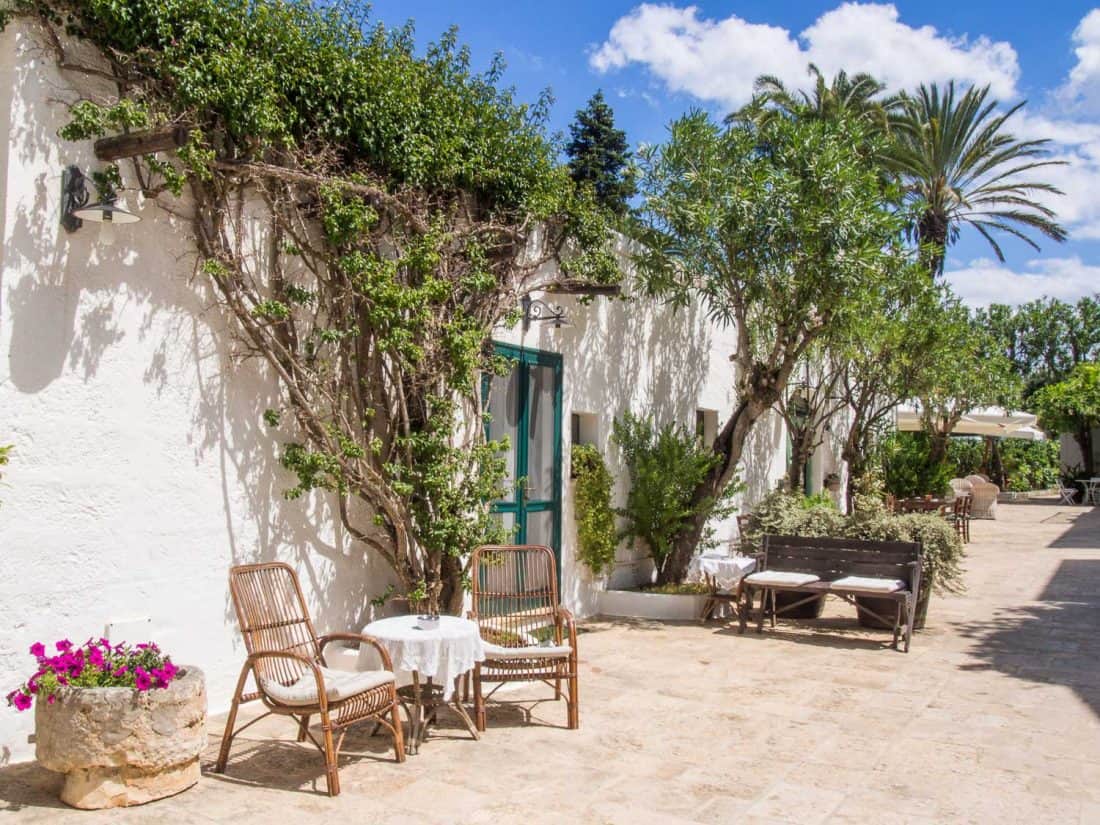
7 to 10 Days in Puglia
If you have a week or 10 days in Puglia, I recommend dividing your time between the Valle d’Itria and the Salento.
You can easily visit Bari and the coastal towns from the Valle d’Itria, or if you’d prefer to stay on the coast, you can visit the Valle d’Itria from Polignano or Monopoli.
My ideal trip is a countryside stay in the Valle D’Itria (somewhere near any of the places listed below) with mornings spent day-tripping to other towns and afternoons relaxing by the pool or the beach near Ostuni.
Lecce old town is my favourite base on the Salento peninsula as it’s gorgeous, central for both coasts, and you can walk to lots of fantastic restaurants and wine bars.
If you’d rather be by the sea in the Salento, consider Otranto or Gallipoli or for a quieter town, Castro.
Or again, pick somewhere at random based on accommodation—a few times we’ve stayed in small towns near Gallipoli because we found an affordable rental, and it worked out great.
If you prefer just one base for your whole trip, you could take a day trip to the other area, but you’ll spend more time driving. From Ostuni, it’s an hour to Lecce and 1.5 hours to Otranto.
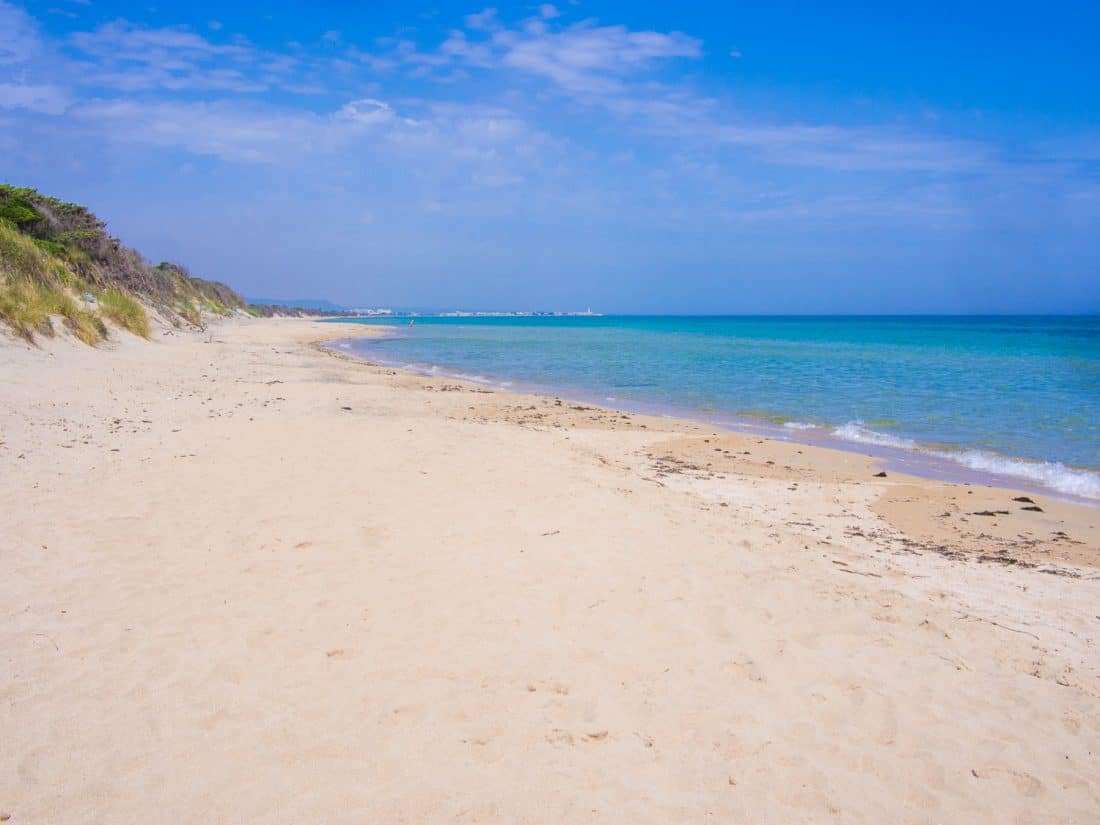
10 Days or More in Puglia
With a longer stay in Puglia, you have the option of adding on a trip to the Gargano Peninsula in the north or spectacular Matera in neighbouring Basilicata.
Puglia Accommodation
There’s a wide range of characterful accommodation in Puglia, mainly B&Bs and self-catering apartments or houses.
Masserie are fortified farmhouses that offer guest accommodation and often delicious meals—read our guide to Puglia masseria for our favourites.
For short stays, I use Booking.com to find accommodation. I use the filters to select my criteria (including review scores of 8+) and narrow down the options. You can choose “Farm Stays” under Property Type to find masserie.
For longer stays, you can get great deals for rental houses and apartments on Vrbo.
Unless you are staying in the countryside, I recommend looking for accommodation in the old town or historic centre.
All these Puglian towns have modern outskirts which are less attractive, although if you are on a budget, it’ll be cheaper (and parking easier).
Puglia Transport
How to Get to Puglia by Plane
You can fly into Bari or Brindisi airports in Puglia—I use Kiwi to find the best flight deals. Bari is usually cheaper.
Either airport works for the Valle d’Itria while Bari is closest to the Gargano and Brindisi is nearest to the Salento.
How to Get to Puglia by Train
If you are visiting somewhere else in Italy, you can also arrive by train—Bari and Lecce are the main hubs. Rome to Bari takes 4 hours, and Rome to Lecce is 5.5 hours.
You can search Trenitalia for timetables and to book in advance for the cheapest tickets. Be sure to use Italian place names (i.e Torino not Turin).
On a longer trip, you could consider travelling from London to Italy by train or get an Interrail or Eurail pass to visit multiple destinations in Europe.
Renting a Car
Renting a car is by far the best way to get around Puglia. It is possible by train or bus, but public transport is slow and limited.
We use Booking.com Car Rentals and Kayak to find the best car rental deals.
We usually rent from Bari airport or the city centre, but Brindisi airport has rentals too.
One-way fees can be reasonable, so on one trip we rented a car in Lecce (after arriving by train), road-tripped north via the Valle d’Itria, dropped it off in Foggia after visiting the Gargano, and took the train to Rome.
For Brits, we recommend buying a separate car hire insurance policy to cover the excess as it’s much cheaper than getting full insurance with the rental company.
Driving in Puglia is fairly easy, but the narrow streets of the historic centres can be a challenge. Look out for ZTLs, zones where traffic is limited to local residents.
I recommend renting a small car, parking in the modern outskirts of towns (often free), and walking into the old town.
It’s best to carry coins for parking meters, as the credit card function often doesn’t work (or exist).
Public Transport
It is possible to explore Puglia by public transport, but you’ll need to research routes and check timetables in advance and have a lot of patience.
I recommend avoiding travelling on Sundays when services are even more limited.
Trenitalia is the national railway in Italy and their trains in Puglia will be faster and more reliable than the regional line FSE (Ferrovie Sud-Est).
You can find Trenitalia stations (from north to south) in Trani, Bari, Polignano a Mare, Monopoli, Cisternino, Ostuni, Brindisi, and Lecce. Note that some stations are quite far from the historic centre (Ostuni’s is a 30-minute walk).
The local FSE line connects Martina Franca to Locorotondo, Alberobello, Cisternino, Ceglie Messapica, and Lecce.
From Lecce there are direct trains to Gallipoli and Galatina, but you have to make two changes to get to Otranto and one change for Corigliano d’Otranto.
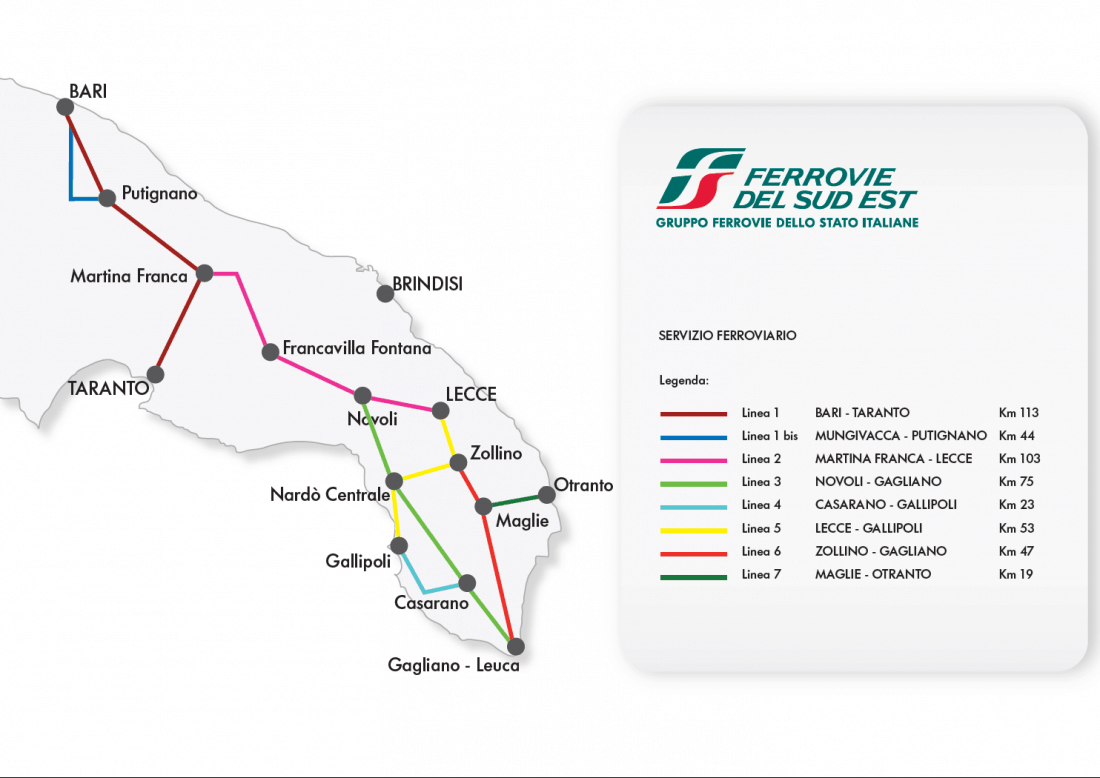
I recommend choosing a few potential bases (such as Polignano or Martina Franca and Lecce) and looking at train times and frequency to the places you’d like to visit.
You can see timetables on the Trenitalia website which also shows the “Regionale FSE” trains, or you can check the FSE website directly (no English option though).
There are also buses, but it’s not easy to find out the routes and timetables. There are more services in the summer.
Here’s a trip report on travelling Puglia by train to give you some ideas.
When to Visit Puglia
June and September are the best months to visit Puglia for hot weather and smaller crowds.
July and August are by far the busiest months—it will be hot, sunny and lively but crowded (especially the beaches) and accommodation is more expensive.
We survived August in the Salento (the absolute busiest time) by going to the beach early and exploring the much quieter inland towns.
It can be warm enough for swimming in May and October too, and it’ll be even less crowded.
On our two-week road trip in May, we had two days of rain, a few cloudy afternoons, and the rest was hot and sunny in the mid-20s Celsius, and we were swimming and sunbathing.
We found April and May a great time for sightseeing as it wasn’t too hot.
If you aren’t bothered about lazing on beaches, then winter is a quiet and inexpensive time to explore Puglia’s towns. Just note that many hotels and restaurants in coastal towns will close for the low season.
Puglia Italy Map
This Puglia map shows our favourite Puglia destinations divided by the four main areas. The blue pins are for Bari and the coast, red for the Valle d’Itria, green for the Salento, and purple for the Gargano.
I’ve also added Matera (in orange) even though it’s in the neighbouring region of Basilicata as it’s worth adding to a Puglia itinerary.
Best Places to Visit in Puglia: Bari & The Coast
Bari is the main gateway to Puglia. It’s worth spending a day in the city, so you could either spend your first night there or day trip in from one of the nearby pretty coastal towns.
1) Bari
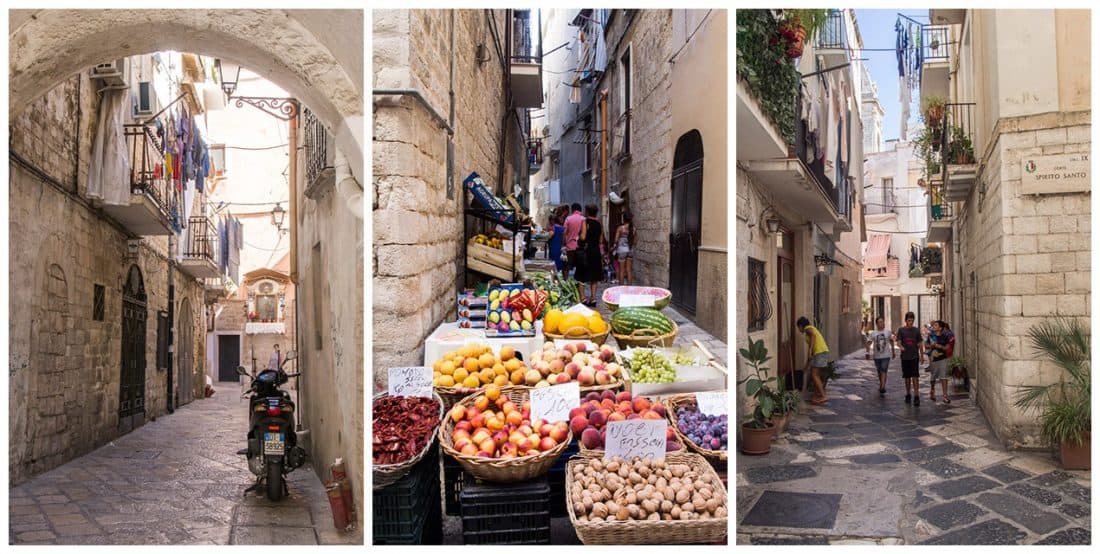
Bari used to be dismissed as just a transport hub (including by us on our first trip to Puglia), but it has grown in popularity in recent years, and we’ve come to love the atmospheric, maze-like old town.
While a day is enough to see the main sights, we liked it so much that we spent three days there on our latest trip. See our picks for the best things to do in Bari.
Bari Vecchia is a walled city crowded on a peninsula jutting into the sea. There was no room for expansion and the resulting overcrowding has meant that life is lived on the streets.
As we wandered down the narrow alleyways on our first evening, we felt like we were walking through someone’s living room, or well, everyone’s living room.
Entire families from grandparents to babies sat outside their homes chatting, playing, napping, while washing dangled from balconies and scooters whizzed past.
It’s not just relaxing and socialising that takes place in the streets. In the mornings they become a pasta factory as women sit at tables outside their homes making the typical Puglian pasta orecchiette.
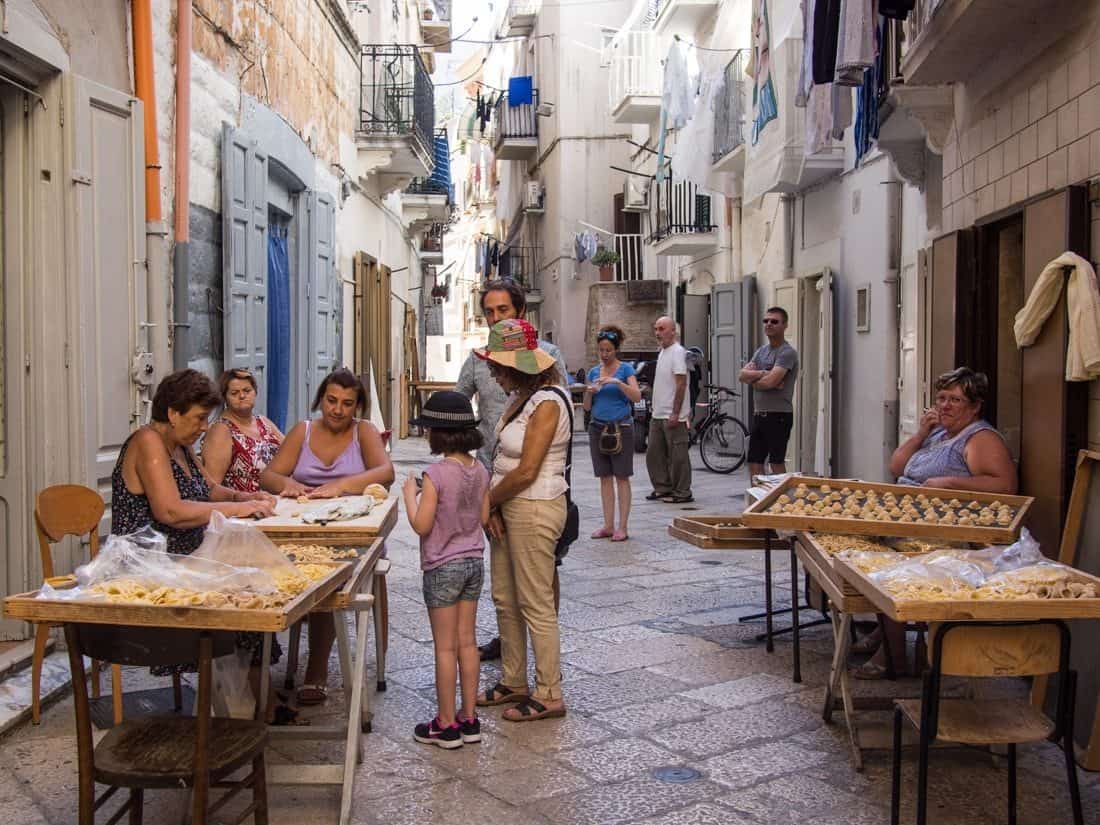
These “little ears” are made by rolling the dough into thin logs, cutting off a chunk with a knife and shaping it by hand—all at an impressively rapid pace.
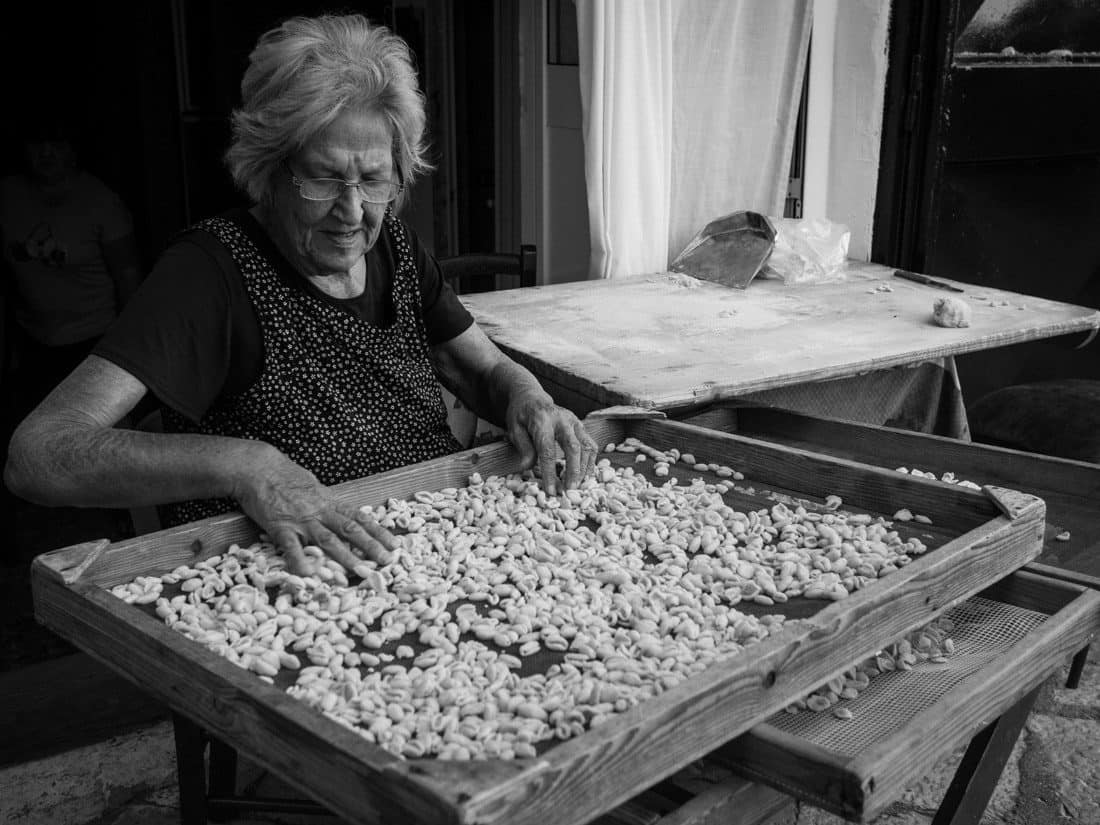
Where to Stay in Bari
Bari Vecchia is definitely the most charming part of the city to stay.
We loved our stay at friendly B&B Murex, which has four modern ensuite rooms on the iconic pasta street. Breakfast (including delicious fresh focaccia) is served on the roof terrace.
Another B&B that looks great is La Muraglia, which has lovely apartments with sea views in the old town.
You can find more hotels, B&Bs and apartments in Bari here.
Where to Eat in Bari
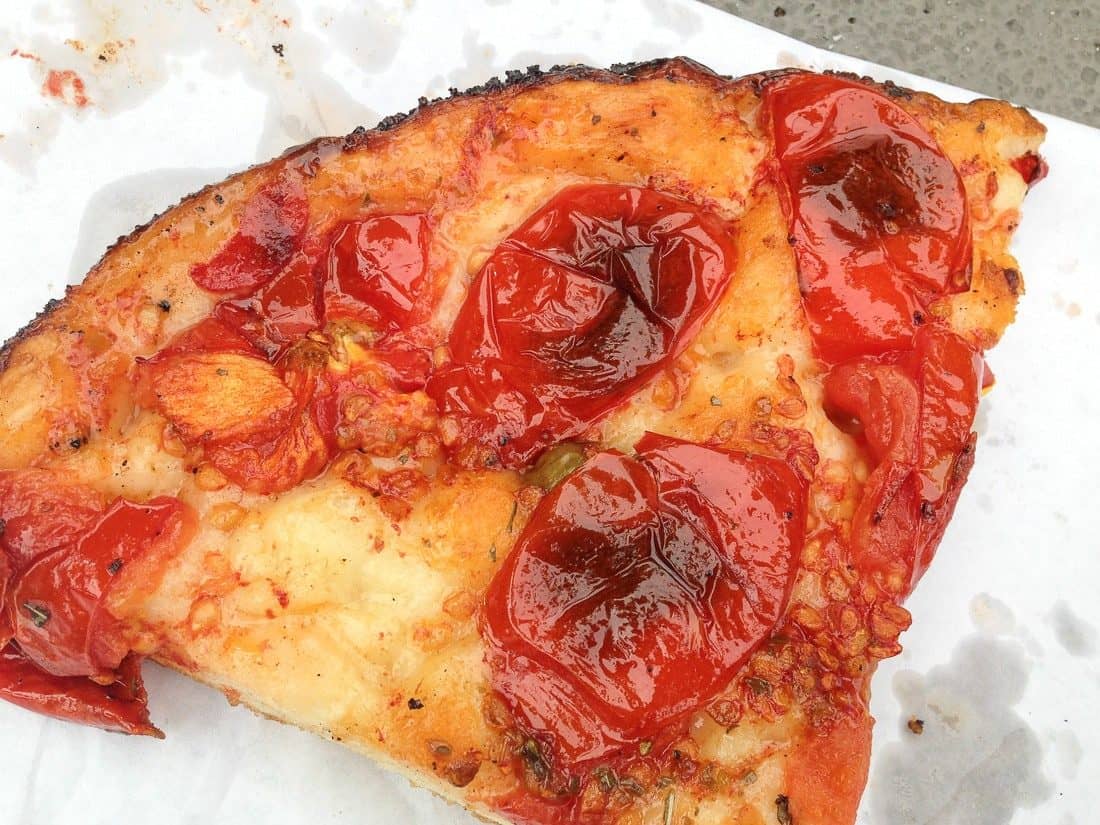
Don’t miss the amazing focaccia at Panificio Fiore or Panificio Santa Rita in the old town. It’s perfect for breakfast, a quick snack, or light lunch.
Our favourite place to eat in the evenings is casual Pizzeria di Cosimo for wonderful, inexpensive pizza and panzerotto.
Our meal at La Cecchina was also delicious, especially the antipasti.
Our Bari Italy travel guide has more suggestions.
2) Polignano a Mare
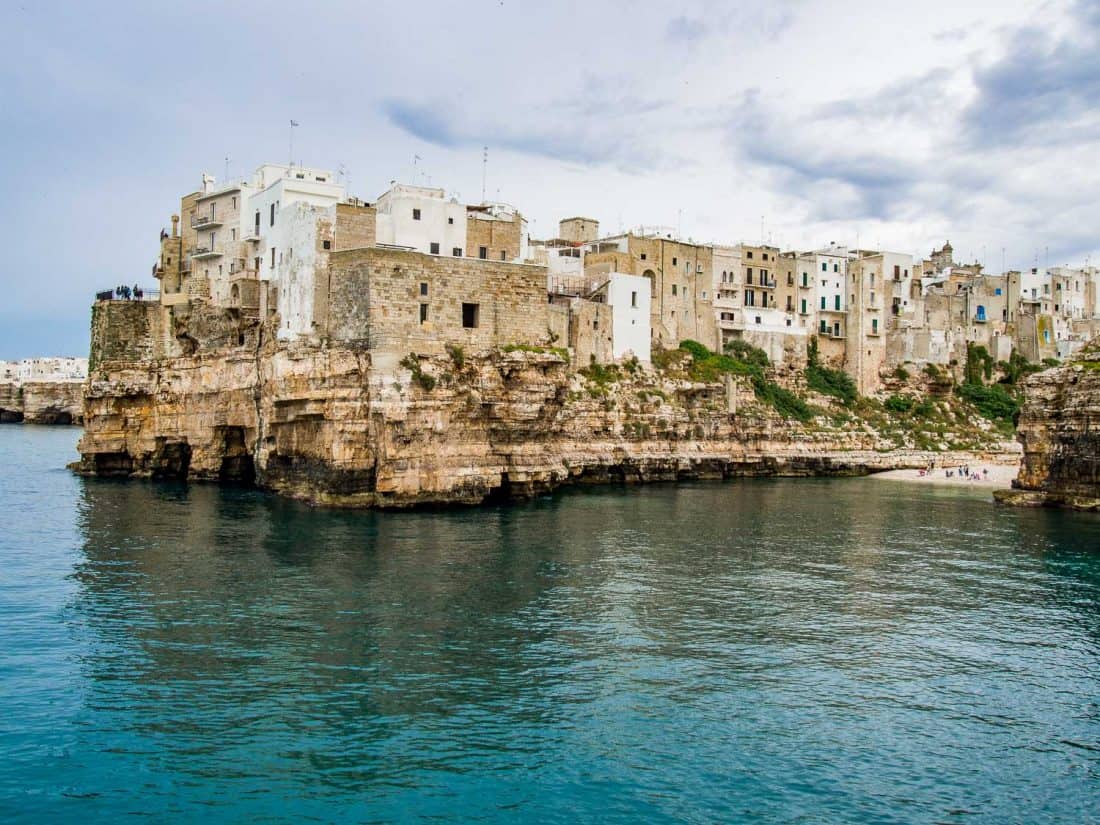
Polignano a Mare is a spectacularly positioned small town of white and golden buildings perched on a craggy rock overlooking the sea.
The pretty historic centre is a lovely place for a wander or an aperitivo on one of the small piazzas.
Beneath the old town is Cala Porto, a small white pebble beach surrounded by cliffs with clear emerald water.
It’s very photogenic but gets crowded in high season. It’s also known as Lama Monachile for the bridge that you must walk over to reach it.
I enjoyed runs and walks along the coast with many viewpoints on the way to Piazzale Marco Polo.
Polignano is near enough to the Valle d’Itria (30 minutes from Alberobello) to be a good base for exploring the area if you’d prefer to stay by the sea.
Where to Stay in Polignano a Mare
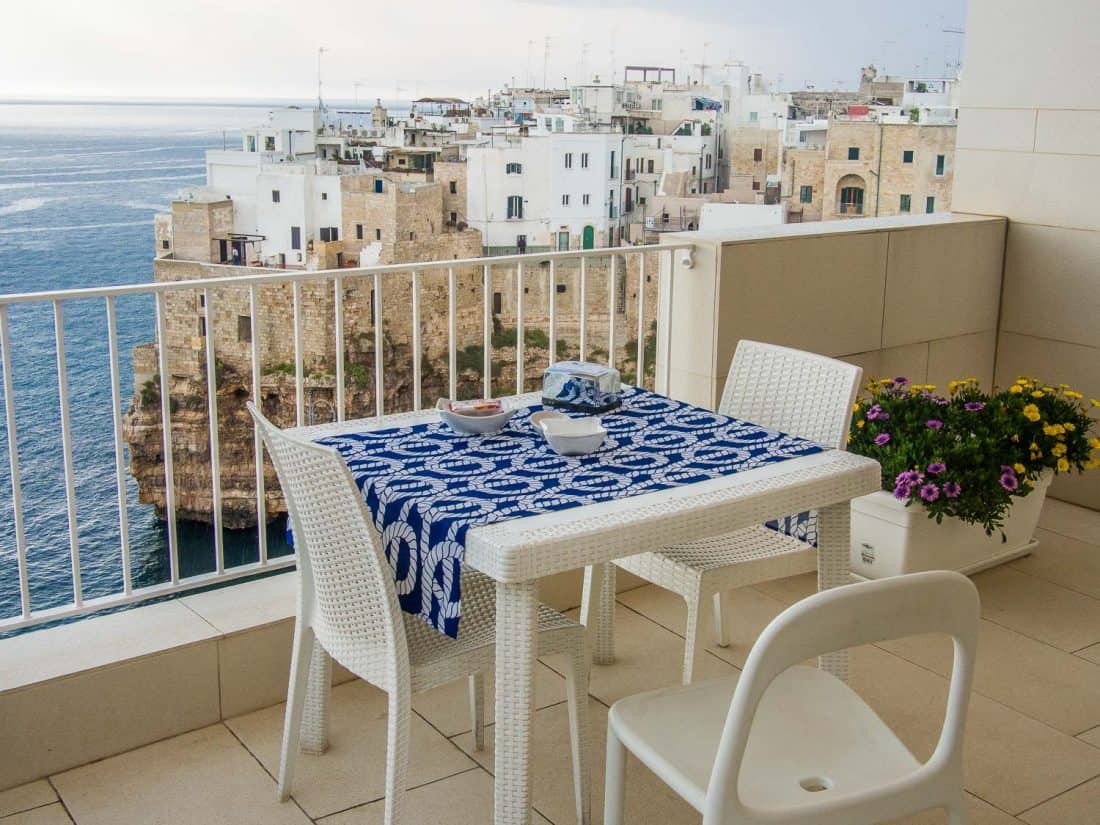
Malu B&B is the perfect place to stay in Polignano a Mare. It’s a friendly, family-run B&B with bright, modern rooms and an ideal location just outside the old town with fantastic views from the breakfast terrace and some rooms.
We splurged on the sea view suite and it was worth it.
The statue of Domenico Modugno, the famous singer who was born in Polignano, is just outside the hotel and we were amused to hear people singing Volare below.
If it’s booked up, Lamare Cucine e Dimore is another popular B&B with sea views.
You can find other places to stay in Polignano here.
Where to Eat in Polignano a Mare
The most famous restaurant in Polignano is Ristorante Grotta Palazzese which is located inside a cave. You’ll need to book in advance and be prepared to pay a lot more for the location than the quality of the food.
Most restaurants focus on seafood so vegetarian options are limited.
We ended up taking a break from Italian at Mint Cucina Fresca, a five-table restaurant in a cave-like room with a vaulted stone ceiling and quirky decor. Their focus is on creative, healthy dishes using local produce.
For a takeaway lunch on the beach, La Rotellina sells the Puglian snack panzerotti, fried dough stuffed with a variety of fillings.
Don’t miss a scoop of gelato at Gusto Caruso—they make excellent classics like pistachio as well as more unusual flavours like a tasty ricotta toffee.
Super Mago del Gelo is famous for its Caffè Speciale, an espresso shot with cream, amaretto and lemon peel. It was delicious even for a non-coffee drinker.
3) Monopoli
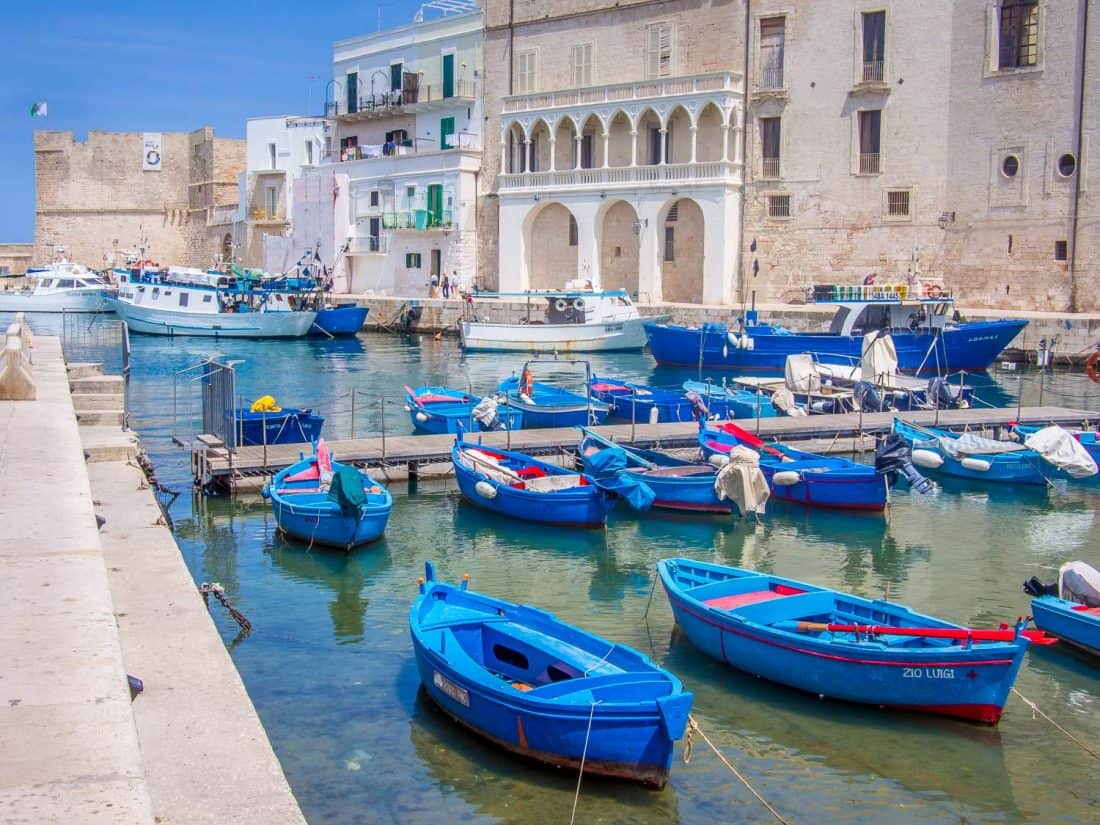
Monopoli is another pretty coastal town 15 minutes from Polignano.
The historic centre features a maze of narrow streets, a grand basilica, and a castle overlooking a picturesque fishing port of bright blue boats.
Monopoli also has a small sandy beach with appealing clear water.
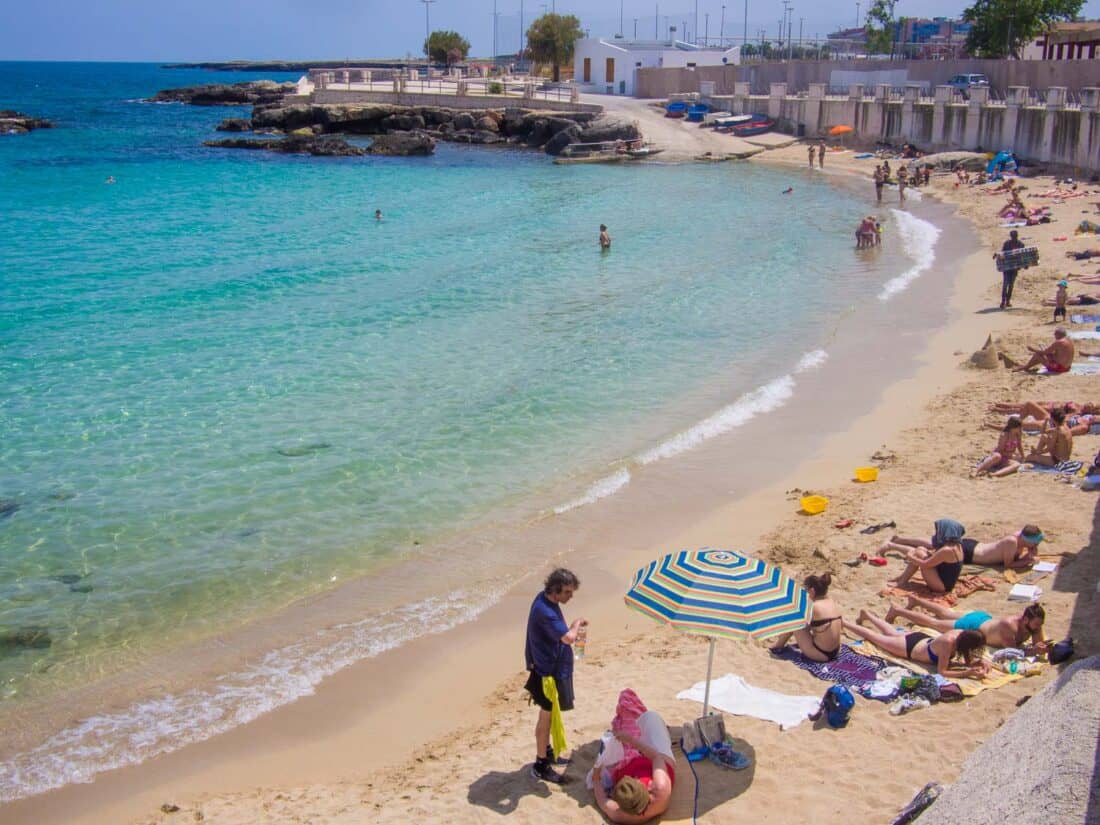
Where to Stay in Monopoli
We visited Monopoli while staying in Polignano, but next time I want to stay at Hotel Don Ferrante in the old fortress. The charming boutique hotel has stylish rooms, sea views, and even a small pool.
Where to Eat in Monopoli
Seafood dominates on the coast, so as vegetarians, we had lunch at Vini e Panini on Piazza Giuseppe Garibaldi.
As the name suggests, they focus on wine and sandwiches, although they also serve platters and salads. It’s ideal for a light meal, and they even have a vegan menu.
4) Trani
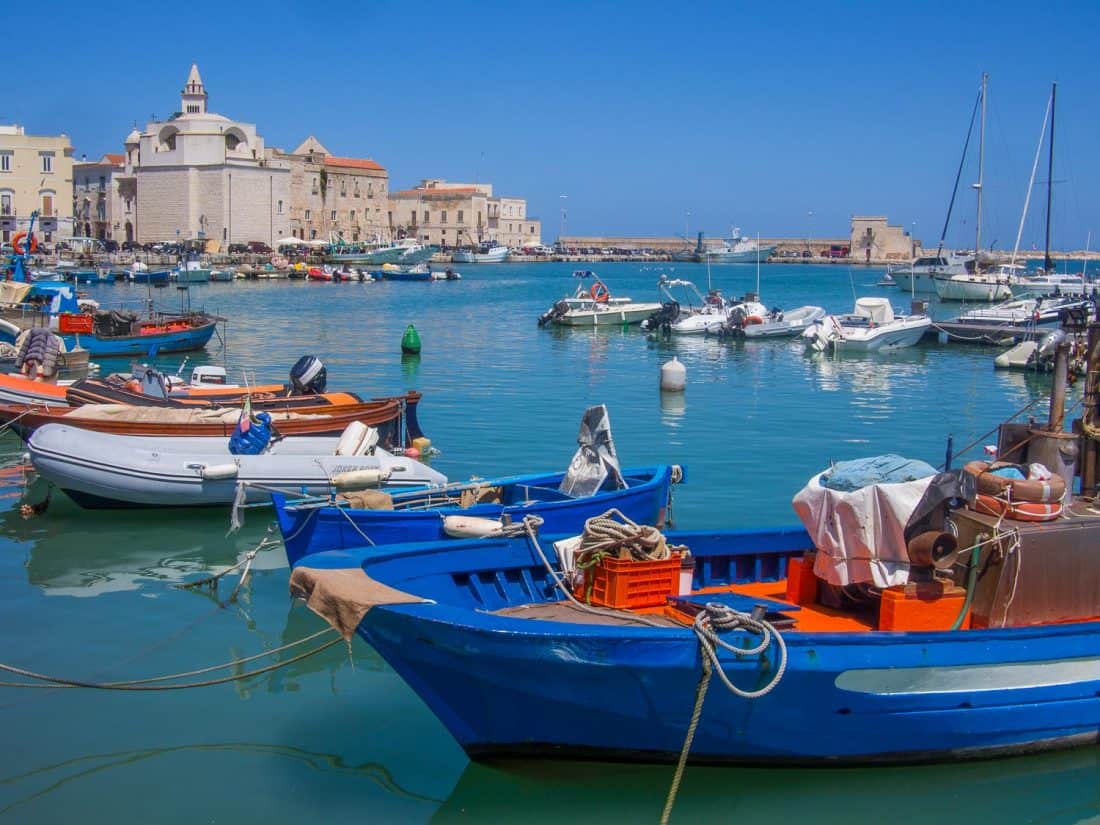
North of Bari, the seaside town of Trani is often overlooked, but it has a beautiful harbour and a cathedral overlooking the sea.
It’s a good place to break up a journey between the Valle d’Itria and the Gargano or to visit the 13th-century Castel del Monte (40 minutes inland) with its unique octagonal shape.
Best Places in Puglia: Valle d’Itria
The Valle d’Itria is a rustic valley of olive trees, vineyards, and hill towns.
It’s one of the most popular destinations in Puglia and is known for its iconic trulli, circular stone huts found dotted around the countryside.
If you only have time for one area in Puglia, this is the one I recommend.
It can easily be reached from Bari or Brindisi airports. Most of the towns here are tiny, and the distances between them aren’t long.
Choose one base (I like staying in the countryside) and take day trips to the other towns. You could manage two or three in one day if time is limited.
5) Ostuni
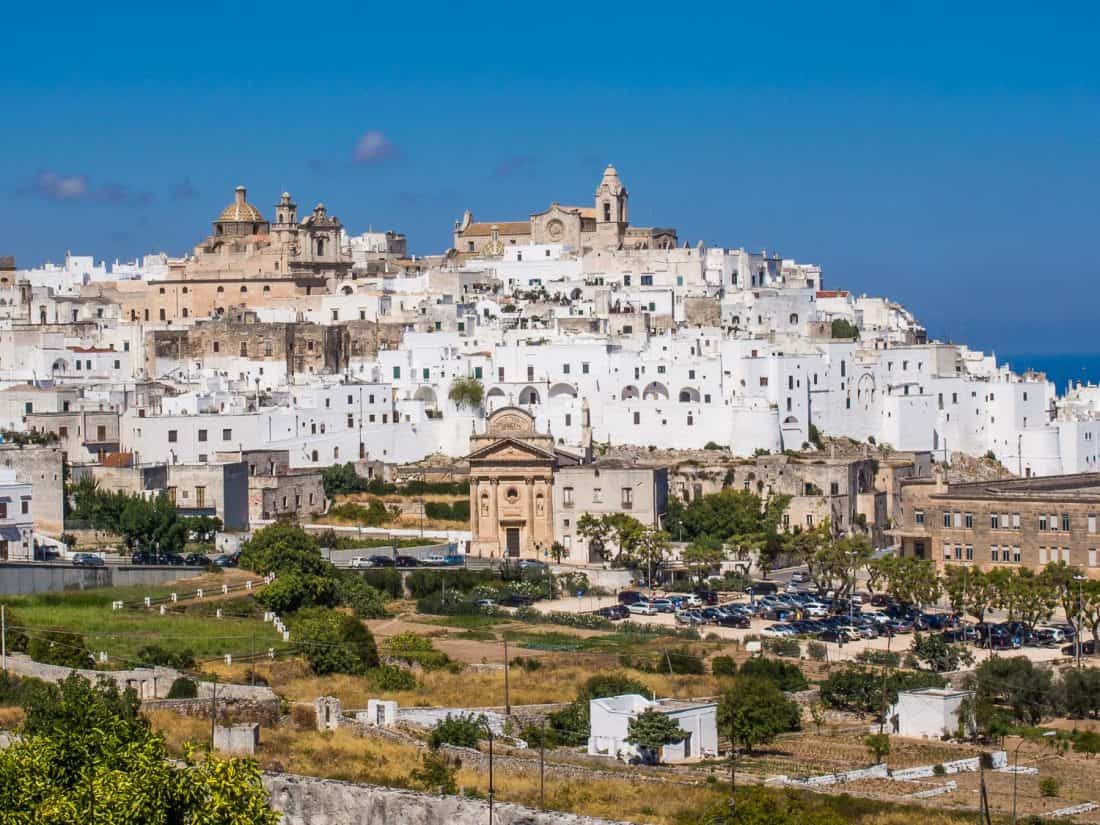
Ostuni is a maze-like white city on a hilltop 8km from the Adriatic Sea where you’ll find long sandy beaches.
It’s one of the best towns in Puglia to get lost wandering the alleys, climbing staircases, and dipping under archways.
I also love browsing the stalls of local fruit and vegetables at the Saturday market.
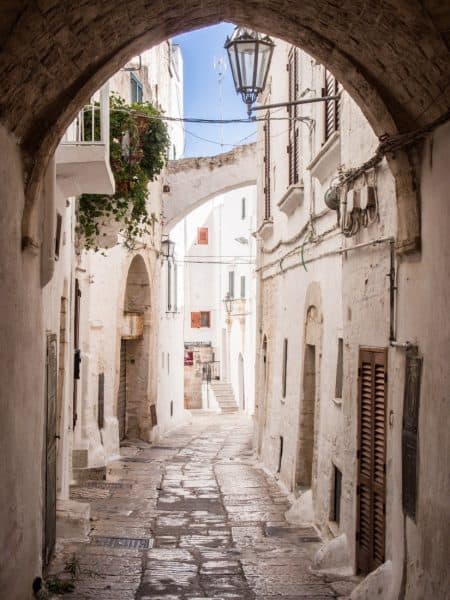
Ostuni is one of the most touristy towns in Puglia, but you won’t want to miss it—just head down a side street to avoid the crowds and souvenir shops.
See my guide to the best things to do in Ostuni Italy for more tips.
Where to Stay in Ostuni
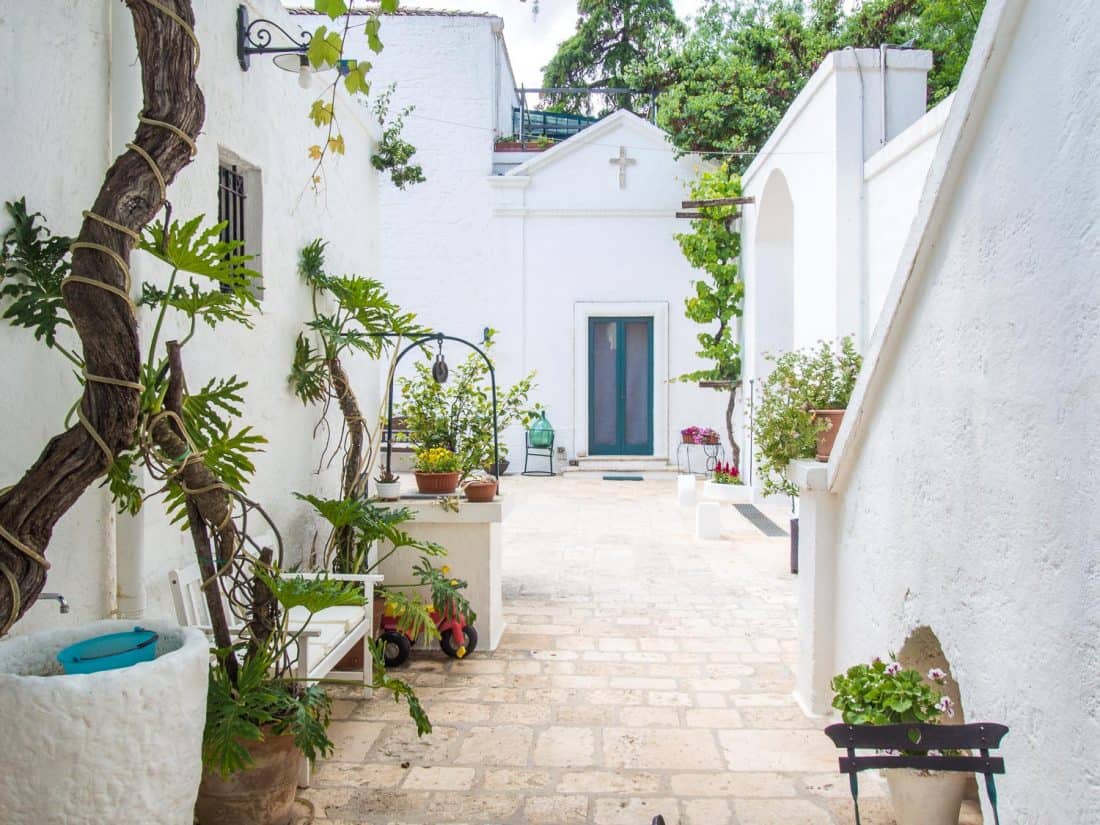
We absolutely love Masseria Il Frantoio, which is our favourite place to stay not only in Puglia but all of Italy!
It’s a magical place on an organic olive farm in the countryside a 10-minute drive from Ostuni and 15 minutes from the beach.
The 300-year-old stables and grain mill have been lovingly restored and converted to 16 comfortable guest rooms, and the beautiful grounds and pool are perfect for relaxing.
Best of all is the food (which all comes from the farm)—the eight-course tasting menu is incredible.
See our Masseria Il Frantoio review for more details or check the latest prices here.
If you want to stay in the centre of Ostuni, Biancadamari is a stylish B&B with stunning views of the old town and sea.
You can find more places to stay in Ostuni here.
Where to Eat in Ostuni
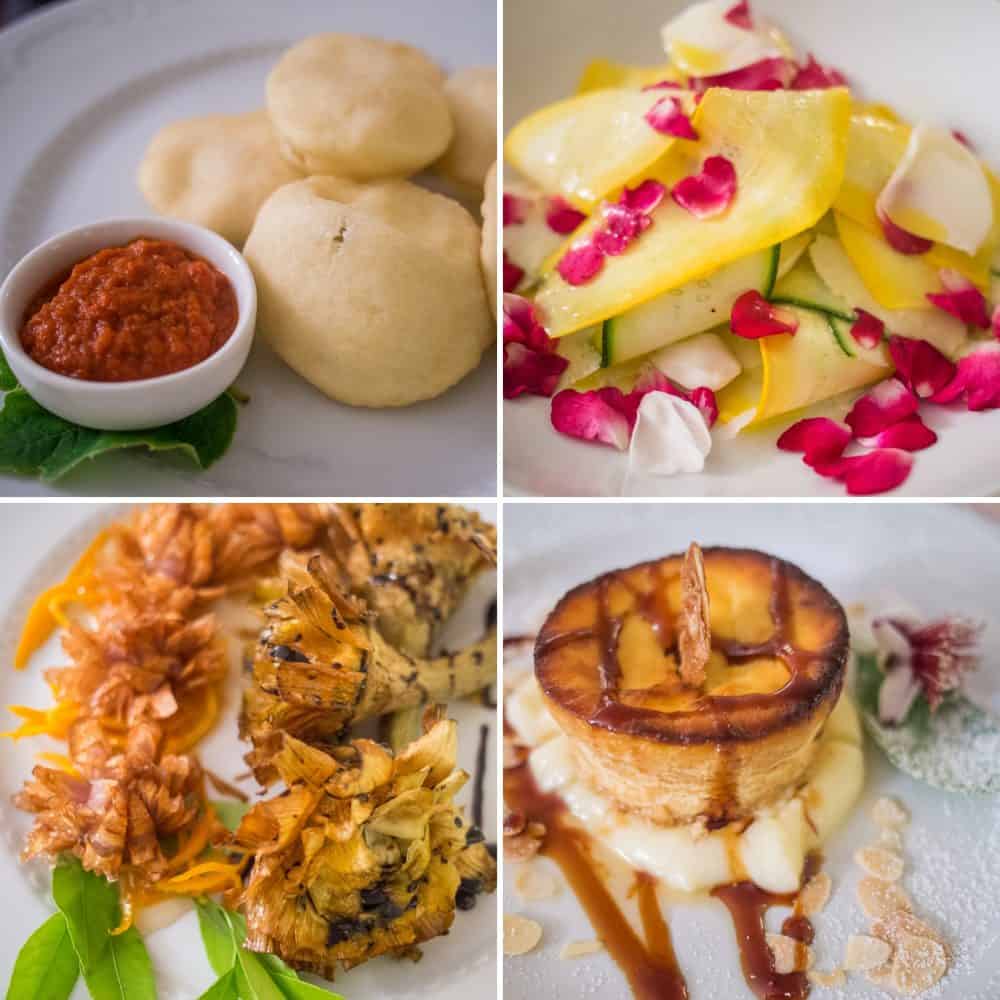
Masseria Il Frantoio is open to non-guests for their epic tasting menus, but you’ll want to take a taxi there to enjoy the wine pairing.
6) Alberobello
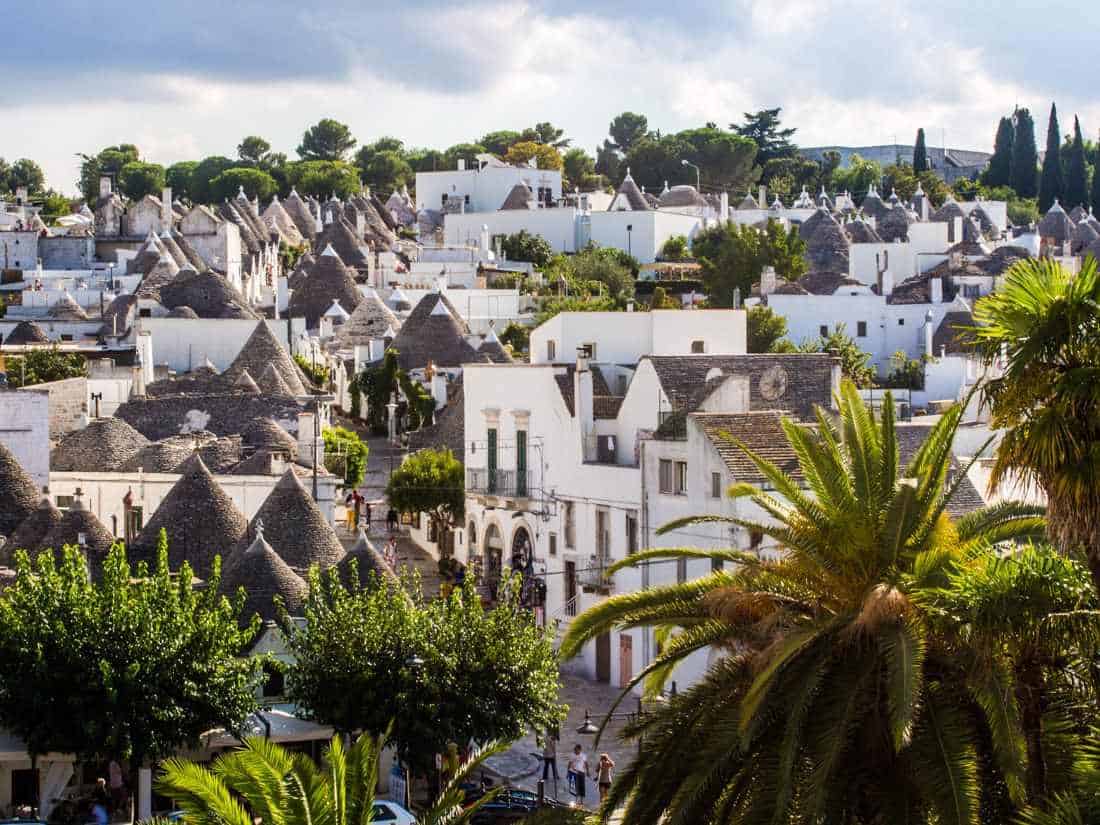
Alberobello is busy and touristy, but it’s such a unique and enchanting place (it’s not a UNESCO World Heritage site for nothing) that it’s worth a few hours.
It’s one of the best places in Puglia to see trulli. Trulli are conical stone huts found amongst the olive trees all over the Valle d’Itria. Alberobello is the only entire town of trulli—1500 of them.
You half expect to see a hobbit emerge from these stubby homes of whitewashed walls and pointy roofs stacked with grey limestone.
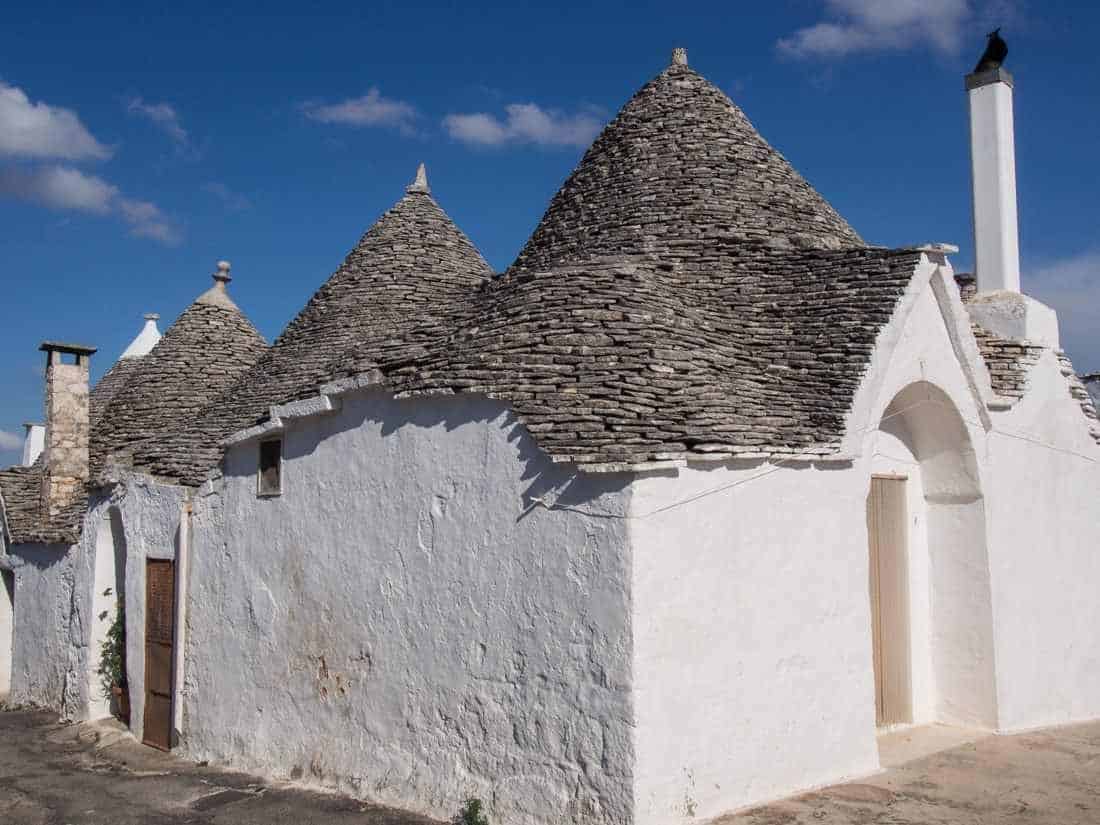
One side of town is full of tourists and souvenir shop trulli, but head across the road to Aia Piccola and you’ll find trulli that are real homes without the crowds.
See our trulli photo essay for more information and photos of these unusual dwellings.
Where to Stay in Alberobello
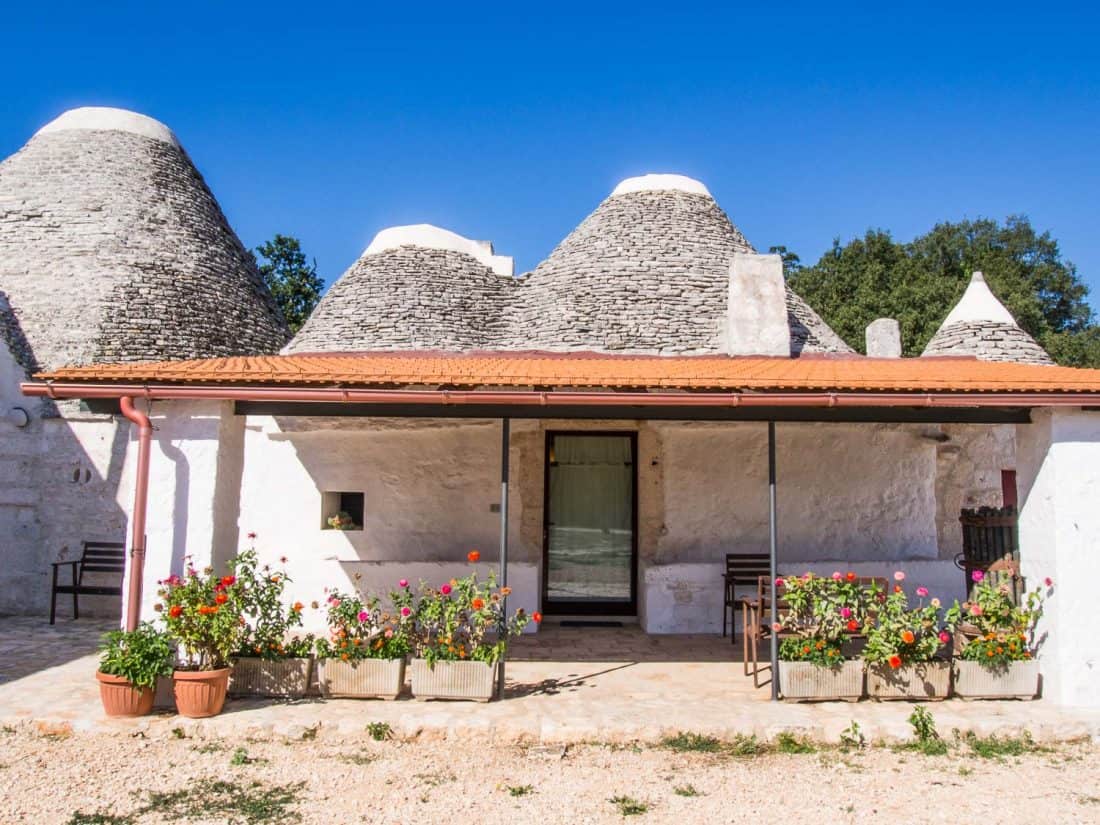
Staying in a trullo is a highlight of the Valle d’Itria. We stayed in one at Masseria Ferri near Martina Franca, a 25-minute drive from Alberobello.
Our cute trullo stayed wonderfully cool in the summer heat, the family that runs the place is very welcoming, and the food was superb.
We preferred staying in the countryside rather than in Alberobello itself, but you can find hotels in Alberobello here such as the highly-rated trulli of Tipico Resort.
Where to Eat in Alberobello
The antipasti at atmospheric cave restaurant Casa Nova were delicious.
7) Locorotondo
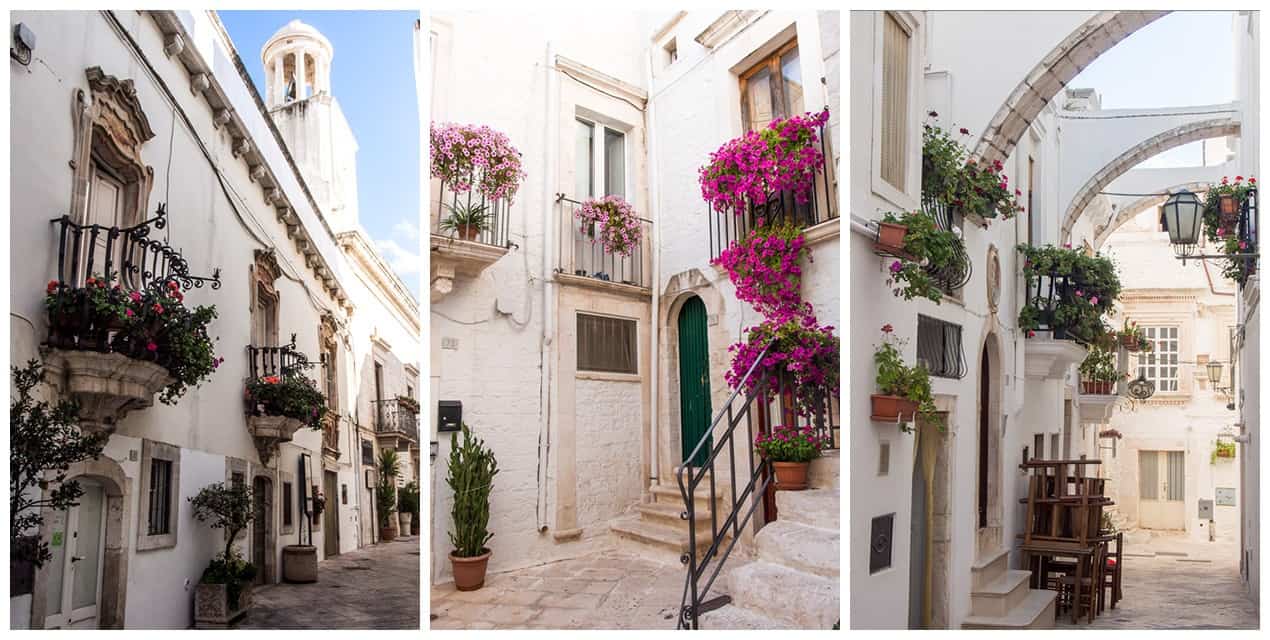
Locorotondo is a labyrinth of whitewashed buildings; its quiet streets kept pristine by residents who decorate their balconies and staircases with pink geraniums.
There are no major sights, but this means it doesn’t get many visitors, so it’s a delightful place to enjoy a leisurely lunch and stroll the streets.
Where to Stay in Locorotondo
We always visit on day trips, but Locorotondo is a lovely area to stay—you can find trulli and holiday homes in the area here.
8) Martina Franca
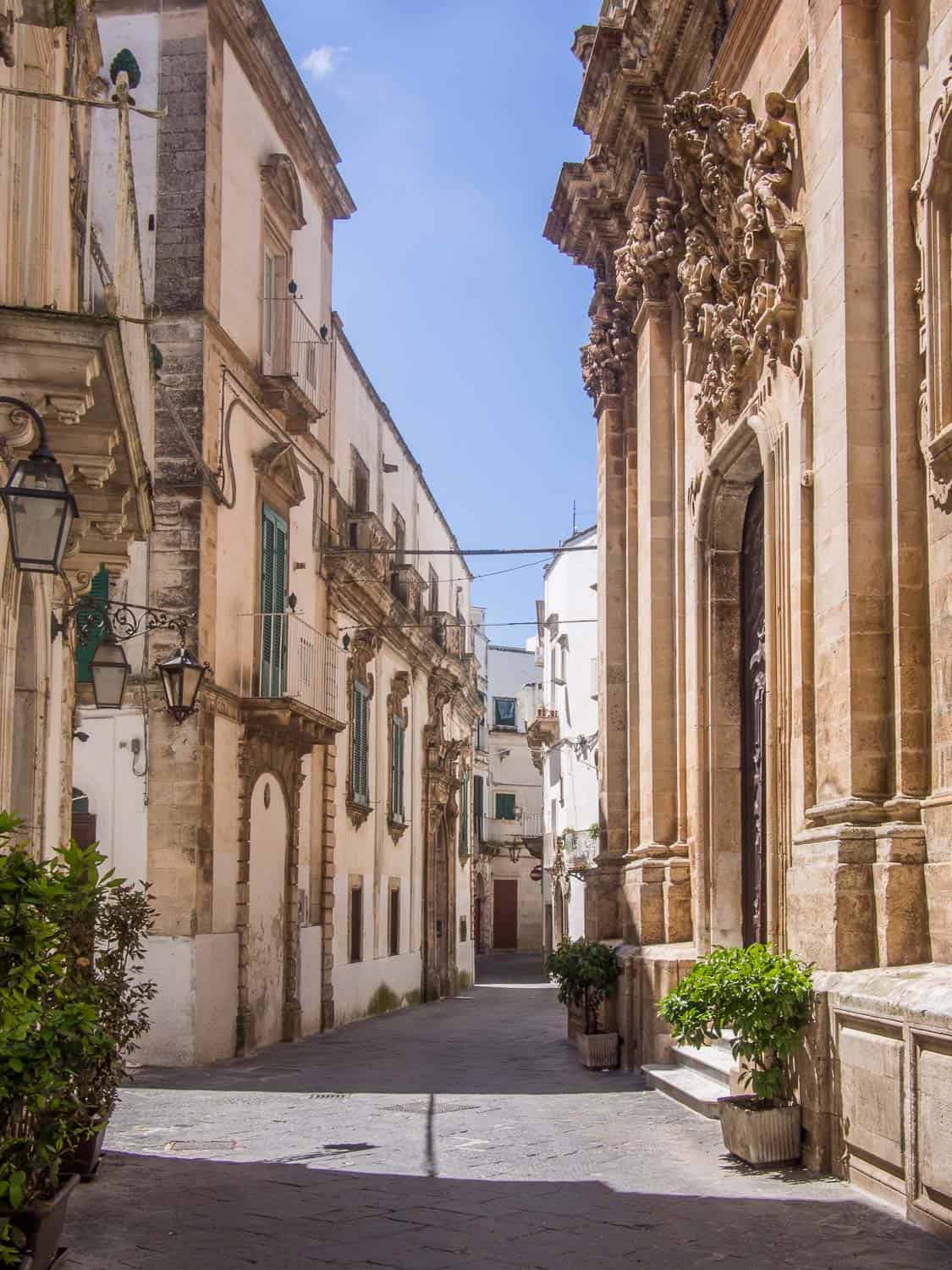
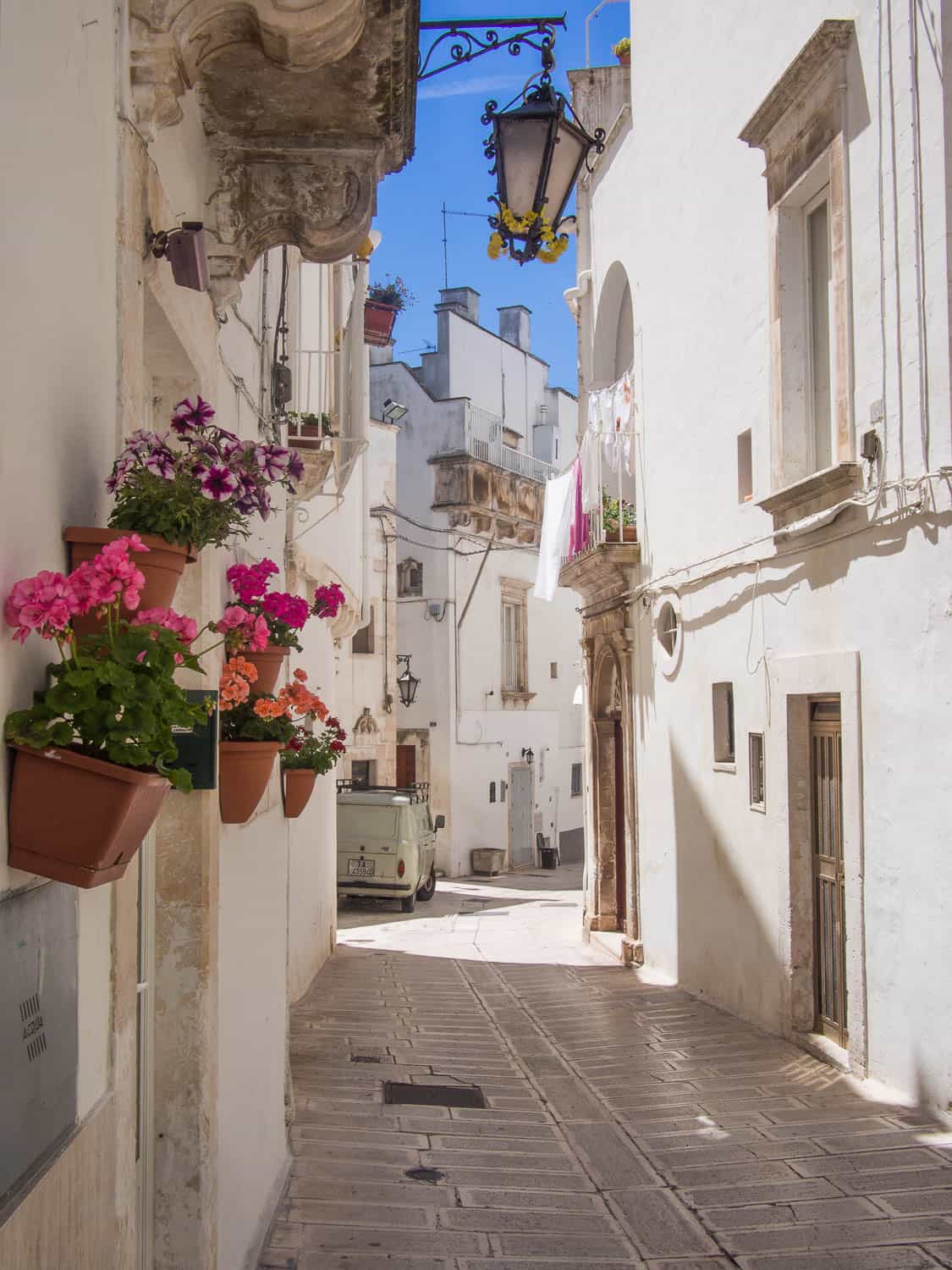
Lovely Martina Franca is the largest town in the valley. It’s often overlooked and is refreshingly free of tourist shops.
The old town is an interesting mix of golden baroque and Greek-like white architecture with many grand palazzi and churches.
The Basilica di San Martino was built in the 18th century in the elaborate but graceful Rococo style.
Nearby Piazza Maria Immacolata is a gorgeous, semi-circular piazza lined with curved baroque buildings with wrought iron balconies and portici (archways) leading down side streets.
The maze of narrow side streets is perfect for aimless wandering.
Many of the streets are stark white with just the odd splash of colour—washing dancing in the breeze, vibrant pots of geraniums, a vivid blue door.
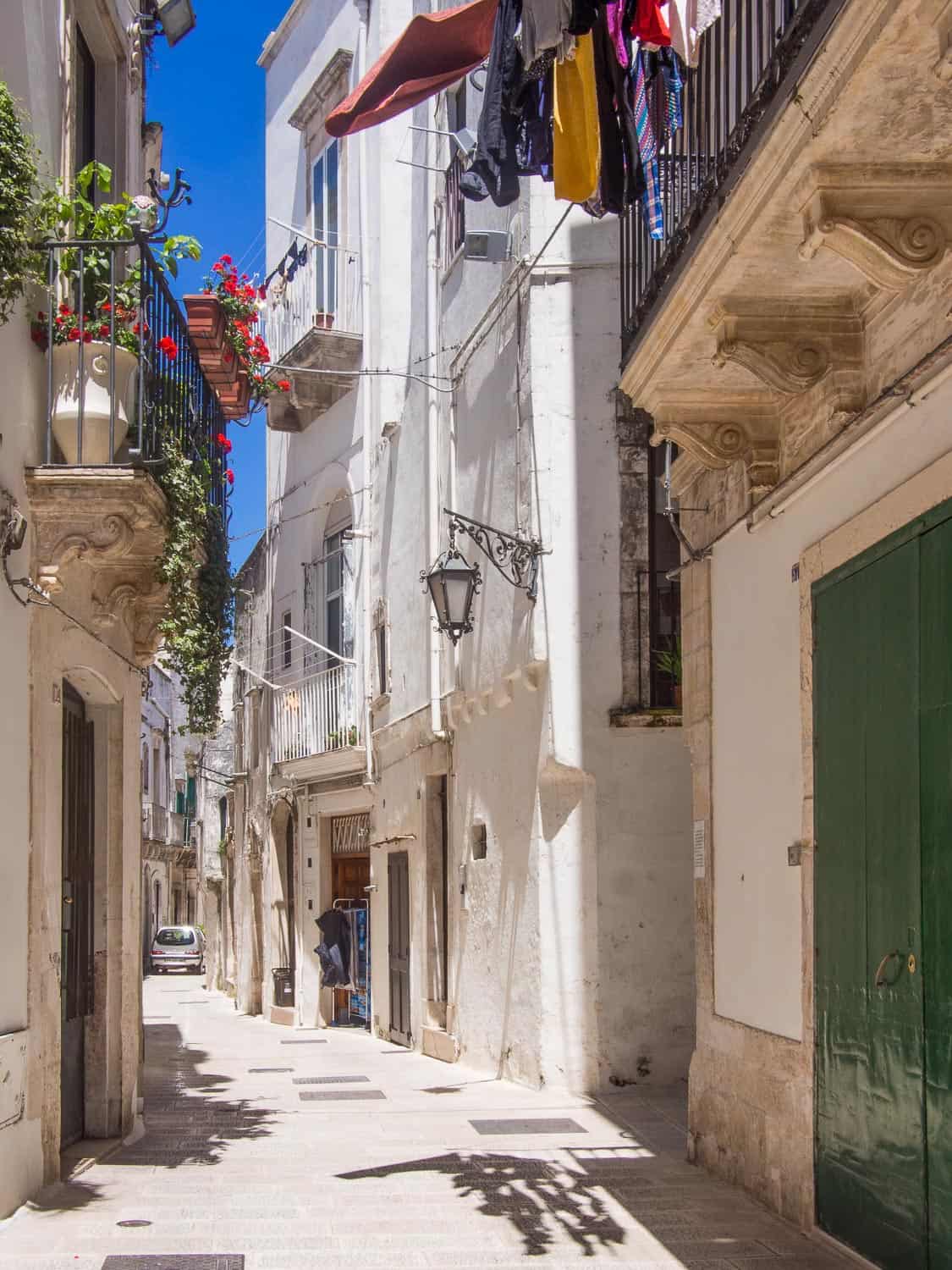
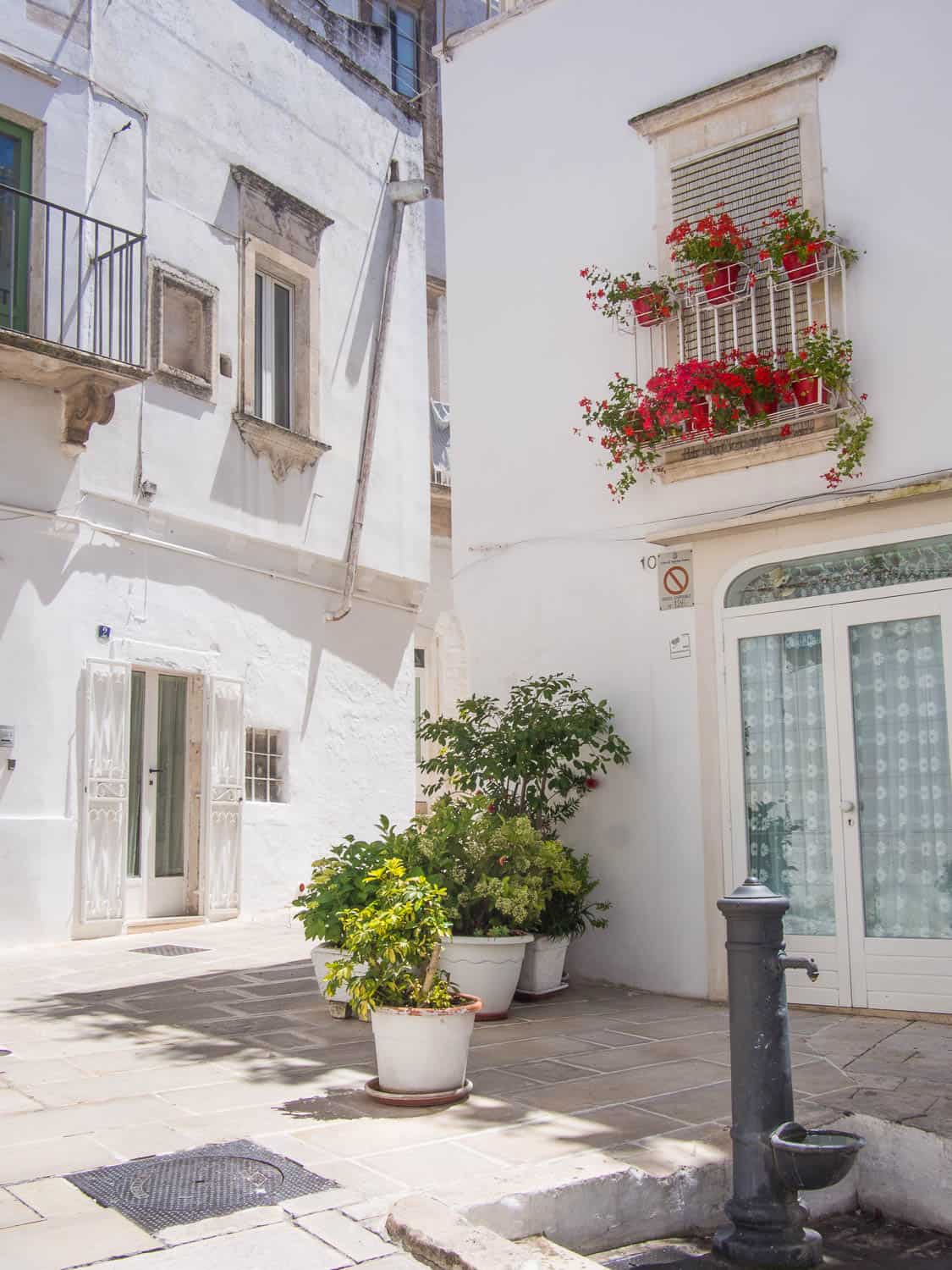
Where to Stay in Martina Franca
We visited on a day trip but would love to go back for a longer stay.
Martina Franca would make a great base for exploring the area if you don’t want to stay in the countryside or don’t have a car (there is a train station).
Options include holiday homes like Casa Dolce Casa.
You can search for more accommodation in Martina Franca here.
Where to Eat in Martina Franca
We ate at Ristorante I Templari on the edge of town with a terrace overlooking the countryside.
It’s rather pricey, but the food was excellent including an absurdly large antipasti selection (do not get one per person as they tried to convince us to do) and some interesting vegetarian pasta dishes.
9) Ceglie Messapica
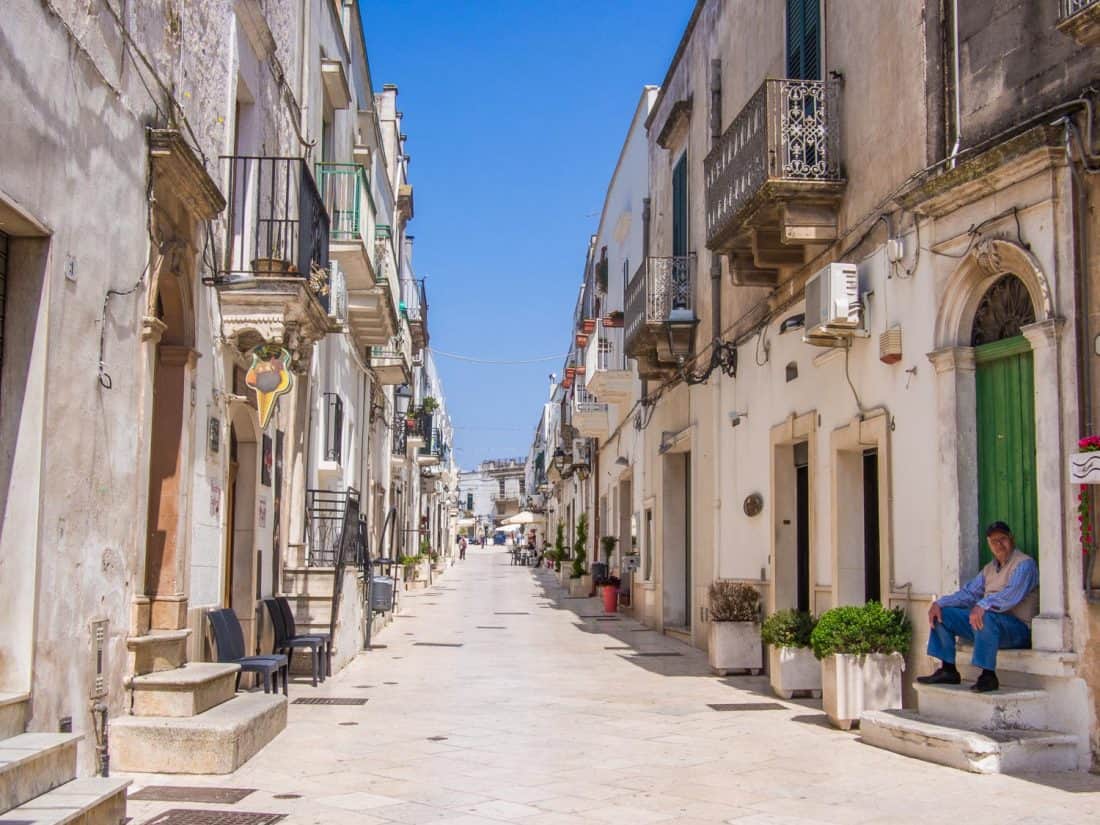
Ceglie Messapica is an off the beaten track town that makes an ideal base for exploring the Valle d’Itria.
The historic centre is a little grittier than the other towns on this list, but it has a very local feel that we enjoyed.
Surprisingly, it’s one of the best places to go in Puglia for food—the restaurants are excellent and affordable.
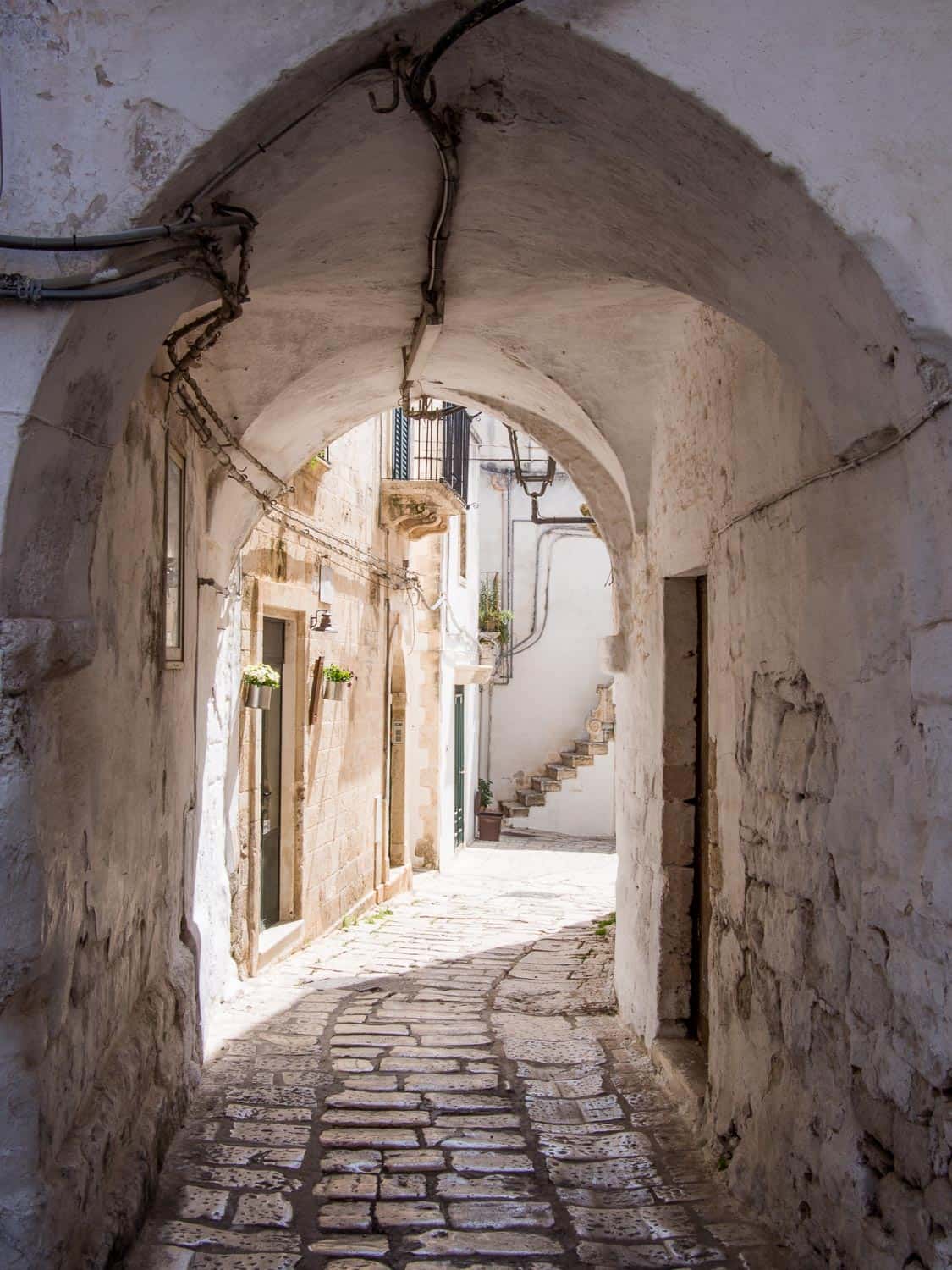
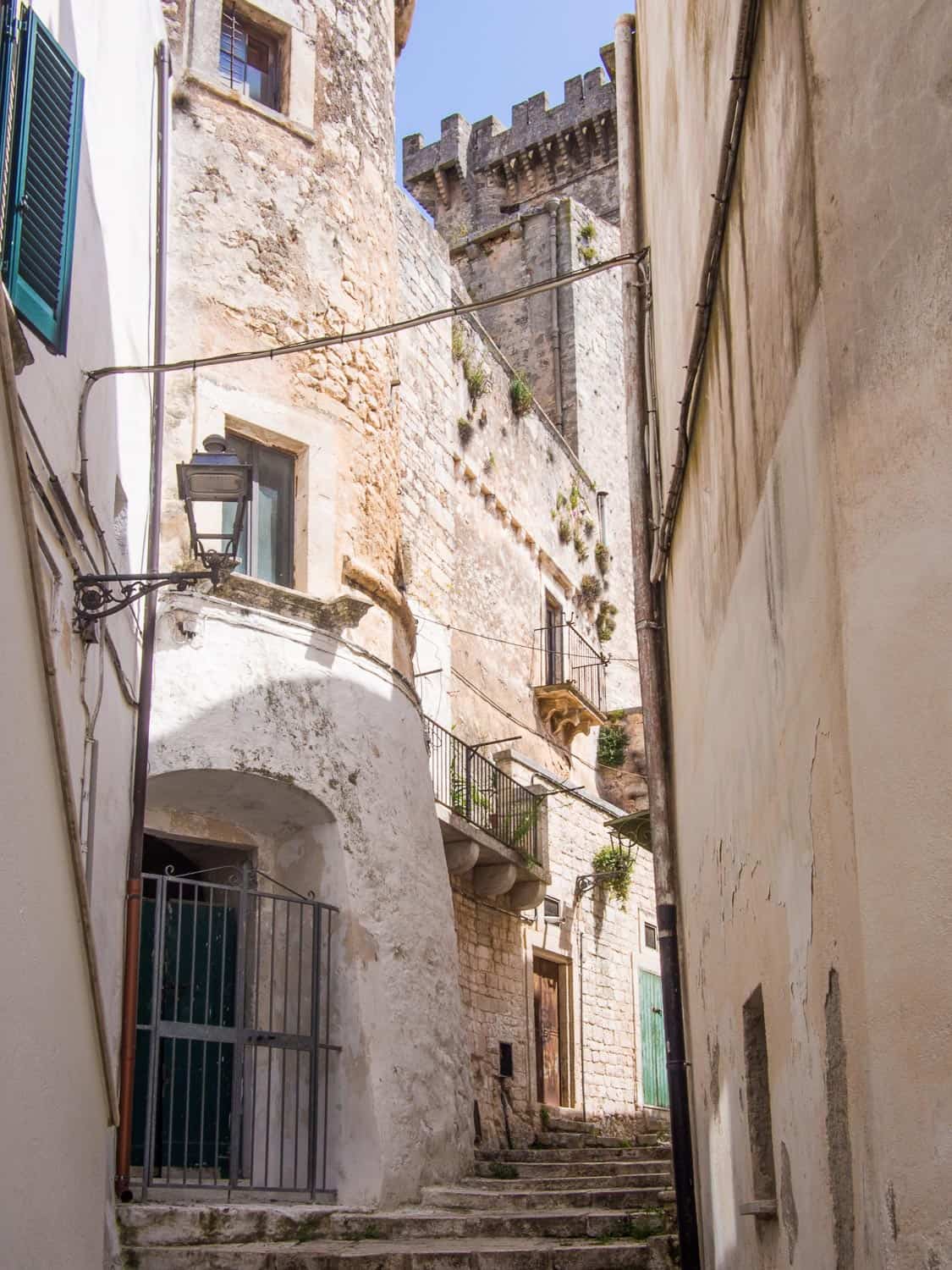
It’s worth having a look inside the castle—it’s free and is home to a library and a small art gallery. Beyond the castle, you can explore the atmospheric Moorish-style narrow lanes.
Where to Stay in Ceglie Messapica
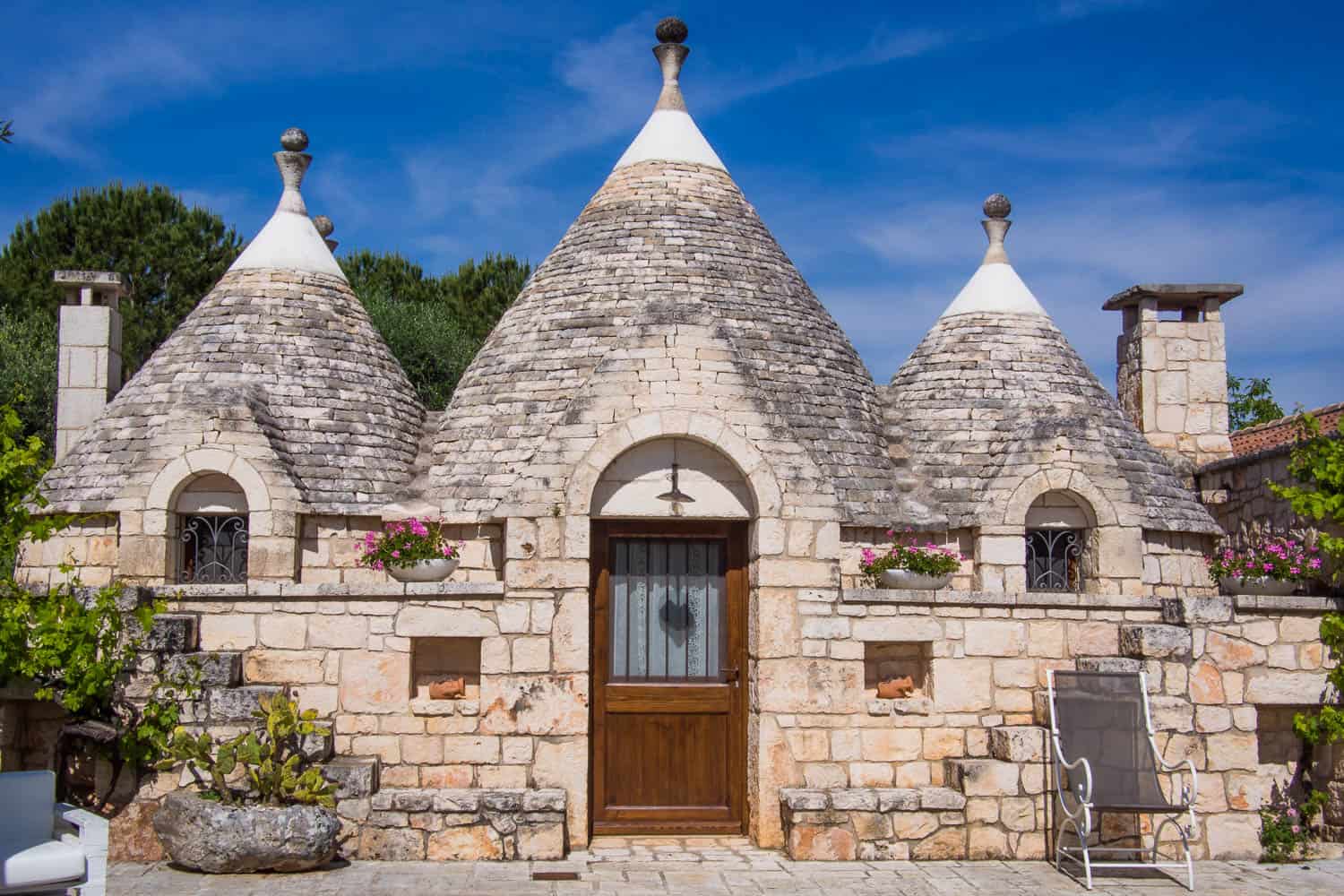
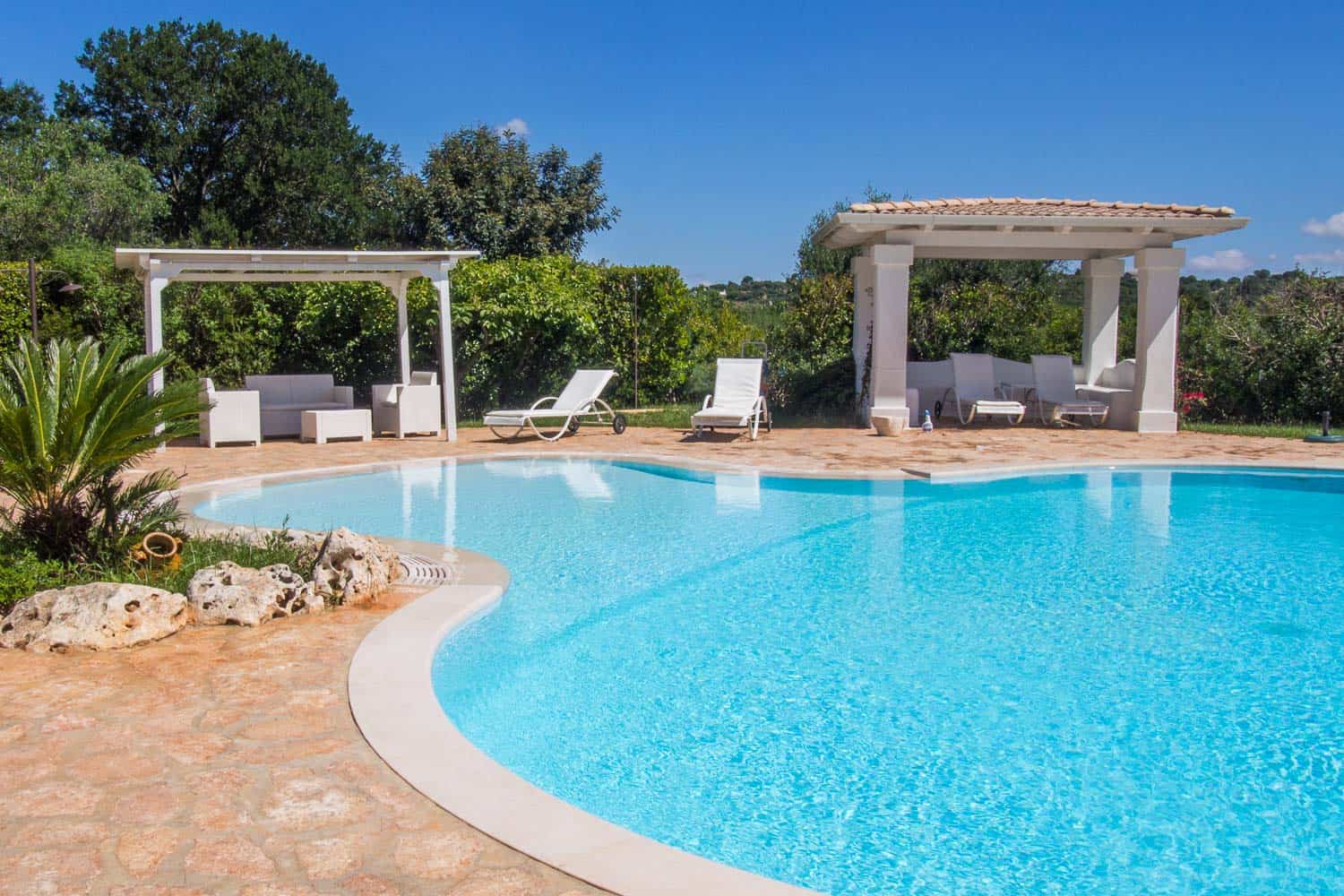
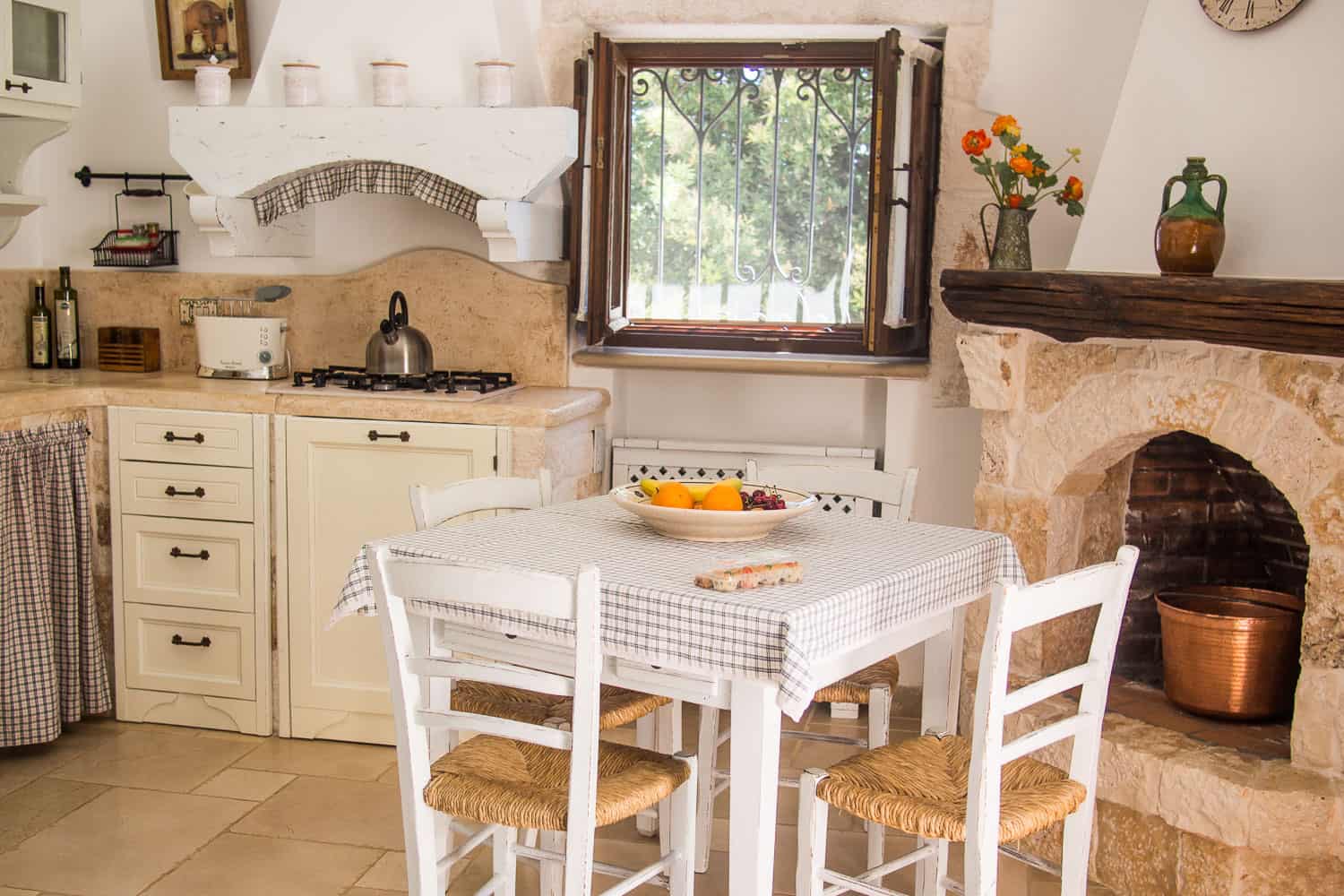
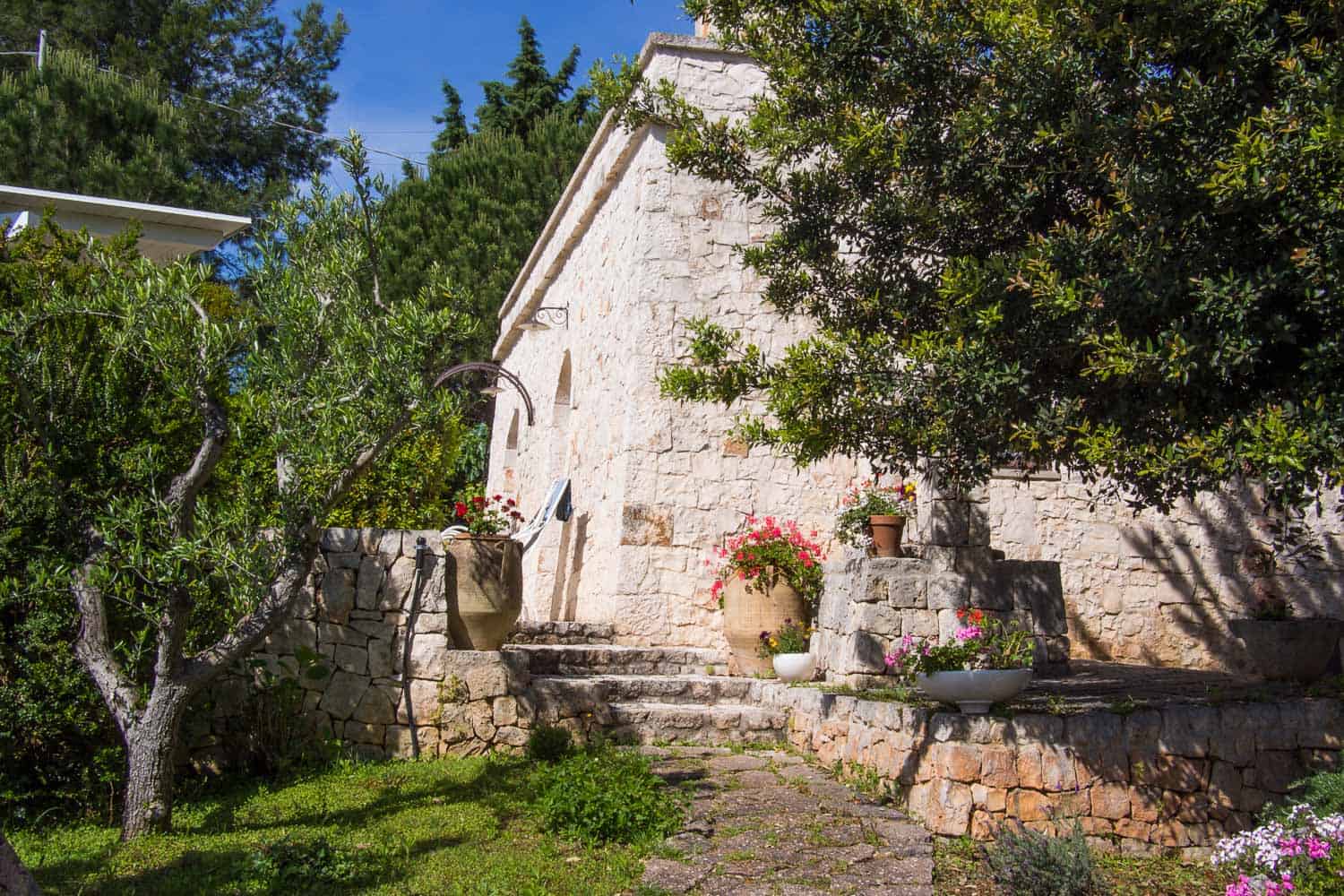
We loved our stay at Trullo Dei Messapi, a short drive from the town in a peaceful area of olive trees and trulli.
The beautiful grounds feature a large pool with comfortable sun loungers, a (non-heated) jacuzzi, and lots of flowers and pine, olive and fruit trees.
There are three houses—a two-bedroomed trulli and two one-bedroomed stone cottages.
Our one-bedroomed house was very cute and decorated in a rustic country style. The kitchen was stocked with DIY breakfast ingredients including homemade cake and fresh fruit which we ate on our private terrace.
The owner is very friendly and brought us fresh bread each morning.
I highly recommend it, and it would be especially wonderful for large groups.
Check the latest prices at Trullo dei Messapi here.
You can search for more accommodation in Ceglie here.
Where to Eat in Ceglie Messapica
You are spoilt for choice in this small town. Osteria Pugliese is a simple, rustic place that’s extremely good value and the antipasti selection is huge and delicious.
Cibus is more upmarket and expensive with some creative vegetarian options.
Da Gino is on the edge of town in a modern building and specialises in foraged vegetables. We didn’t use their menu—Gino just asked if we wanted antipasti, and of course, we did, and they brought us 13 delicious dishes.
We ordered our pasta after we’d finished and they were happy to split one portion between two bowls—we tried spaghetti with a local flower picked from nearby.
Don’t miss the local speciality, Biscotti di Ceglie, almond cookies stuffed with jam that are Slow Food certified. Forno San Lorenzo is a good local bakery.
10) Cisternino
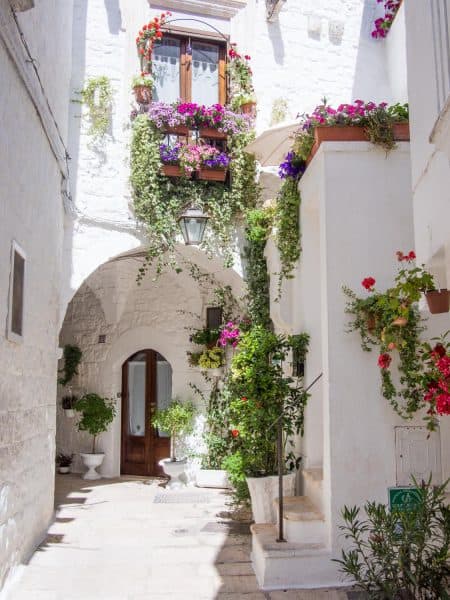
Cisternino is 10 minutes from Locorotondo and has a similar feel with a tiny, charming historic centre of whitewashed houses up on a hill.
There are views of the surrounding countryside from Villa Comunale.
Where to Eat in Cisternino
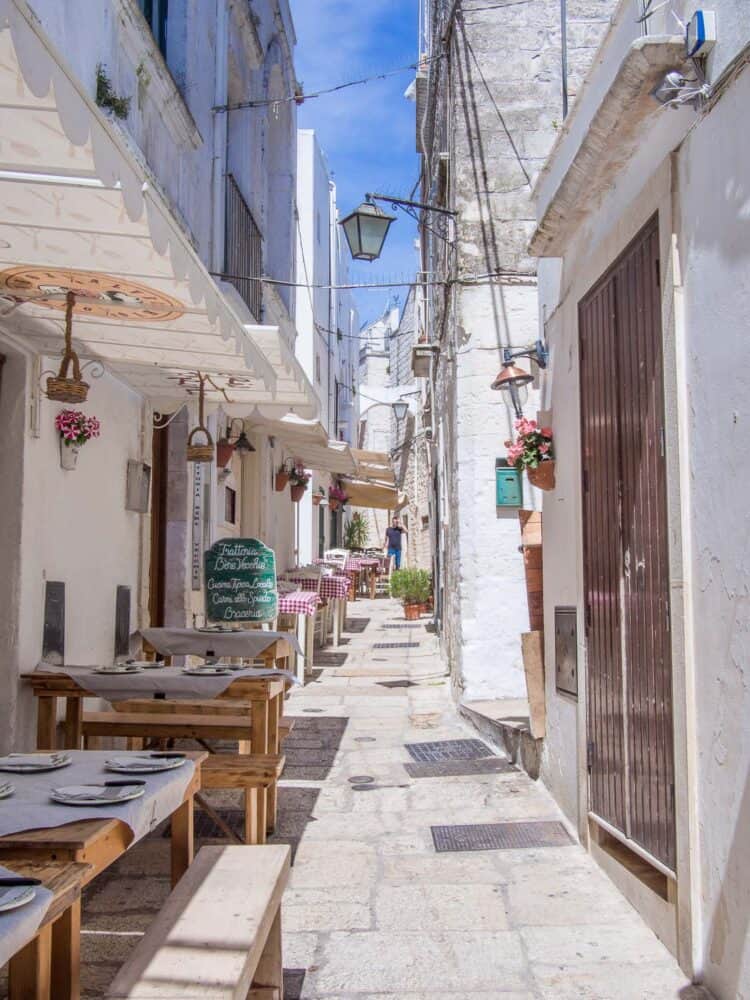
Cisternino is a picturesque place to dine (it’s famous for its meat) as many restaurants set up tables on the narrow streets.
Pick up some sweet treats for afters from Chocolab on the main square, Piazza Vittorio Emanuele.
Best Places in Puglia: Salento
The Salento is a hot, dry peninsula at the southern tip of Puglia. Its geographical isolation has meant that it has developed a strong identity with its own cuisine, traditions and music, influenced by its Greek past.
Along with some of Puglia’s best beaches, there are many fascinating towns to explore.
See our Salento Italy travel guide for lots more tips.
11) Lecce
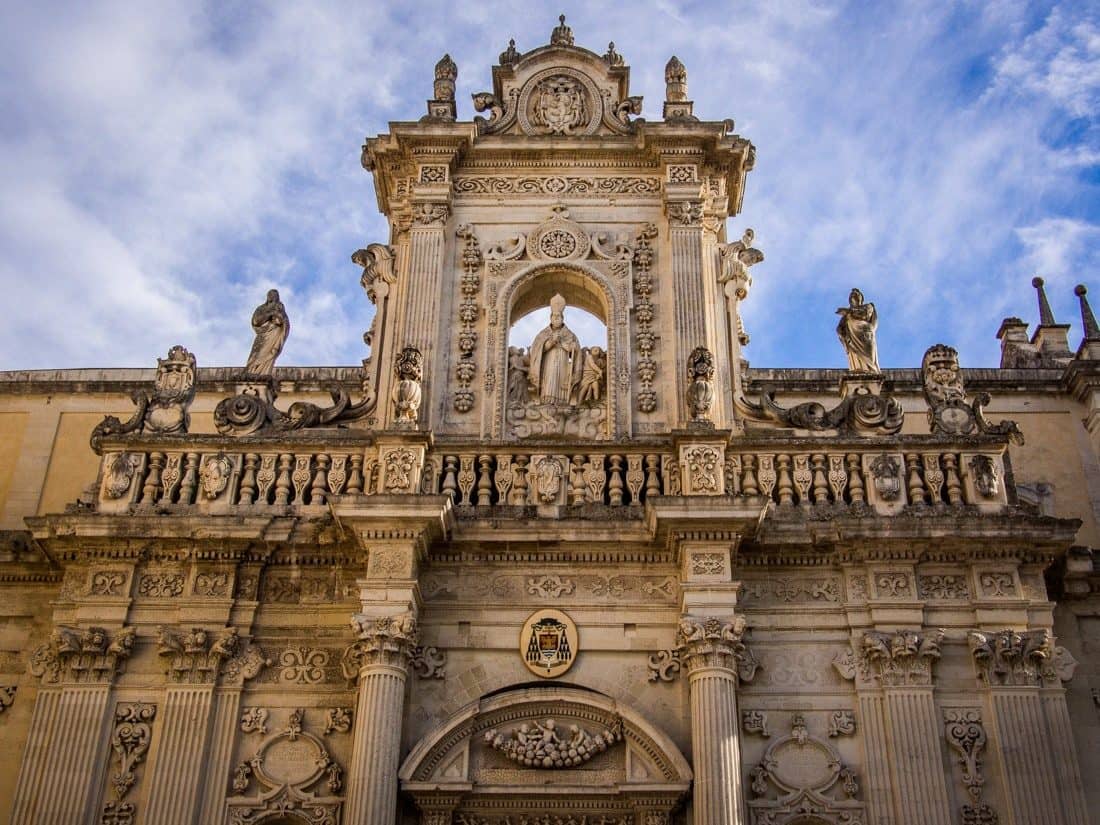
Lecce is known for its exuberant baroque architecture in the golden Leccese stone of the area, its churches lavishly decorated with cherubs, gargoyles and griffins, and delicately carved columns and cornices.
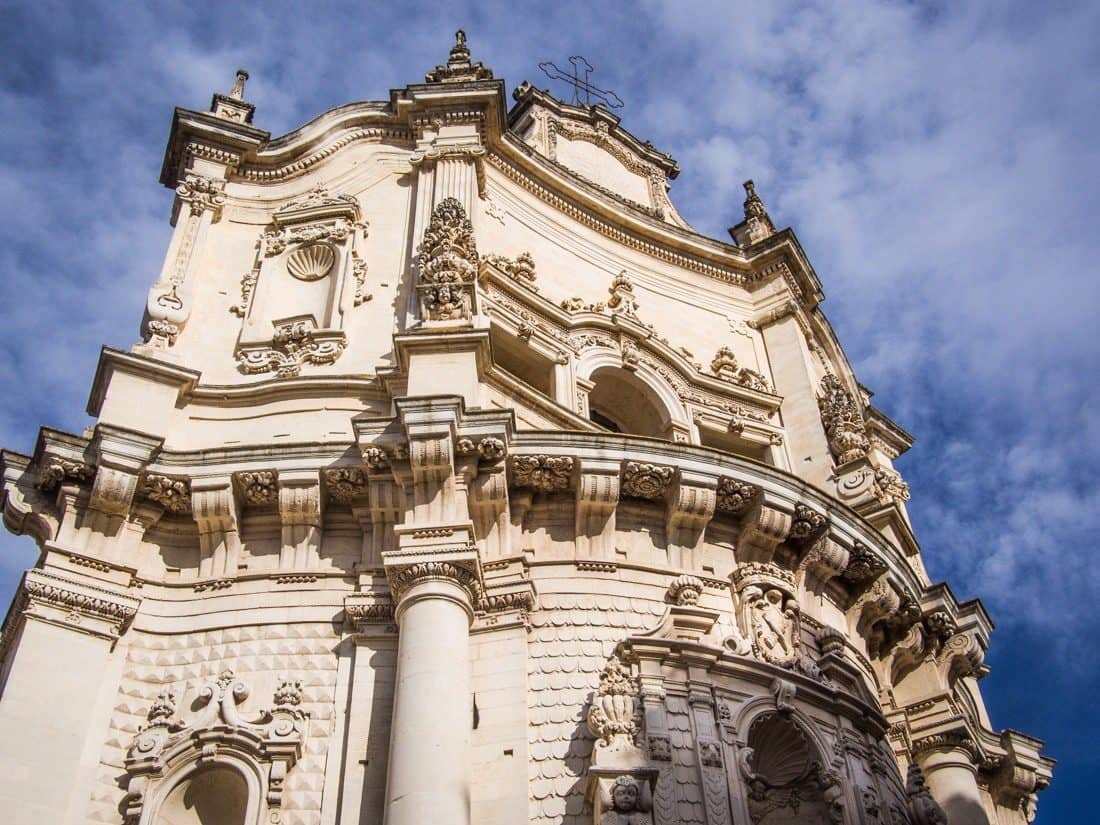
Lecce is one of Puglia’s larger cities, but it’s still a walkable size, and it manages to be both lively and relaxed. It’s one of Puglia’s highlights and the place we’ve spent the most time.
Read our detailed guide to things to do in Lecce for tips on sights, restaurants, transport, day trips and more.
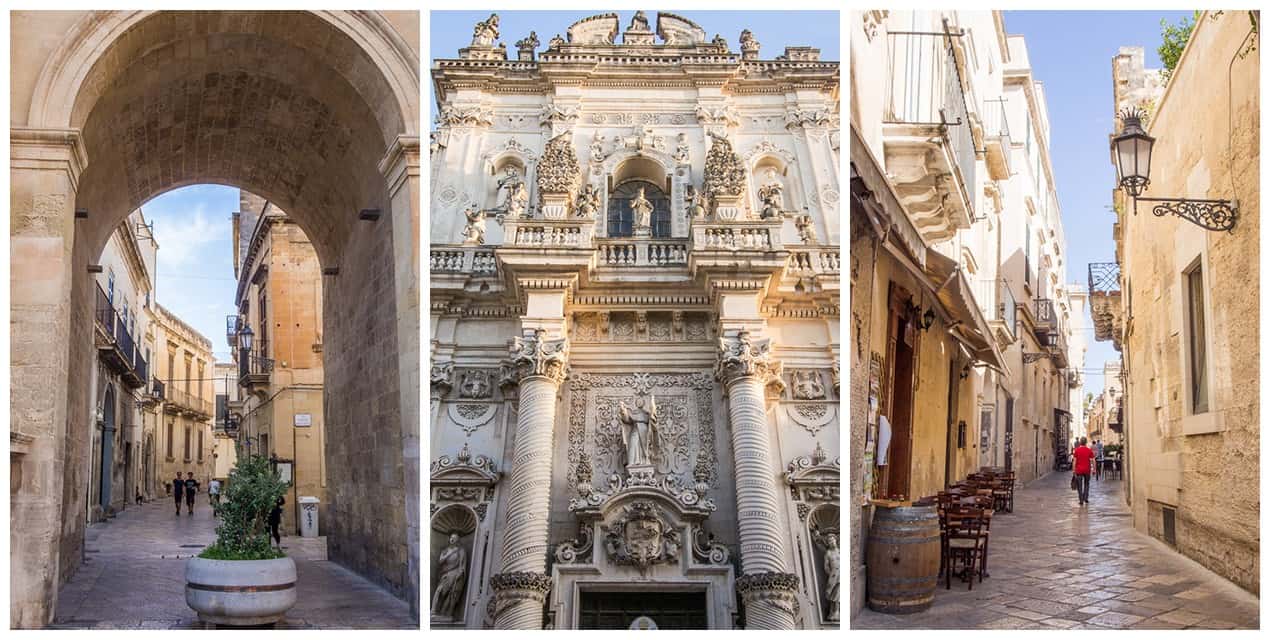
Where to Stay in Lecce
There are many gorgeous places to stay in historic buildings such as Dimora Storica Torre Del Parco 1419, a luxurious hotel in a medieval fortress and Palazzo Bignami, a stylish B&B very close to the centre.
You can find more hotels and B&Bs in Lecce here.
Where to Eat in Lecce
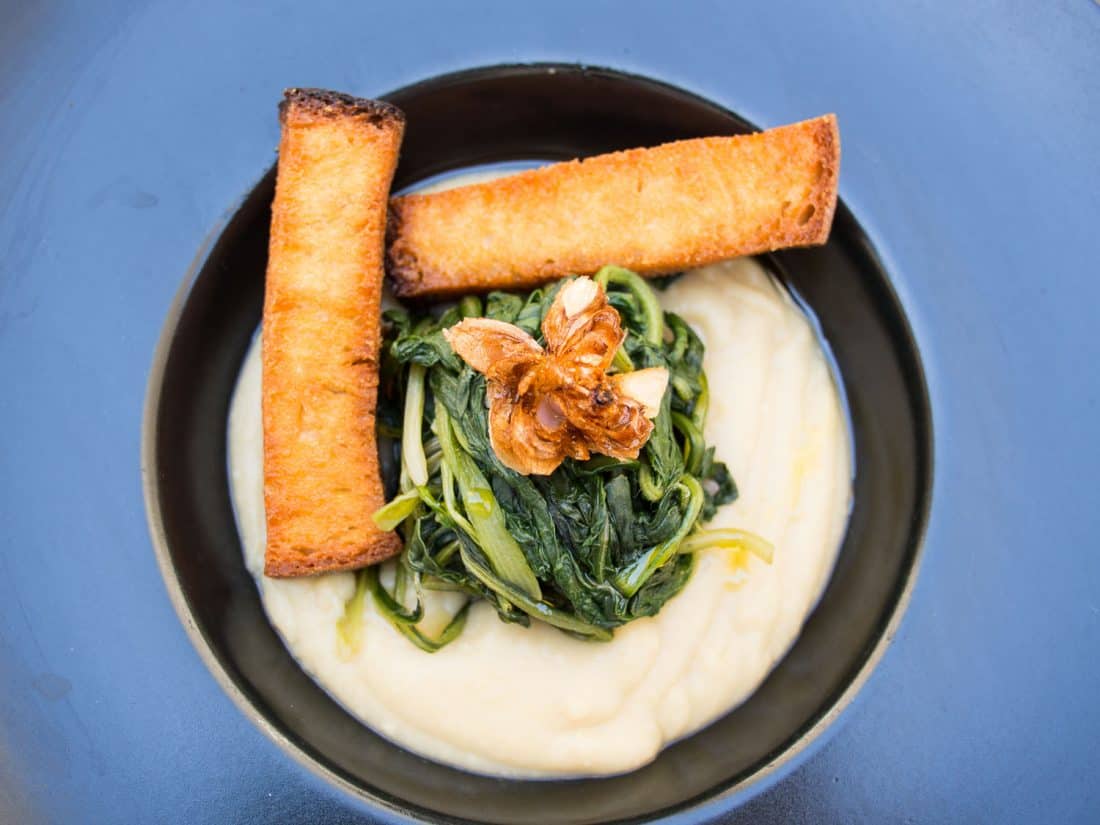
See our detailed guide to the best Lecce restaurants from gelato and cheap eats to traditional trattorias.
12) Otranto
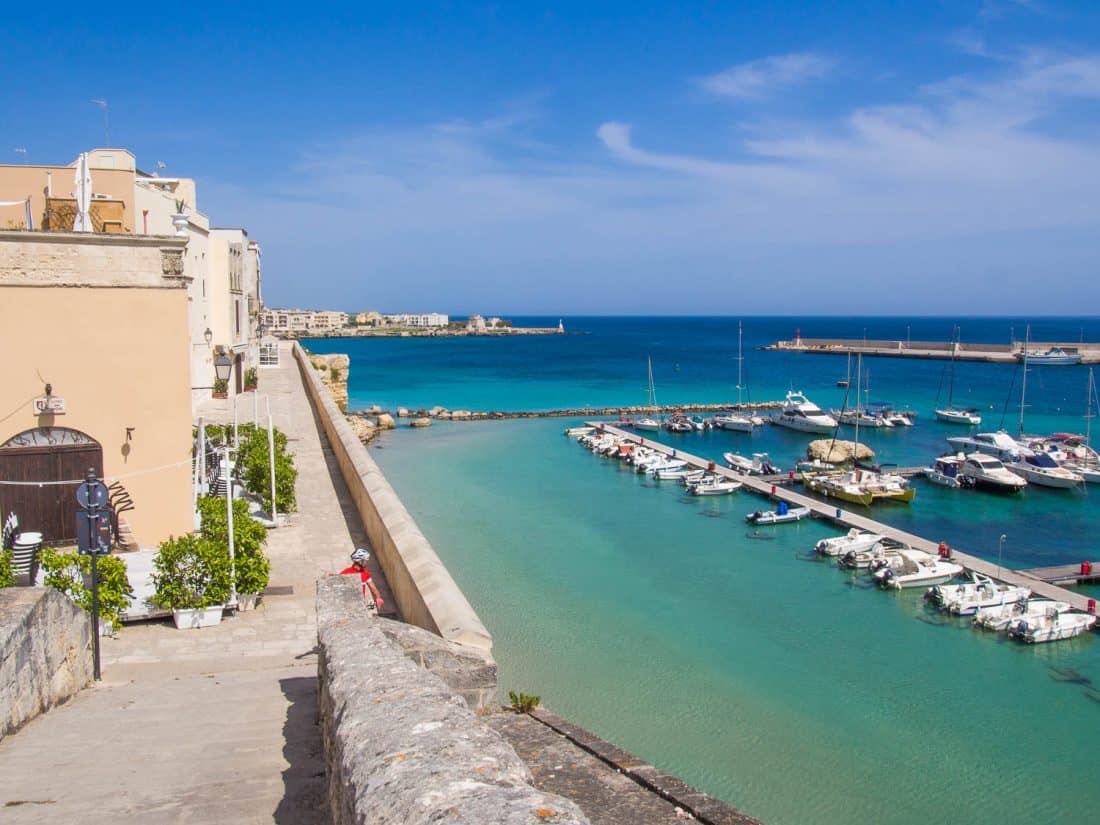
Otranto has a stunning coastal location where you can combine morning visits to churches with an afternoon swim in the clean, impossibly turquoise sea.
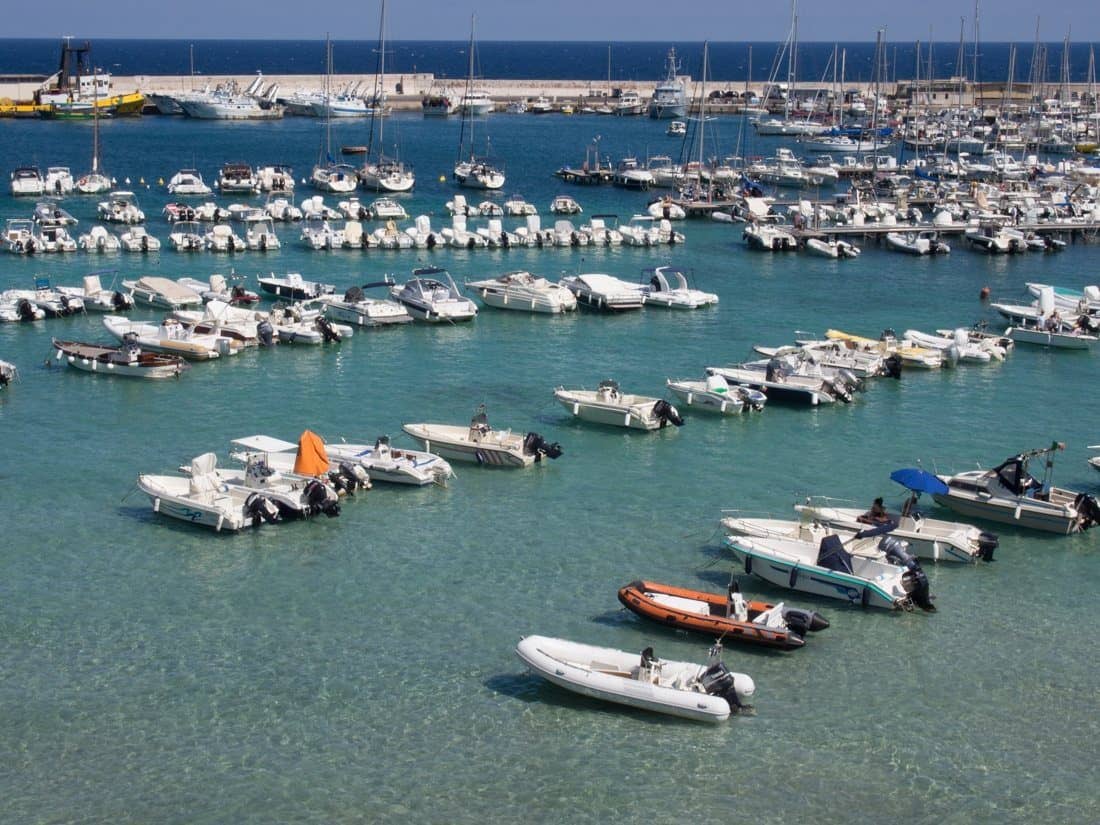
Otranto is just 72 km from Albania, and its location has resulted in many invasions, the worst of which was the Turkish siege in 1480 when they destroyed much of the city and tortured and killed its people.
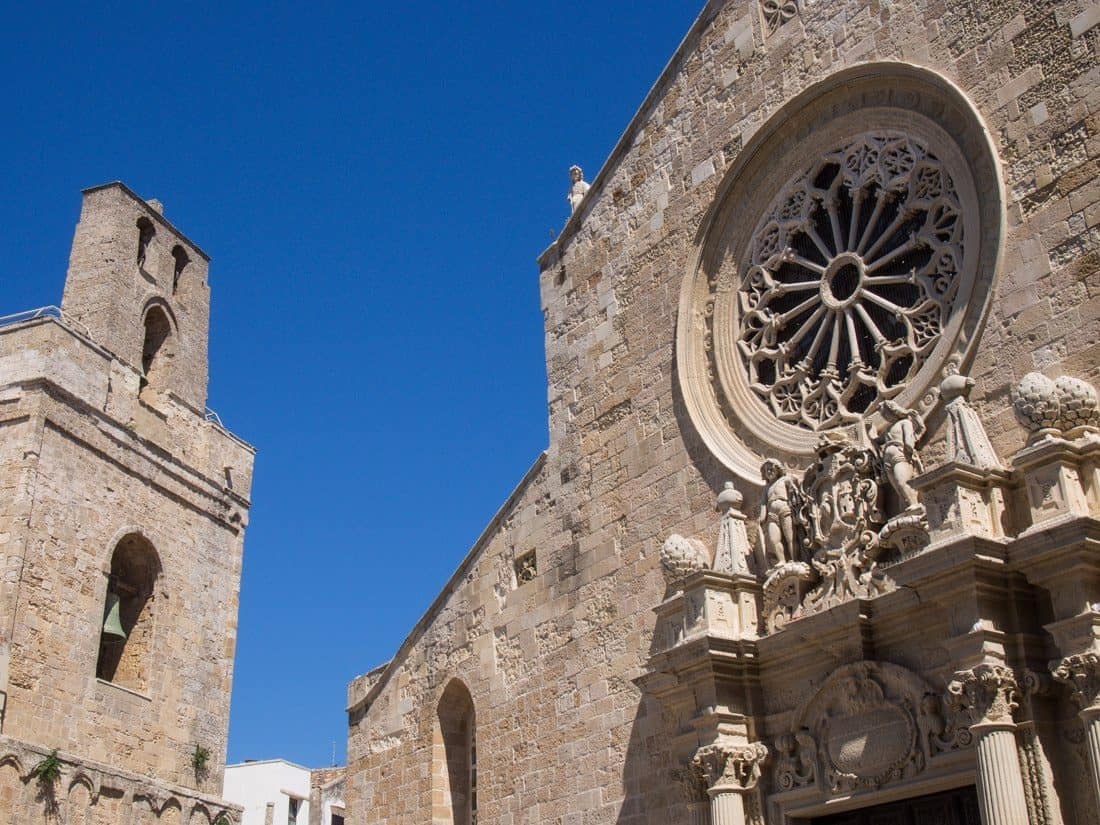
Otranto’s principal attraction is the Cathedral with its mosaic floor built in 1163-1165—it survived the Turkish invasion although parts of the Cathedral were destroyed.
It’s one of the largest mosaics in Europe and covers the entire floor.
Its central motif is the Tree of Life, supported at the base by elephants, a symbol of purity, with branches telling pagan and biblical stories.
Another tree near the front of the church depicts heaven on one side and grizzly scenes from hell on the other.
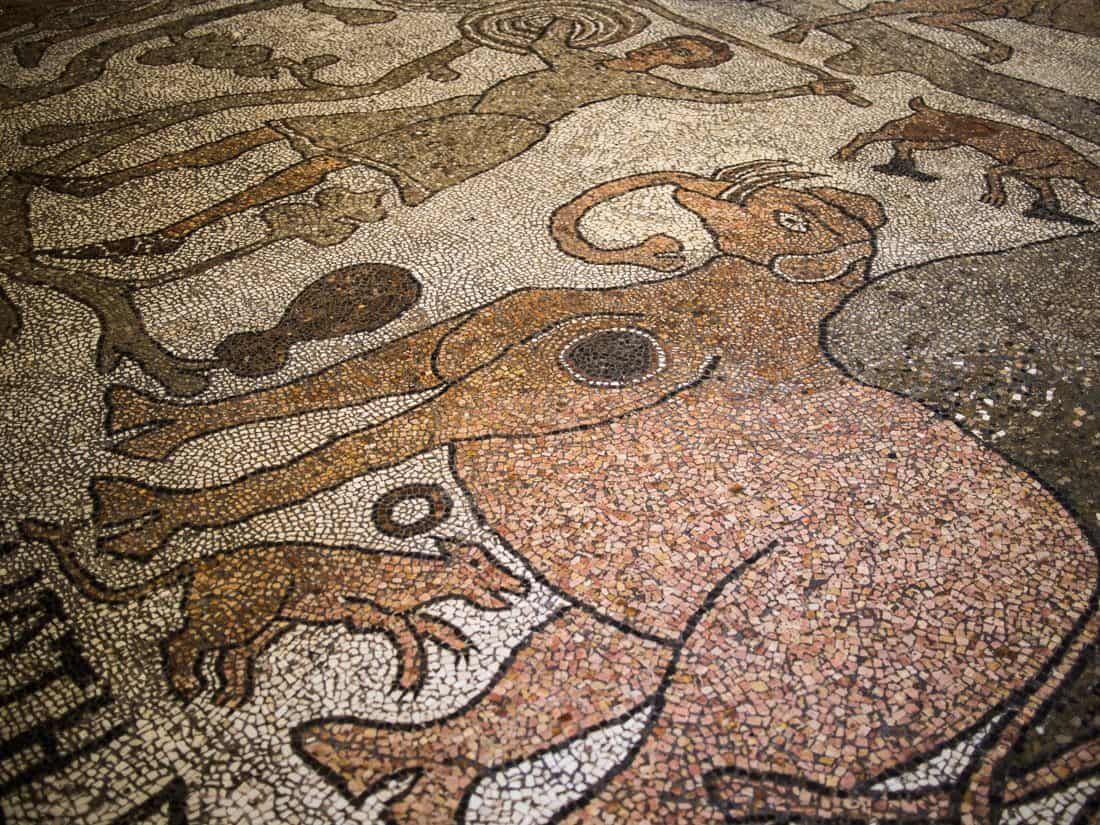
In the chapel, you can see the human remains of the 800 martyrs who resisted the Turkish invasion and refused to convert to Islam.
The empty sockets of hundreds of skulls stare down at you in stark contrast to the beauty of the mosaic floor.
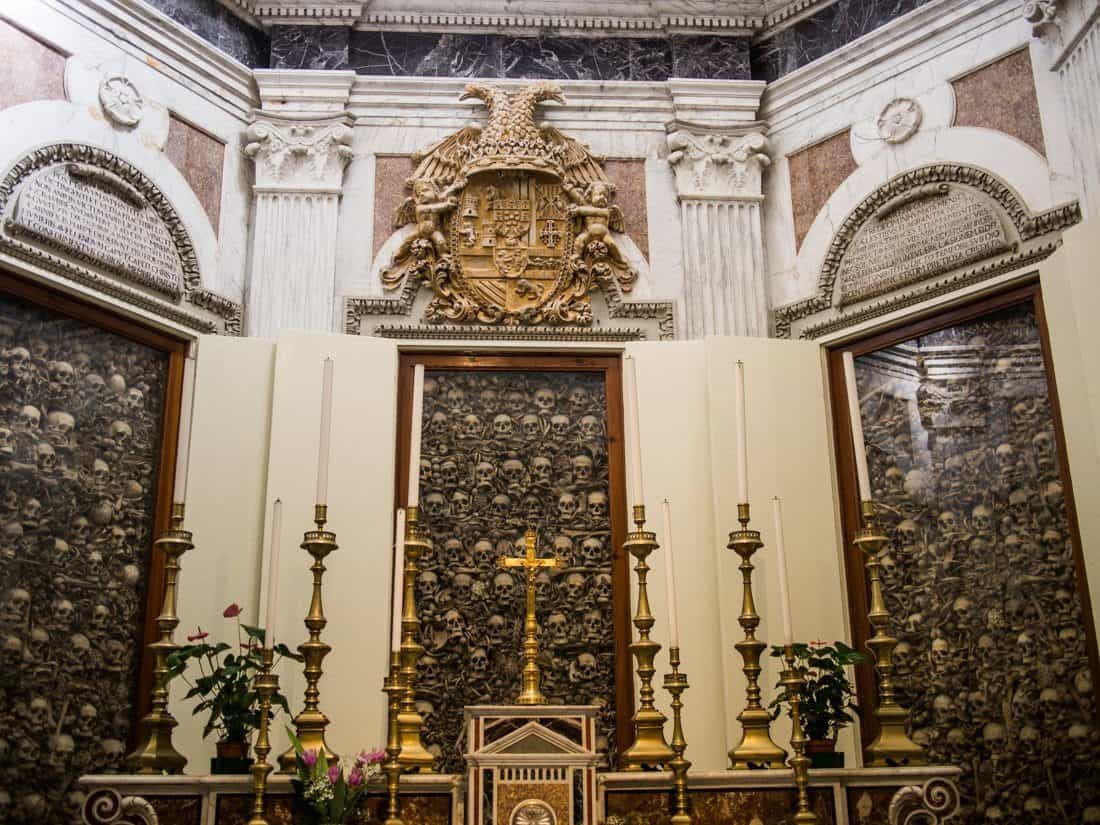
Where to Stay in Otranto
We visited Otranto on day trips from other parts of the peninsula. Otranto makes a good base in the Salento, though.
Boutique Hotel Palazzo Papaleo has a beautiful view and is located right next to the cathedral.
You could also stay on a farm in the nearby countryside—Masseria Panareo looks stunning.
You can find more hotels in Otranto here.
Where to Eat in Otranto
Postofisso makes amazing Puglian sandwiches called pucce including vegetarian and vegan options.
13) Gallipoli
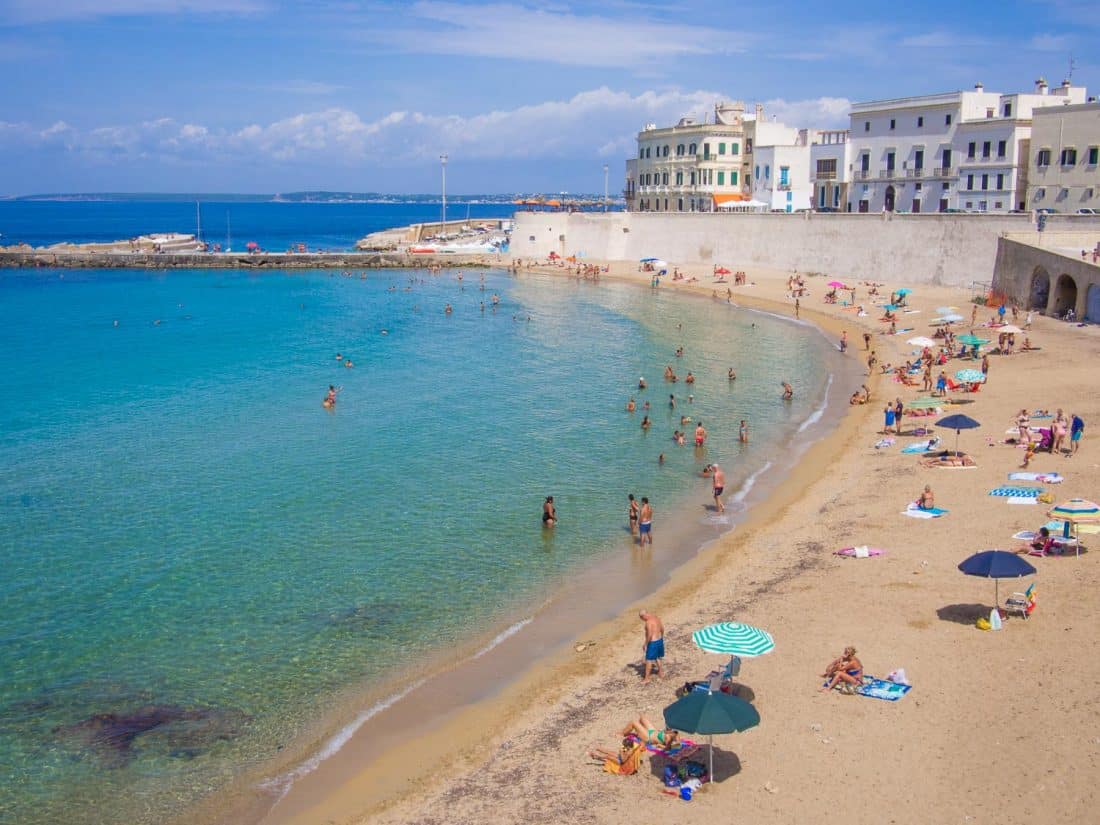
Gallipoli’s old town is on an island connected by a causeway to the mainland.
It has a relaxed, elegant vibe, stunning churches, and a golden curve of sand right in the centre of town, plus many more along the surrounding coast.
In July and August, Gallipoli does get uncomfortably busy, though—we prefer it in the shoulder season.
Gallipoli was ruled by the Greeks for five centuries between 7th and 2nd century BC, but all signs of their existence were destroyed by the Romans, and most of the architecture seen now is from the Middle Ages.
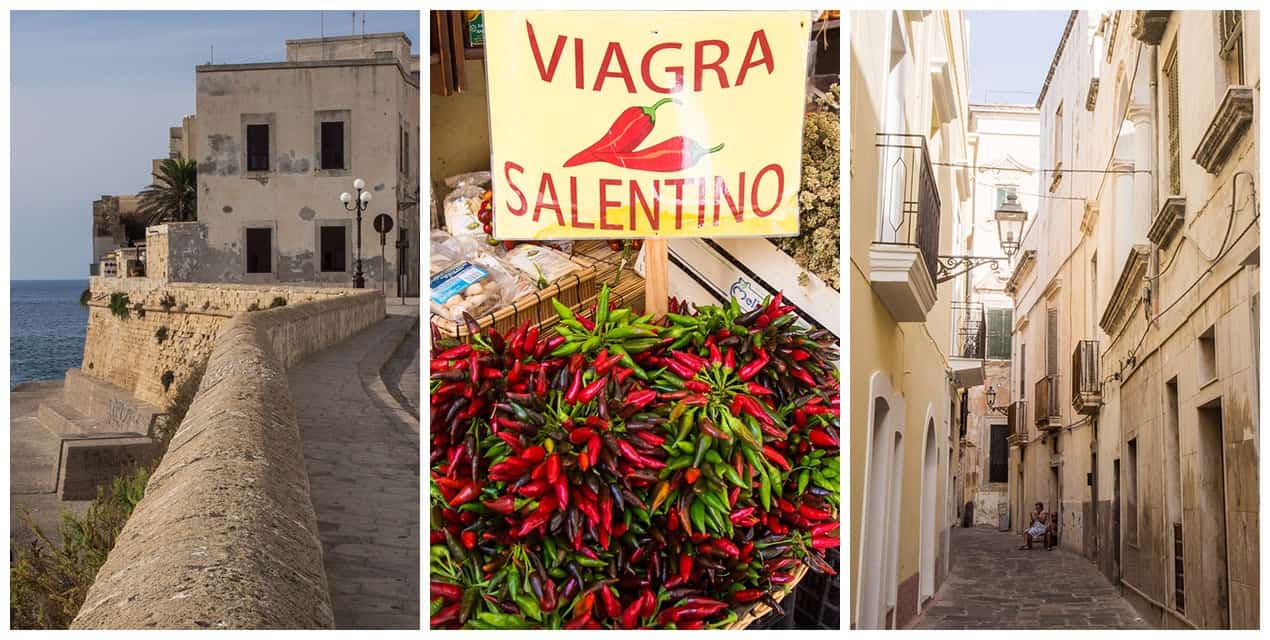
Other than leisurely walks along the city’s seafront walls (with a stop for a drink with a view), the most interesting thing to do in Gallipoli is visit Frantoio Ipogeo in Granafei Palace, one of the 35 underground olive presses.
It was first used in 1600, excavated by hand out of the soft rock, to make olive oil for lamps which was exported around the world.
You can see the original equipment used for grinding and pressing the olives and get a sense of what it was like to work in this dark, damp cave.
Blindfolded donkeys were used to work the olive mill, and they lived down here with the workers who smoked weeds and carved little sculptures to distract themselves from the miserable conditions.
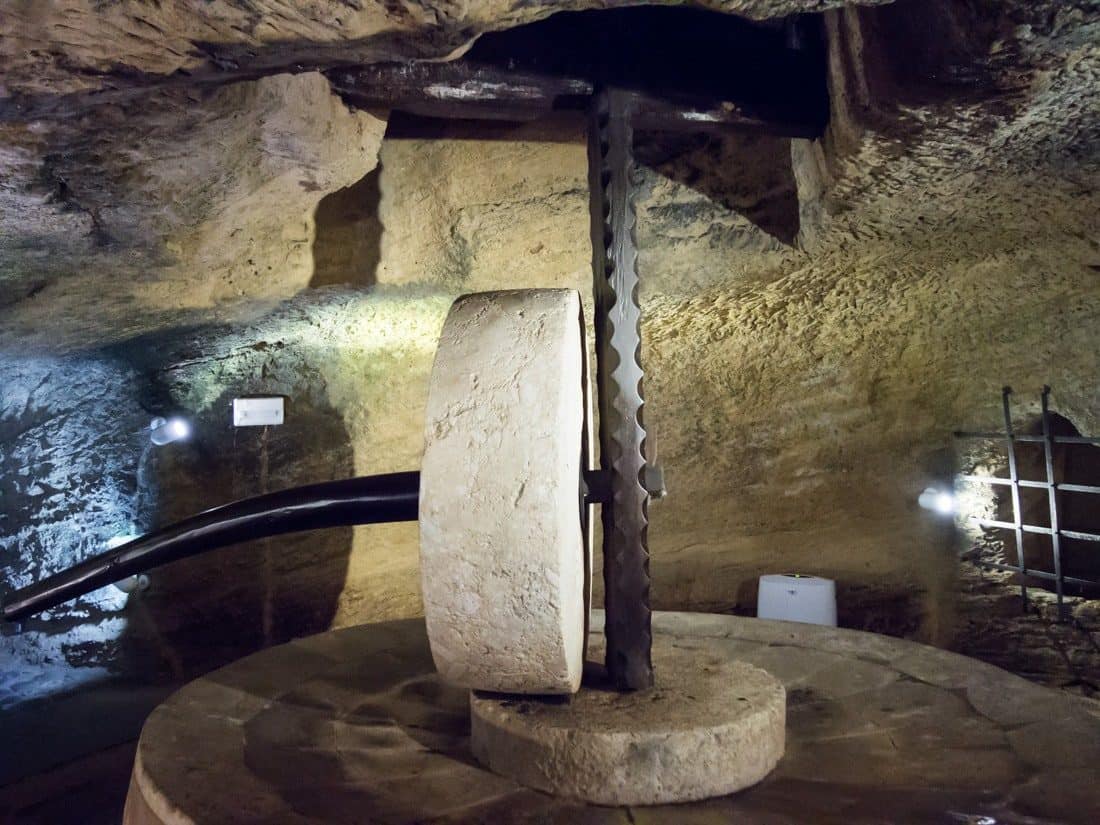
Where to Stay in Gallipoli
We always visit Gallipoli on day trips, but there’s plenty of accommodation.
Pascaraymondo Suite Palace looks amazing in a magnificently restored palace next to the beach.
Where to Eat in Gallipoli
We enjoyed the creative pizza at La Corte.
14) Corigliano d’Otranto
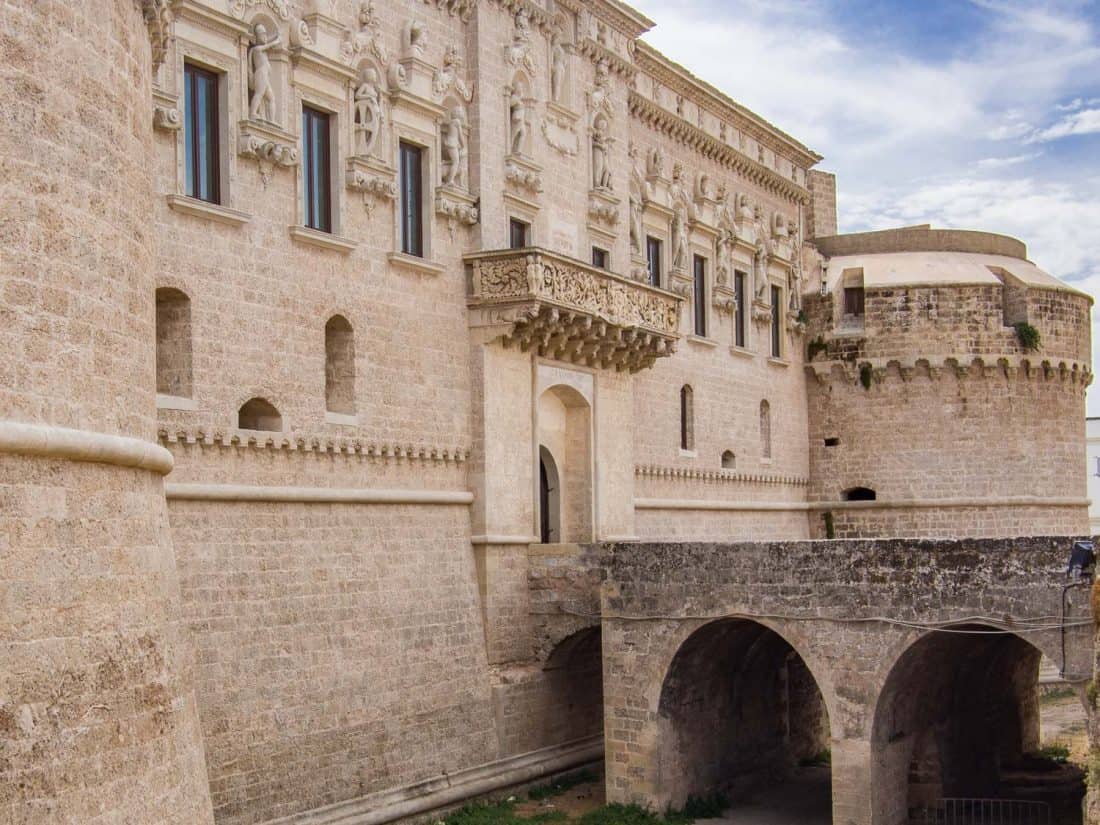
Corigliano d’Otranto is one of the 11 towns of the Grecia Salentina that have retained their Greek heritage from the Byzantine period including the Griko dialect.
It’s a small untouristy town with an interesting medieval castle that you’ll likely have to yourself.
Castello de Monti actually consists of two castles. The medieval castle was built in 1465 with four rectangular towers and was strong enough to resist the Turkish invasion when they came here after destroying Otranto.
The castle was fortified further in the 17th century with four round towers and a moat that encircles the inner castle.
Later a rich family transformed it from a fortress into a luxurious Ducal palace and added baroque details to the facade.
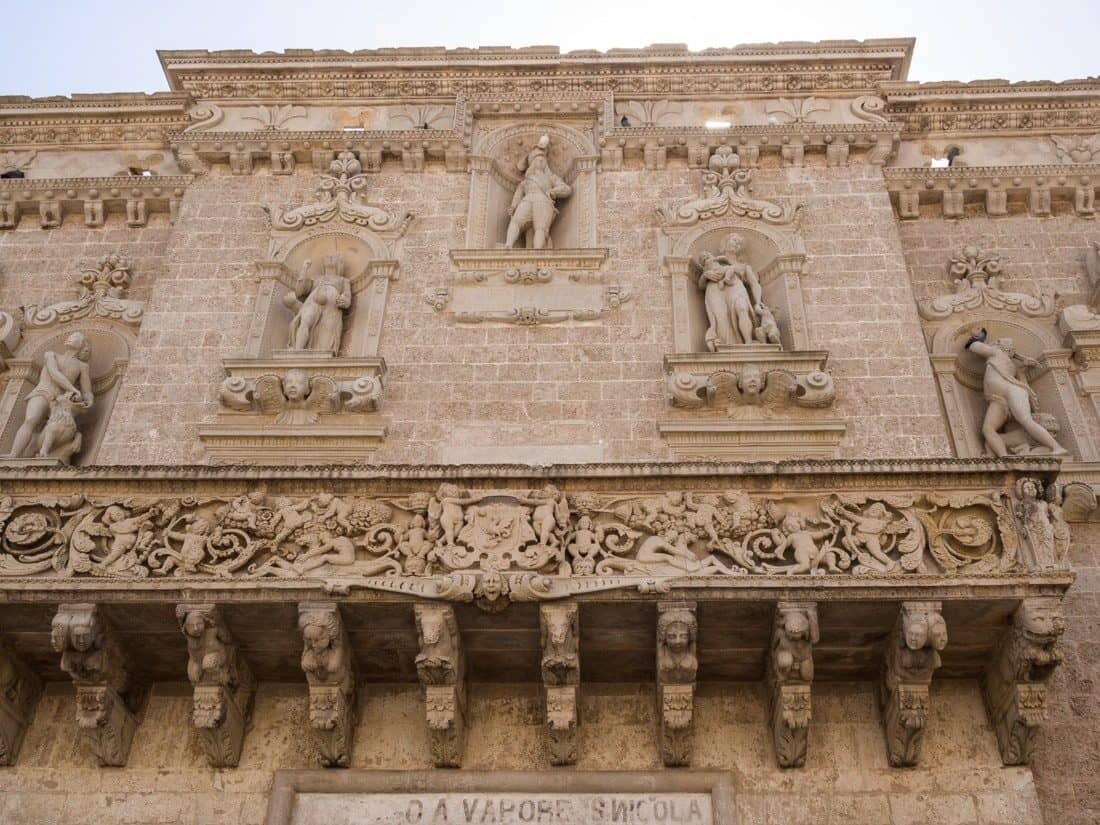
Where to Stay in Corigliano d’Otranto
Our main reason for visiting Corigliano was to stay at nearby Masseria Sant’Angelo, a working farm where you can learn about the traditions of the area from warm-hearted host Rocco who is a passionate musician of the local pizzica folk music.
We ate fruit from their trees, milked a goat, learned how cheese was made and enjoyed nightly feasts with the family. It’s a special, authentic place that will take you way off the beaten track.
Where to Eat in Corigliano d’Otranto
There’s a bar on the castle terrace, but I’m not sure if they do food.
The evening feasts at Masseria Sant’Angelo were some of our most memorable meals in Puglia.
15) Galatina
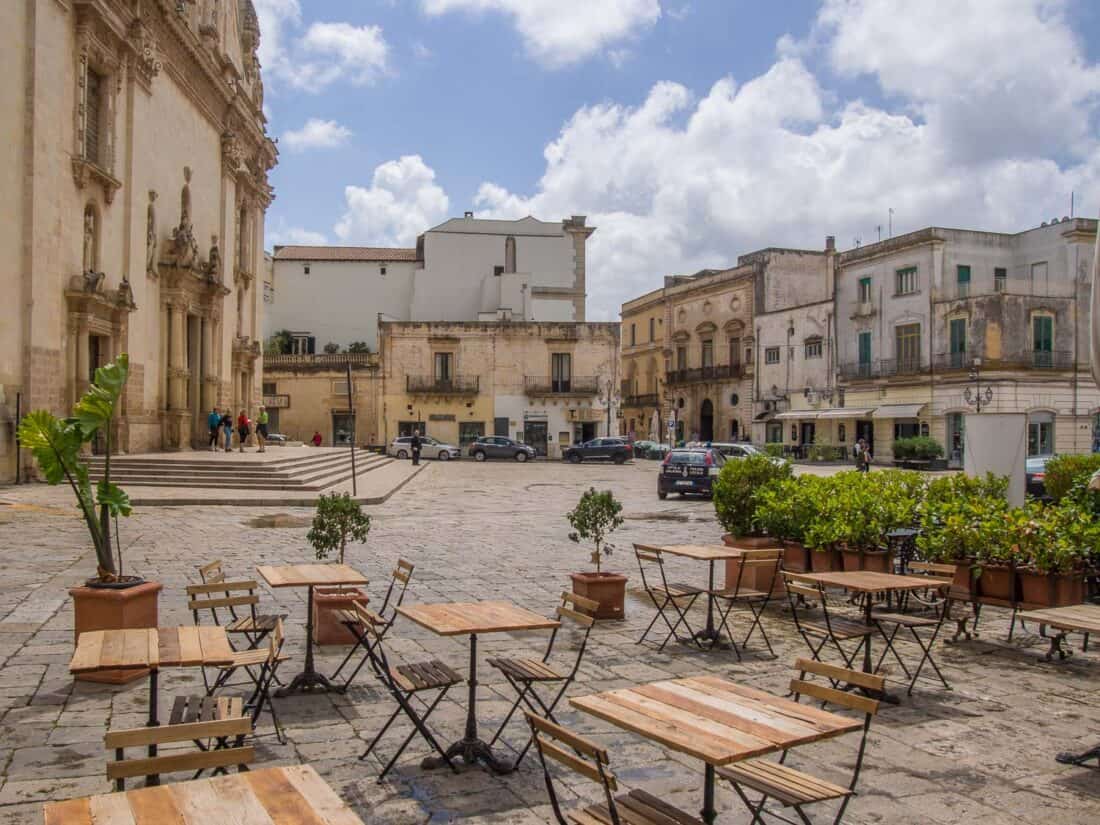
Galatina is another of Puglia’s hidden gems, just 10 minutes from Corigliano d’Otranto.
The preserved historic centre features golden baroque churches like those in Lecce and palaces with wrought iron balconies and grand doorways.
Don’t miss the Basilica di Santa Caterina d’Alessandria with its stunning 15th-century frescoed walls and ceiling.
Where to Stay in Galatina
We visited on a day trip from Lecce, but Galatina would make an affordable, quiet, and central base for Salento.
Corte Baldi is a charming B&B in a palace in the historic centre just steps from the basilica.
Where to Eat in Galatina
Galatina is the birthplace of the pasticciotto pastry, which you can try at Pasticceria Andrea Ascalone. It does contain lard, though.
We had a delicious lunch at upscale Anima e Cuore in an old palace with a large terrace.
They focus on seafood, but there’s a separate vegan menu.
16) Castro
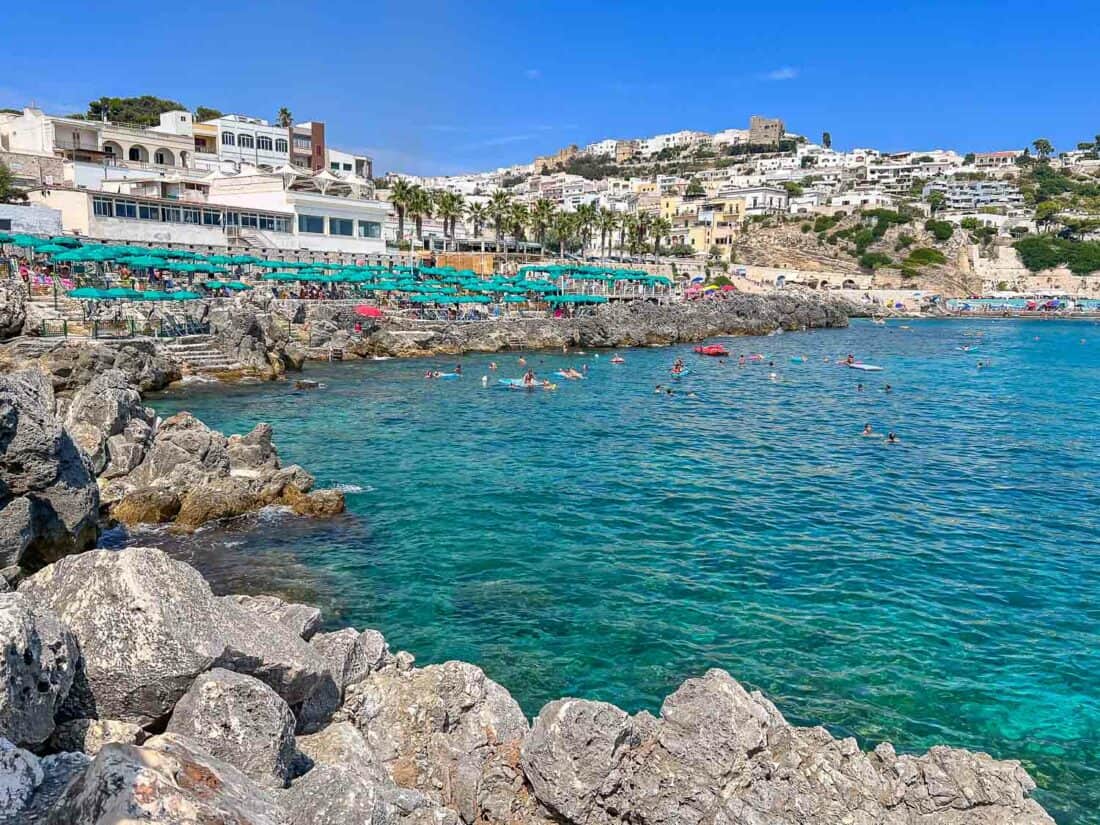
Otranto and Gallipoli are crowded in summer, so my new favourite seaside town in Salento is Castro.
While Castro Marina doesn’t have a sandy beach, there are beach clubs on the rocks and the water is gloriously clear.
I loved swimming with a view of Castro’s castle and old town on the hill above.
You can also take boat trips to visit nearby caves.
The coastal drive south to Santa Maria di Leuca is one of the best in Puglia.
Read my Castro Italy travel guide for details.
Where to Stay in Castro
One of the reasons I loved Castro so much is that we stayed right on the water at Hotel La Roccia.
Where to Eat in Castro
Delizie in Contea has fantastic platters of local products on a charming piazza in the old town.
Best Places in Puglia: Gargano
The Gargano Promontory juts out into the Adriatic Sea in northern Puglia and is called the spur in the heel of Italy’s boot.
It feels very different from the rest of Puglia—greener and more mountainous with lush pine forests and a spectacular coastline of white limestone cliffs, colourful sea caves, and long sandy beaches.
It’s harder to get to than the Valle d’Itria and Salento, and we didn’t find the towns quite as pretty, so I only recommend coming here if you are in Puglia for more than 10 days or are a return visitor.
17) Vieste
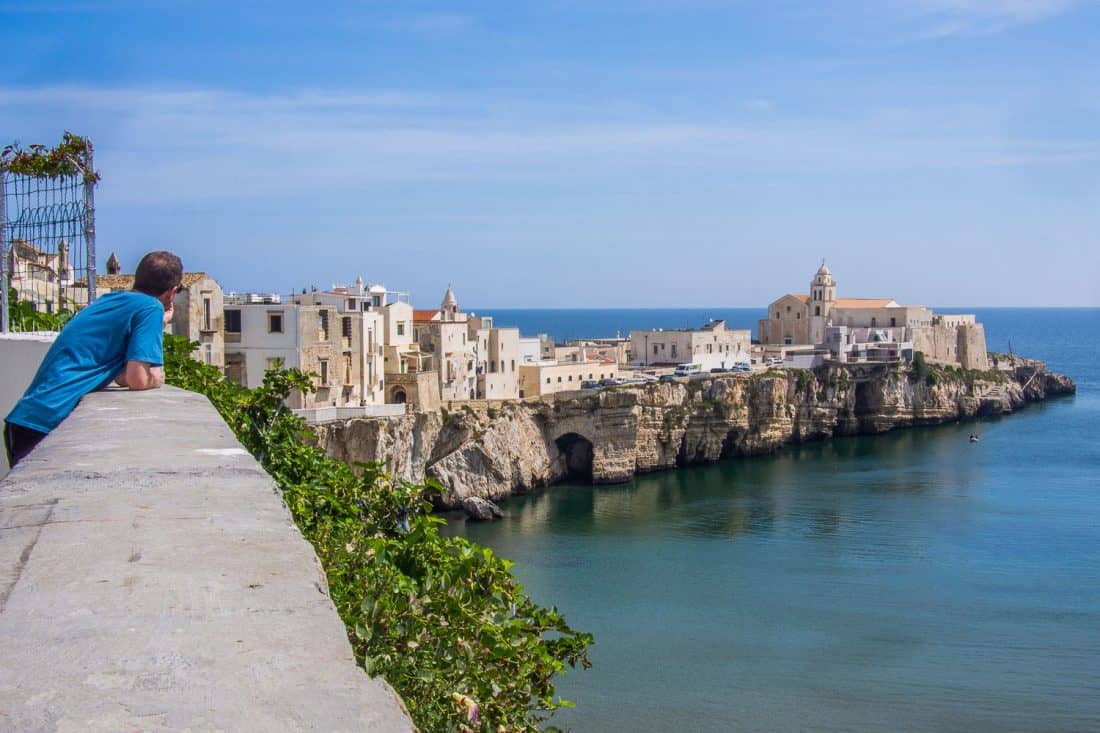
Vieste sits on a white-cliffed peninsula jutting into the sea. The old town is an atmospheric maze of steep staircases, with washing dangling from the simple white houses.
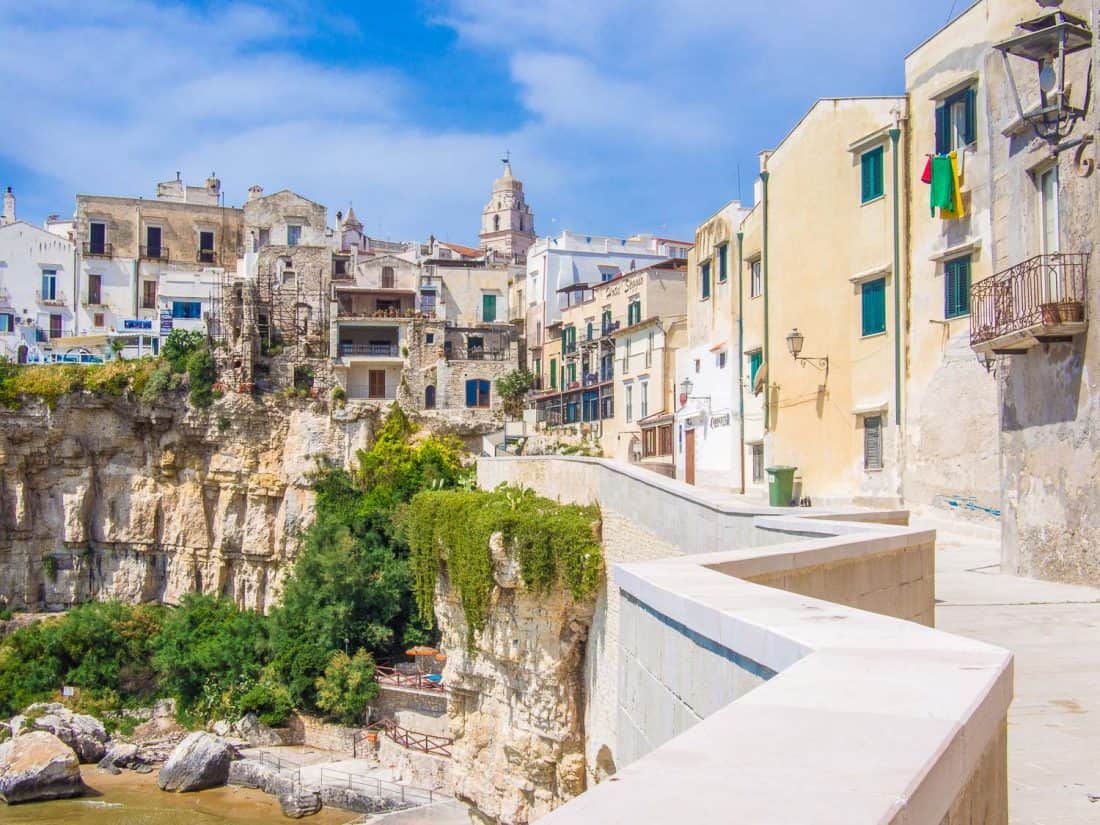
On each side of the town are long sandy beaches that can be accessed on foot. You can take a beautiful boat trip down the coast to see dramatic sea stacks and grottos.
It’s the ideal base for exploring the Gargano. See our post on things to do in Vieste Italy for more information.
Where to Stay in Vieste
We stayed outside town at the wonderful Residence Maresol up a steep hill above Castello beach.
We loved the tranquil location amongst pine trees, sea views, modern apartments, and super friendly owners.
You can find more B&Bs and holiday rentals in Vieste here.
Where to Eat in Vieste
Our favourite places were in the countryside outside town—Country House Tavernola and Agriturismo Chalet degli Ulivi. See our Vieste guide for details.
More Gargano Towns
I think Vieste is the best base in Gargano, but there are many more towns to visit on day trips including:
- Mont Sant’Angelo – Picturesque mountain town with a famous cave church.
- Peschici – Pretty seaside town close to lovely beaches.
- Vico del Gargano – An off the beaten track hill town.
See our Gargano Italy travel guide for more details on places to visit in the area.
Is Puglia Worth Visiting?
Puglia is absolutely worth visiting for its fascinating history, varied architecture, friendly people, delicious food, and glorious coastline.
I hope this post has given you some ideas of where to visit in Puglia, but there are so many beautiful places in Puglia that these towns are just some of the possibilities. Enjoy!
More Puglia Posts
Read our other Puglia blog posts to help you plan your trip to the region:
General Puglia Tips
- 17 Best Beaches in Puglia
- The Ultimate Puglia Food Guide
- The Best Masserie in Puglia: Experience Life on an Italian Farm
Central and Northern Puglia
- 17 Best Things to Do in Bari, Puglia
- 8 Beautiful Places to Visit in the Gargano, Italy
- 16 Best Things to Do in Ostuni, Puglia’s White City
Salento Peninsula
Matera (in Basilicata)
If you enjoyed this post, pin for later!
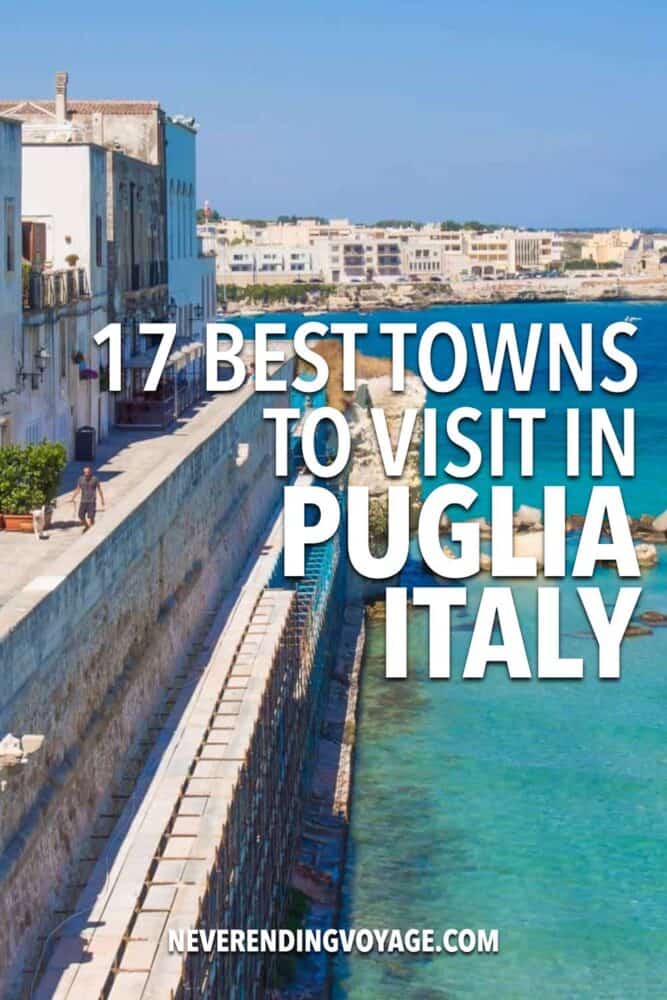
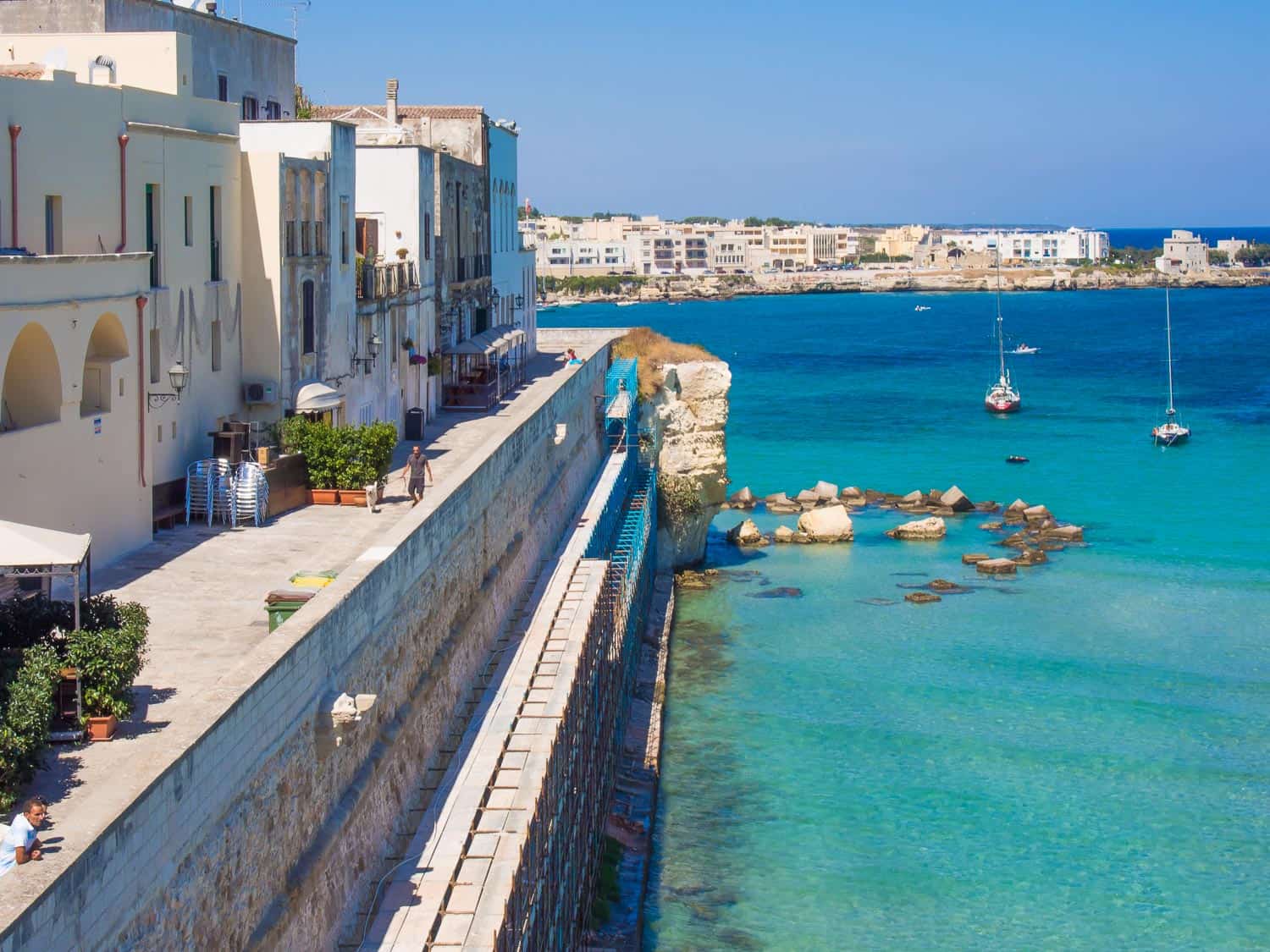
Hi Erin
What a great website, there’s so much useful information. We’re attending a birthday party in Taranto over a weekend in early October and would like to add on perhaps five/six days to relax and sight see before and after . Our thoughts are to book flights into and out of Bari and then use a hire car to do a circular route taking in some of the sights. Have you any recommendations for bases and accommodation?
Hi Erin. Great info!
My husband, my adult daughter and myself are visiting Puglia In late December, early January for 2 weeks.
We are Not sunloving beach goers, so where do you suggest we stay and visit?
We love great food, beautiful sights, architecture, culture, hiking…
We will have a car..
Hi Erin,
We will be driving from Sicily in early May and we have 7 nights in Puglia before driving back to Rome to fly home to Australia. We are not bothered about beaches but love the coast and inland. We want to experience and see as much as we can in the short time we have. Thought we would stay in 3 places and do lots of day trips, where would you suggest please and in what order?
Thank you
I would probably choose Matera (not in Puglia but well worth visiting), Lecce, and either Polignano if you want to stay on the coast or a holiday home in the surrounding countryside if you prefer that. Enjoy!
Hi Erin,
Thank you so much for all your tips for puglia – we are travelling there in a few weeks and have found your tips amazingly helpful. Do you know if Carpignano Salentino is a nice place to stay, we have found some lovely accomodation but are not sure what the town will be like as a base?
Any tips appreciated! Alternatively Nardo / Lecce / Countryside!
I hadn’t heard of it but it looks like a central location for exploring the Salento (as long as you don’t mind driving). I actually love choosing random towns to stay in Puglia so I’d go for it if you’ve found some nice accommodation! Enjoy!
Hello! Thank you for your resourceful blog. My husband and I are planning a 2 week trip to Italy. Our primary focus is the Dolomites and we are looking for a 2nd location on the coast of Italy for a change of scenery and cuisine…and perhaps opportunity to relax and wonder. I am torn between Italian Riviera or Puglia. What would you recommend? We plan to be in Dolomites 2nd or 3rd week of Sept and our other destination last week of Sept / first week of October.
I would go for the Italian Riviera. They are both beautiful but it’s closer to the Dolomites. Enjoy!
Hi, Erin! I have roughly 2 weeks to spend in Puglia. My husband and I want to do a little of everything without feeling like we’re constantly in the car and rushing from place to place. We were thinking of Monopoli (in city center) as a base and then Lecce as a second base. We like more of a city feel as opposed to a rural setting. Not sure if you need to spend nights in Alberobello or Polignano a Mare. Is it possible to get beach access in August? Is Matera worth a visit? I apologize in advance for all the questions! We enjoy eating at upscale restaurants as well and wondering if you could recommend any. Thank you so much in advance!
Hi Kim, Monopoli and Lecce are great choices if you don’t want to stay in rural areas. You can visit Alberobello and Polignano a Mare easily as day trips.
Matera is the only place I’d consider adding as an additional overnight (or ideally 2 night) stop. It really is spectacular and different from the other towns you are visiting. It’s 1 hour 20 mins from Monopoli so you could do a day trip, but I love having a sunset drink there and seeing it lit up at night.
It also has the most upmarket restaurant we’ve eaten at in the area— Regiacorte. You can read more about it in our Matera restaurants guide.
There are plenty of free sections of beaches you can access (including the one in Monopoli centre), but they do get extremely busy in August (we were there last summer). Around mid-August especially we found it more comfortable to book a beach club (but they do sell out).
Our Puglia beach guide has details of the fancy club we went to (Bahia del Sol Porto Cesareo), which would be an easy day trip from Lecce.
Enjoy!
Thank you so much! We will be there 5/8 – 18/8. Do you recommend a certain order in terms of itinerary? Also, I hear mixed reviews about Bari. Is this a must see? This will be my 6th trip to Italy, but I have never visited this region so we’re looking for unique experiences.
Best,
Kim
I would do Lecce – Monopoli – Matera just so that you avoid the beach places around 15 August (the Ferragosto holiday is a big deal).
I really like Bari old town and think it’s worth visiting for half a day if you have time. You could get the train from Monopoli in 35 minutes.
Hi,
Love your blog. To think we were going to miss Matera! You now have us booked in for 2 nights. Seems amazing. Can’t wait.
We are looking at doing a bike tour in and were original Now we are thinking Polginaro, Monopoly, Ostuni region then car takes bikes down to Leece Otratnto region. Would you recommend another 2 nights to do the later? Or are there other regions in Pulgia that would suit better?
Kylie
We haven’t biked in Puglia ourselves, but I think the Ostuni area plus somewhere in the Salento (which is pretty flat) would be ideal.
This article could give you some ideas: https://www.theguardian.com/travel/2022/apr/16/cycle-200-miles-around-puglia-in-six-days-on-an-e-bike
Enjoy Matera too – you won’t regret it!
Hi Erin love your page! I was just wondering we are planning to visit Puglia in September for 4/5 nights flying into Bari and out of Brandisi we were thinking of staying in Bari one night then travel down towards the south. Would Ostuni and lecce be good places to stay or where is best than we don’t have to move every night? Thanks
Ostuni (or anywhere in that area) and Lecce are great choices. If you want to stay in just one place you could even stay in Ostuni (after a night in Bari) and just visit Lecce as a day trip. Enjoy!
Hullo Erin,
We were very happy to find your website, we are planning a 2 week car trip to Pulia in May 15 th to 27th should we pre book accomodation or do it as we go ? or just pre book weekends ? We are arriving in Matera on 15th May and departing from Bari Airport May 27th.
What 3 towns should we look at as bases for day trips ? Love to hear your suggestions
Heather and Rod ( Australia)
Wow great blog thank you! Do you know of any places in Otranto or Lecce that accommodate gluten-free diets?
I don’t know anywhere specific as I wasn’t looking for it, but Italy is generally quite good for gluten-free travellers. Our friend has written this guide about it: https://www.legalnomads.com/gluten-free/italy/
Hi Erin
I love your blog! I am going to a wedding in Bari in Sep 23 and was planning on travelling down the coast afterwards for about 7 nights. Some places I’ve noticed form your blog worth visiting would be, Poliganno a mare, Monopolo, Otranto/Salento. We hope to fly home from Brindisi and was wondering what you would recommend in terms of where to stay across those areas, I love the seaside! I would like to rent a car and do day trips rather than move accommodation multiple times, but if we were to do two or three accommodation options, I would love to know where you would recommend. We have never been to Puglia before so open to trying any areas.
I would divide your week between Polignano (or Monopoli) and Otranto (or for a less touristy spot, possibly Castro – we loved our stay last summer as we stayed right on the water at Hotel La Roccia.). You can easily take day trips to many places from there.
Enjoy!
Wow Erin,
This is Fantastic! Thank you so much for this valuable information. Love it all. Would love to know your thoughts on our upcoming vacation. We arrive in Bari at 08:20 am and go straight to Matera for 4 nights, then head to Lecce for 3 nights, then Otranto for 3 nights, the Ostuni for 2 nights, then Monopoli for 2 nights then straight to the airport and on to our next destination. We are there for 14 days. Is this a good way to see Puglia or is there something else you recommend? Nothing is set in stone at this point, so your input would be appreciated.
That sounds like a great plan Lisa! That’s a really nice amount of time in Puglia.
Hi,
I totally enjoyed your blog and the towns to visit in Puglia, I’m new to this part of Italy, could you tell me where to start, thinking of Bari and where to go from there for approximately 8 days trip in the region. I’m not sure yet if i would hire a car or not at this point.
Thank you,
Evy
Bari is a good place to start – perhaps for one night. I’d also recommend Matera for two nights. Then it really depends if you’ll have a car and if you want to base yourself in one place and do day trips (definitely possible) or move around. And also if you want to stay close to the sea, in the countryside, or in a town. There are so many options.
Hi Erin
Planning to visit Puglia May 2023 Have about 6 days
Thinking of flying into Bari, stay one night and head to Lecce 2nights, Otranto 1 night.
Want to then head to Santa Cesarea. Have you been there? My wife’s parents met there in a Displaced Persons Camp and my wife is so looking forward to going there. Do you know of anyone we can contact from there to learn the history?
After there can you recommend a destination? Is Gallipoli worth visiting or just head north and visit towns to stay in on the way back to Bari?
Thanks
Arthur
Hi Arthur
Yes, we did go to Santa Cesarea this summer – it’s lovely. I’m afraid I don’t know any guides in the area. You could try contacting the tourism office (there’s an email listed here: https://www.viaggiareinpuglia.it/at/150/localita/4273/en/Santa-Cesarea-Terme-Santa-Cesarea-Terme-(Lecce))
We stayed about 10 minutes south in Castro, a very cute seaside town (with a historic centre up the hill) that’s less visited than Otranto or Gallipoli. We really enjoyed it and stayed right on the water at Hotel La Roccia.
The coastal drive from Santa Cesarea/Castro down to Santa Maria di Leuca is well worth doing (follow SP358 and not the route Google Maps says is quickest).
And then I think it is worth visiting Gallipoli. On our latest visit in August we found it uncomfortably busy but in May it should be lovely.
To avoid moving around too much you might want to spend a couple of nights in Santa Cesarea or Castro and visit Gallipoli as a day trip (do a loop by heading there on the coast road then back on the quicker inland road cutting across the peninsula).
Have a wonderful trip!
Erin
Hi Erin:
My husband I and I will be visiting Puglia in October. So far we have Val’Ditria (staying in Fasano) and Salento (staying in Lecce) regions planned. As part of our trip, we would also like to visit Matera and use it as a base for 2 days with a day trip to Altamura. In your opinion, is Matera a good option for staying overnight? If so, would you have recommendations of upscale places we could look into staying? Thanks so much.
Yes, I highly recommend staying overnight in Matera. See our Matera guide for hotel recommendations: https://www.neverendingvoyage.com/sassi-matera-italy/ (We just updated it after our latest visit in July). Enjoy!
Hi Erin, a really excellent blog on Puglia. Having visited northern Puglia and Basilicata 4 years ago, we are heading to southern Puglia (Salento) for 10 days later this month (September). We will be flying to Brindisi and hiring a car for the duration of our stay. On our previous trip we divided our stays between Bari, Alberobello, Caravigno/Ostuni, Matera and Bari. On this occasion we are thinking of – Brindisi (1 night), Lecce (2 nights), Oltranto (3 nights), Santa Maria di Leuca (1 night), Gallipoli (2 nights), Porto Cesareo (1 night). Although staying in various locations will mean there is no rush to head back to a central base before it gets too late, there is of course the hassle of booking different accommodations. What are your thoughts on this? What do you think of the proposed itinerary and stopover durations? I speak reasonably good italian so I am happy to converse with the locals. Ideally, we would like a good mix of beach, city sights, walks, cycling. Any recommendations/revisions would be much appreciated. Many thanks.
It really depends how much you mind changing accommodation. For me personally that would be too much moving around. I would probably divide my time between Lecce and one of the beach towns or at least keep it to three bases max (maybe Lecce, Otranto, Gallipoli). I would skip Brindisi unless you are arriving late but everywhere else is worth visiting (easy on day trips).
We also visited the little seaside town of Castro Marina last month and loved it (I plan to add it to this post). Less touristy than Otranto or Gallipoli (which was extremely busy in August) but very cute. It helped we had a hotel right on the water—Hotel La Roccia.
It’s not such a convenient base but I preferred it to Santa Maria di Leuca (although the drive down there is well worth it).
Have an amazing trip!
Thank you so much for your detailed explanations! We are wanting to tack on a week at the end of touring most of the country for a relaxing beach week with our two young children (2 and 5). Would you recommend this area for this?
Yes, Puglia is a popular beach destination – especially the Salento. Just be aware that if you are visiting in July/August the beaches (everywhere in Italy) are very crowded and dominated by lidos (paid beach clubs with lots of sunbeds/umbrellas). Free beaches are still available but they fill up.
Hi. I will be in puglia Oct 10 to 16. My base would be Lecce for 3 days. My remaining 3 days is somewhere in the north where my day trips will include Matera and Polignano a mare. Any recommendation where to stay.
After Puglia, i will be travelling to Sicily for 7 days.
It depends if you have a car. Bari old town would probably be the best base for visiting Matera and Polignano, especially if you don’t have a car. We recently stayed in a nice B&B there: https://www.booking.com/hotel/it/b-amp-b-murex.it.html?aid=379621&label=ques
Interest to vist
Please contact
Hi Erin,
Loved your detailed overview of Puglia. My husband and I are thinking about taking a trip to Puglia for our 70th birthdays in May or June. I think we would feel more comfortable taking a tour. Would you know of any of tour companies we should consider? Thank you.
Hi Michelle, May or June is a lovely time to visit Puglia. Unfortunately, I don’t know of any tour companies but I’m sure there are good options out there. Good luck with the planning!
This post is so great, thank you!!! I love the links to all of your favourite food. My husband and I are travelling to Italy in August for 3 months, 5 weeks of which are in Puglia. We have a couple of farm experiences arranged (in the Ostuni area) but have 3 weeks to base ourselves in a different town and really live like locals. My husband loves food and wants to experience local markets, learn and cook. Do you have a suggestion as to what town could be a good place to base ourselves for these few weeks in October? We will explore through the days but are keen to stay in the one town rather than split the time in two. Any advice would be appreciated! Thank you.
I’d probably go for Lecce – it’s a beautiful city with great food and we did an excellent cooking class there. The best food market we’ve been to though is the one in Ostuni. Enjoy!
Thank you so much for this detailed post! I have found it to be very helpful. I will be backpacking Greece, Italy, Spain, and Portugal from July-September of this year. I will be in Greece from June 29-July 20, Italy from July 20-August 24, Spain from August 24-September 14, and Portugal from September 14-September 25. I understand that Italy will be very busy with tourists, as I will be there during the busiest time of the year.
Given my time frame, the fact that I want to be cost effective and avoid staying in super expensive areas, stay in hostels, and take trains and buses around, what areas in Puglia do you recommend I visit? Additionally, where and how long do you recommend I stay in Puglia? I also want to visit Calabria, Rome, Florence, Cinque Terre, and Venice within my time there. Does this sound like too much to do in 5 weeks?
Thank you very much!
That trip sounds busy but definitely possible. I would recommend a week in Puglia perhaps divided between Lecce and somewhere on the coast – either Polignano, Monopoli or Bari old town (I’d look at accommodation options and see which is the most affordable). They are all easily reached by train and can be used as bases to explore further afield.
Enjoy!
This is a great article and thank you! If you were going to Puglia & planned to travel by train for 10 days where would you go for the best transit links to other must see towns & for how long? I’m interested in Matera – if we managed to get there somehow at the end of our visit to Puglia, upon leaving, could we get a train to Salerno to continue our trip along the Amalfi? Thanks so much for any info you can provide.
It really depends where you are interested in and how much moving around you want to do. I would probably start with Lecce as the base for the Salento then head to either Martina Franca or Bari (or both if you want to move around more).
From Bari you can easily get the train to Matera. I think to get from Matera to Salerno you’d have to take a bus with a change in Potenza. Or you could get the train back to Bari then get the train from there but you’d still have to change again (in Caserta usually) and it’d be slower than the bus.
Have a great trip!
Hi Erin – so glad to find this in-depth Puglia post (and thanks for answering my email question about the Tortuga Laptop backpack). I am traveling with my brother and sister-in-law and two of my nieces and their significant others, and we have a villa rented for a week about 10 minutes outside of Ostuni. We are doing Ostuni and Alberobello one day. At least one beach resort another day. Plus a full Lecce day trip. But I am thinking of doing my own (long) day trip to either Otranto or Gallipoli. If you had to choose between the two – ? Thanks again!
Sounds like a great trip! I prefer Otranto but I’m sure others would choose Gallipoli. You can’t go wrong with either!
Hi we were going to visit Poland as part of our European trip now now considering Puglia. As we are from Australia not confident to hire a car. We will be coming from Kefalonia on 6th August and have 5 nights. Can you suggest what town we should stay in, we love little towns, good food and beach/pool. Thanks for you help.
Monopoli or Polignano a Mare are small towns on the coast, close to Bari and on a train line so you’d be able to explore a bit. Not that in August everywhere on the coast will be busy.
Another option would be to see if you can find a hotel with a pool in walking distance of Lecce historic centre. Getting to the beaches would require a bit more hassle but there might be buses in August.
Enjoy!
Good Morning Erin,
Thank you so much for this fabulous information on Puglia. We plan to visit June/July noting June would probably be a better option. We would like somewhere with a beach where we can spend the morning and then explore different areas and towns in the afternoons.
Where would you suggest to base ourselves? It will be for 7-10 days.
Thank you Erin.
The beach near Ostuni or anywhere on the Salento coast would work. I always let accommodation availability make the decision for me as nowhere is very far if you have a car. Unless you want to be able to walk to restaurants in which case I’d go for Otranto or Gallipoli on the Salento.
Erin,
I am enjoying your website with so many suggestions as well great information. My husband and I are planning to visit the Puglia area for 4 weeks from mid September to mid October. We will have a rental car. Which 2-3-4 places would you suggest we base ourselves in order to see a lot but not move every 2-3 days.
Thanks so much for any ideas.
Jo
I would probably go for a week in four places – perhaps Lecce, somewhere in the countryside in the Valle d’Itria (Ostuni/Martina Franca area), on the coast in Polignano or Monopoli, and up in the Gargano (we liked Vieste).
If you want to reduce the places to three, you could stay in either Valle d’Itria or the coast for 2 weeks and easily explore both areas.
Enjoy!
My husband and I are traveling to Puglia Sept 23 to Oct 6th. Your website is extremely helpful. We are excited about our trip but I’m worried about parking our rental car.
Hi,
I tried to book some of the places in booking.com for 2022, but it says they aren’t available for next year. I was wondering if they aren’t taking bookings or they are actually all booked for next year Summer of 2022?
Please advise. Thank you. Great post!
I imagine they aren’t taking bookings yet. Often the maximum you can book is one year in advance.
Hello I love to visit puglia in the summer and we will be visiting Croatia and last destination there will be Trogir from there planning to visit puglia for one week
I love beaches and towns with good vibes and food than get lost in town start experience different places
What do you advice. ?? Ps. I like your puglia website
This was an excellent overview of Puglia. I have been there many times. Thank you
Hi, we’re looking to travel to Puglia for 9 nights this summer. We’re intending to stay at Masseria Il Frantoio for the first 4, before driving further south for the second half of the trip (either 5 nights in one place or 3 and 2). Do you have any recommendations for where to base ourselves/stay? Any thoughts greatly appreciated! Luke
It depends. I would say anywhere in the Salento. If you want more of a (small) city experience where you can walk to restaurants you could look for a place in the historic centre of Lecce.
Or if you’d rather be by the sea look at Otranto or Gallipolli or anywhere along the coast really. I’d let what accommodation you find guide you as it’s easy to visit anywhere on the Salento on day trips. Enjoy and I hope safe travels in Puglia is possible this summer.
Hello
I am dreaming of Puglia….when COVID has ceased & when we can travel.
When do you think is best time to be there? Hate crowds, we love winter but also summer!!! I’d like to be there in winter…but my husband wants to go to beaches too!!! What is a compromise do you think?
We don’t want to be there when there is a “tourist invasion”!!!
Can you advise.
Thanks
Jeanette
I’d go for October – still warm so you can go to the beaches but not too hot or busy. Alternatively, April/May is good too but the sea will be colder if you want to swim. I hope it’s not too long before travel is safe again!
Hi, I really enjoyed your website on Puglia. Did you ever stay in a trulli and if so, where was it located.
Thanks,
dd
We did in the countryside near Martina Franca – see the Alberobello section above. This is the place: https://www.booking.com/hotel/it/masseria-ferri.en-gb.html?aid=379621&label=pugliatowns
We are taking our second trip to Puglia next spring. One of the towns we will be in is Polignano al Mare. We want to take a dat trip from there to Ostuni. But I see the station is quite far from Ostuni Centro Storico. I’ve heard horror stories from travellers about getting from the train station to the old city. How would you suggest we get from the Ostuni Train Station to the old town?
Grazie!
frank
Yes the station is quite far from the centre. It’s about a 30 minute walk or there is a bus but it’s not that frequent. I would definitely avoid Sundays when all public transport is less frequent.
You can find the bus schedule here: http://www.stpbrindisi.it/index.php/ostuni/1067-corse-scolastiche-2
I’ve heard it’s timed to arrive just after trains so that could work out well. We haven’t done the journey ourselves though as we’ve always driven to Ostuni.
Enjoy Puglia!
Hi the site is really excellent with a lot of information.
My wife and I are flying to Bari beginning of May and are planning to stay for 7 days. We are over 70’s but we like history and culture besides planning to eat and drink well too!!!
Where do you suggest we stay? Are there day tours available?
Thanks
Louis (Malta)
It depends if you want to stay in just one place and if you’ll have a car.
If you are planning to stay in Bari the whole week, I’d recommend finding a place in the old town – I’ve included a B&B recommendation in this post.
You could easily do some day trips from Bari yourself by taking the train to Polignano, Monopoli, Trani etc. Getting to the inland towns is a bit slower by public transport but possible.
There are a few day tours from Bari listed on Viator (http://shrsl.com/24yyo) and Get Your Guide (https://www.getyourguide.com/bari-l721/day-trips-tc172/?partner_id=27O9UDB&cmp=)
Have a wonderful trip!
This page is absolutely amazing and you can see your love for the area in the way you write and recommend.
We are flying out for a long weekend at the beginning of April, with a view to find an area we would like to buy in. This is our first fact finding trip and I’m sure the first of many, we are going to find an area of Puglia we want to eventually buy a property in, in the next year or so. We are looking for a property to renovate, albeit mainly cosmetically and a place we will holiday in over the next 20 years with a view to retire to.
If you have any advice it is greatly appreciated.
Many thanks and again – great page!
How exciting! Unfortunately I have no experience or knowledge of buying in the area. I would try to find some Puglia expat Facebook groups or blogs and get some advice from people living there. Good luck!
Bravo – this page is full of insightful advice. So I will probably stay in San Vito for 4 nights-late June, and I love the beach but I also enjoy walking the streets at night. I don’t mind driving for a couple of hours if it means I will truly experience a memorable moment. So if I were to pick 4 destinations, which would you recommend?
You can’t go wrong with anywhere on this list, but I’d say Lecce and Ostuni are two of the liveliest places at night and are lovely to wander. Locorotondo is great for somewhere quieter and Alberobello has the unique trulli architecture. Enjoy!
So much great information yet I am totally confused on where to go. June or September seems to be the right time. Thanks
June or September are both ideal months to visit. Early June or late September will be quieter. Enjoy whenever you decide to go!
My friend and I are planning a trip to the Puglia region in June 2020 for 7 days. What three cities/spots are must visits and what would you suggest for accommodations? Could we travel by train down the coast if we fly into Bari? We are from the US and would like to get the most out of our trip. Thanks!
If you want to travel by train I would recommend Polignano, Ostuni and Lecce which are all easy to reach from Bari. I have recommended accommodation for all of these in this post. Enjoy Puglia!
Thanks!
Hello, this is a really helpful site. I am going to Puglia in late September for a walking holiday and will stay on at the end of the walking for a few days, probably in Otranto. What are taxis like inPuglia? Would it be possible to get a taxi for 5 from Matera to Otranto? Many thanks.
They aren’t that easy to find but it is possible. I’d recommend asking your accommodation to arrange it for you. Enjoy!
We go with two teenagers 18 and15 to Bari where do you recommend we not have cat like to walk to town and beach any campsite or orherb
I don’t know much about campsites in the area. You might have more luck further down the coast in Monopoli which has a beach and is on the train line from Bari.
Hi ! You have a great site! We are planning a family reunion in Taranto (Fragagnano & Lido Torretta) in September 2020. We are from the US and there may be between 8-14 of us (including one 18-month old child). We would like to stay in the Taranto area for a week but also like to explore the Puglia area for another 10 days. Any suggestions as to a place convenient for local travel via driving to e explore other areas of Puglia. Also what are the weather conditions in late September in that area…able to enjoy the beaches? Many thanks!
Hi Erin,
Wonderful post and links to more great articles.
I am taking my Mum on a cruise next June (a first for both of us) after a week in Italy, and our first port of call is Brindisi. We will opt for cruise ship tour just for the sake of transportation and to ensure the ship doesn’t leave without us. We are in port for 6 hours.
Which would you recommend between Alberobello, Lecce & Ostuni, if you could only choose one and had already spent a week sightseeing elsewhere in Italy?
That’s a difficult choice. Any would be good but I would say Alberobello is the most unique (and also the most touristy). Ostuni would probably be my second choice as a good example of a whitewashed Puglian hill town. Enjoy!
Hi planning a one week visit to Puglia next September. We will be 6 couples and are planning to rent a house. Would like to be near the beach to explore the coastline but would also like to explore the towns and historical sites. Would like to be able to visit a vineyard, olive orchard, take a cooking class and be close to a small town to buy local fresh produce. What area would you recommend. We will be renting cars.
As you’ll need a big house I would let the accommodation you find be your guide – have a look on Airbnb and see what comes up. I recommend starting your search in the area surrounding Ostuni as you’ll be near to the beach and the towns and countryside. The Saturday produce market in Ostuni is also great.
Have a wonderful trip!
G’day from Australia Erin, my name is Michael.
PUGLIA
How did I find you?….. after looking at your Instagram posts I went to your excellent website to get more info and read the very helpful information in ’12 towns not to miss in Puglia, Italy’
While this is a lengthy message I’m really asking only two questions which are at the end. I do hope you can help us.
My wife and I, and another couple will be in Puglia for about 7 to 10 days sometime in the June to August period next year. We want to book accommodation soon to make sure we get what we are looking for. Although we have been to Italy a couple of times we have not been to Puglia.
We like ‘pretty’ villages, scenery, local food, local culture and local people. We like both coastal scenery and inland scenery.
Our idea of a holiday in is to relax by staying in one place and immersing ourselves in the local culture and all that it offers. So in Puglia for the 7 to 10 days we want to base ourselves in one ‘pretty’ and interesting, small to medium village (population 5,000 to 10,000). If we cannot get suitable accommodation in the village we will try to find accommodation within walking distance or a 5 minute drive from ‘our’ village. As the weather will be hot we will try to find a small house or a cheap villa that has a swimming pool. Also, it would be good if the ocean was within about 30 minutes of where we are staying.
We don’t want to stay in a town or a city.
We will have a car to get around.
We want to spend our time in a region of Puglia that has great inland and coastal scenery, interesting and attractive villages, excellent local food and friendly local people.
Our plan is to sleep in ‘our’ village every night and do ‘day trips’ in our car to other interesting and scenic villages and attractions and, then each afternoon or evening we would return to our base village to eat and sleep. Some days we will probably just relax in our village.
If there are towns/cities in the region we are in we would visit one or two of them. However, towns and cities are not a priority for us.
On our ‘day trips’ we would be happy to drive up to an hour or one and a half hours to get to interesting inland villages, seaside villages/towns, and other attractions, and then drive back to ‘our’ village.
1. So the first thing we need to decide is what region we should base ourselves in. Should it be Foggia, or Bari, or Lecce or should it be some other region? Unfortunately at this stage we have no idea at all.
2. After we decide which region is best for us we then need to decide which small to medium, interesting and ‘pretty’ village (5,000 to 10,000 population) we should book a small house or cheap villa in for the 7 to 10 days? As mentioned we will try to get accommodation either in the village or within walking distance or a 5 minute drive from the village.
Can you please give us your opinion on the best region for us and, if you can, please also suggest a village we should stay in… or maybe 2 or 3 villages that we should choose from?
As well as replying to me here can you please also reply direct to my email address :)
Thank you very much in advance for your help.
Michael Croy
Hi Michael
I think the Valle d’Itria would be ideal for you. There are so many pretty villages in the area plus lovely rolling hills and olive groves and you can drive to the coast easily and take day trips to most of the other places on this list (except the Gargano).
The best accommodation tends to be a short drive outside villages. I would look near Locorotondo, Cisternino or Ceglie Messapica. If you look at our map anywhere near the red pins would be great.
On our last trip we stayed outside Ceglie Messapica at this place: https://www.booking.com/hotel/it/b-b-trullo-dei-messapi.en-gb.html?aid=379621&label=pugliatowns – It could suit you. There’s a large two-bedroom trullo or two one-bedroom cottages onsite and a lovely pool.
We liked being near Ceglie because it’s not touristy and has some great inexpensive restaurants. It’s not quite as pretty as Locorotondo or Cisternino though, but all these places are within 30 minutes of each other. I don’t think you can go wrong in this area.
I would go in June if you can. July and especially August will be much more crowded (especially the beaches) with Italians on their holidays and hotter.
Have a wonderful trip! Erin
Hey there
We are planing our family summer holidays 2020 in Apulia. We do travel by car and have 3 little children. As always, we are looking for a real good „base“ where we feel at home (pool is existentially) and make some day trips from there. I‘ve found a real nice „Trullo“ in Locorotondo. Now my question; do you think this is geographically a good idea to stay 2 weeks there – or would you recommend to split it in 2 half and change accom.? As we want to visit many spots such as Otranto, Gallipoli, Monopoli, Matera, Lecce, Alberobello etc. On the other hand its more simple to stay at the same place instead of moving the whole lot again;-) thank you soo much for your advise in advance.
Your side is really informative
Mary
I think Locorotondo is a great base for the Valle d’Itria area. I usually recommend splitting your time between there and the Salento, but I understand it’s inconvenient to move with kids.
You could do day trips to the Salento from Locorotondo, but they’ll be longer i.e 1.5 hours to Lecce, 1.75 hours to Gallipoli and Otranto. I imagine you’d want to combine a few places and only do this trip once or maybe twice.
Either way could work, it just depends how long you want to spend in the Salento and if you mind longer days of driving.
Have a wonderful trip whatever you decide! Erin
Hi,
We are planning a family trip to Puglia during the festive period (December /beginning of January).
Do you recommend Puglia during this time and are there any new year celebrations in the vicinities?
Look forward for your reply :)
Thanks!
We’ve never been at this time but I’m sure it’d be lovely. Masseria Il Frantoio often has something going on.
I’m afraid I don’t know of any NY celebrations but I’m sure Google will turn something up or ask your accommodation.
christmas time here is so magical!! every town puts on a spectacular light display and all the stores are competing with each other to look Christmassy ! it could be quite cold.. but if you find a nice warm trullo .. with in floor heating and a fireplace… no better place to be
Looking for a day trip around Puglia from ostici
Wow – What a thorough post with great pictures. My family of three is living in the Veneto region (we’re from the USA) and we are considering a move to either Sardinia, Sicily (I likely still have family there), or Puglia. I’m at a loss for where to target my sights in Puglia.
I prefer smaller size population, less touristy, with access to a train that has beautiful buildings. When I small it’s because I long for that community where there aren’t an overwhelming number of restaurants and cafes, and where you see the same faces on a regular basis.
For example we originally had our sights set on Orvieto (the old town) but there are new tax incentives for moving to Italy and those incentives are even larger for regions like Puglia.
If you were going to live there without a car, which towns would you consider? Thanks in advance for your feedback.
Without a car it makes things trickier. I’d lean towards Lecce or Martina Franca which are on train lines but it’s not super easy to get around by train. Bari is better connected but bigger and not as attractive as the other towns.
We did spend a month in Lecce without a car and were fine until it came to taking day trips when we decided it was easier to rent a car for two days as the connections to other towns were limited.
Good luck!
Hi Erin,
Thank you so much for this post with very useful information and great pictures. We are a couple of French / Spanish digital nomads and we are thinking of going to Puglia in november / december. In which city would you recommend us to settle as digital nomads?
Thanks in advance and have a great day!
Céline
I’d recommend Lecce. We spent a month there last spring and loved it. I’d make sure you get somewhere with heating as it will be getting cold by then. Enjoy!
OK wonderful to see your site! It’s been a bit hard to get info on Puglia. We are going in Sept. for one month with most of it in a small town of Santa Cesarea Terme. We are looking to relax and maybe do some day trips. Soooo looking forward to it all. Anything in particular we should do? Thanks again for a great site!
Your site is AMAZING and chock full of information. Thank you for sharing! My husband and I will be traveling to Puglia in early June and are planning to stay in Ostuni for 5 nights, Matera for 3 nights, and not sure which other town for our 5 nights remaining. I really like the idea of staying in a Masseria in Ostuni, but, thought a beach town would be nice for the remaining 5 nights. Can you recommend? I would greatly appreciate your thoughts.
Thank you Cathy!
That sounds like a great plan. I recommend Otranto or Gallipoli for your beach town stay so you can explore the Salento. Both have beaches in town but the better beaches are a short drive along the coast. Enjoy!
Fantastic page! Thank you for your reviews and recommendations. We are looking to visit Puglia for 10 days next June. This page has just made my mind up that we ARE going!
Yay! You’ll love it and June is a great time to visit!
Hi Erin!
First of all, thanks for the amazing post! Looks like we enjoy the same kind of trip: calm, local, without the tourist frenesi, and also with a comfortable place to sleep and rest. There are so many things that i could do that i just got lost. ahaha
Well, I have 10 days to explore Puglia from july 31th on and i was wondering if you could help me to decide what to do.
I’m a food lover and wondering to have the most local experience possible, specially if i can drop off most crowded places. Looks like Ceglie Messapica or Martina Franco are good options for me… but what can you say about it?
I’m a women traveling by myself so despite i love being at the countryside maybe it would be better to stay in the city so it can be easier to come and go from places without a car. (Although renting one is also an option)
I would love to hear your comments! (Also if you have any suggestion about the less crowded beaches could be very helpful)
Thanks a lot!
Ceglie Messapica and Martina Franca are both lovely towns that aren’t very touristy. I would probably go for Martina Franca as it’s larger, prettier and will likely have more accommodation options in town (we stayed in the countryside outside Ceglie). From there you can visit towns like Locorotondo, Alberobello, and Cisternino on the local FSE train line but check times in advance.
Getting to the beach is going to be much trickier though without a car. There may be buses but I’m not sure. Also in August all the beaches will be super crowded as all Italians head to the coast at that time.
You might want to divide your time between Martina and somewhere on the coast. Monopoli is on the main TrenItalia train line and is less crowded than Polignano. There is a small beach in town but it will be very busy. This post has info on other nearby beaches: – We liked Lido Morelli near Ostuni but visited in off season and I’m not sure how you’d get there.
According to the Trenitalia website you’d have to get the bus between Monopoli and Martina. Monopoli is easily reached from Bari if you are starting there.
Enjoy Puglia!
Erin
Hello!
Fantastic site!
I was wondering if you’ve been to Marina Di Pescoluse? We are travelling to Puglia for 5 days in September, and would love to head there but am worried there isn’t much to see apart from the beach.
Is there any town you would recommend that has a bit of everything Beach included?
Would appreciate any feedback you have!
Best,
Max Whitaker
I think we did visit there on a day trip many years ago but I don’t remember much about the town – the beach was lovely though.
I can’t imagine there is much to do beyond the beach, but if you rent a car you can visit the other Salento towns on this list as day trips. We stayed in a very quiet beach town near Gallipoli (deserted in off season) on our first trip to Puglia and still had a fantastic time out exploring each day.
Gallipoli is worth considering if you want to be in a more historic town with good restaurants in walking distance. There is a beach in town but it’s not the best. You’d have to drive down the coast to other better beaches.
There’s Otranto too but it is more touristy and the small beach gets very crowded.
I think you have to prioritise being close to a nice beach or a town and then just visit the other on a day trip. Enjoy!
Hi Erin,
I am so happy I stumbled upon your site, because the only insight I had of Puglia was from Anthony Bourdain’s TV show One of his last shows was in Puglia. My boyfriend and I are going the 2nd week in September and I am so excited. We have been to Italy twice before, but never Puglia. Do you know if they have boats to rent for a day? The Adriatic Sea looks so beautiful. Also, we won’t have a car, my uncle is dropping us off then leaving. I am assuming I can get from Bari or Brindisi to Rome to catch our flight back? Anything at all you can suggest or recommend would be great. Still debating with my boyfriend where to stay. Thank you for your post and in advance. :)
I’m not sure about the boat rental but it may be possible at some of the coastal towns (try searching for boat rental in Polignano a Mare).
You can easily get the train from Bari or Brindisi to Rome. Travelling around the region by train is a little trickier (and slow) but it is possible if you do your research in advance and focus on places on train/bus routes. Polignano or Monopoli might be good locations if you want to be by the sea but on a train line and they aren’t far from Bari. Enjoy Puglia!
Hello Erin
I could use your expertise. We are renting a hertz in Bari and driving to Puglia then Calabria. To get to Taormina, is the quickest way by ferry? We understand a car is not needed in Taormina. Would it be logical to drop it off in Calabria and then get on the ferry? Or, would we keep the car and drop off when we land in Taormina? We will be in Taormina for 5 days and leave early morning on the 5 th day from Catania airport. We have a Hertz and the return is at Reggio Calabria airport. How far is the airport from the ferry? How far is the ferry to downtown Taromina? Would it make sense to just keep the car?
I haven’t done that journey so I can’t answer your questions but you should be able to find the answers with Google or ask on the TripAdvisor forum: https://www.tripadvisor.com/ShowForum-g187777-i2320-Reggio_Calabria_Province_of_Reggio_Calabria_Calabria.html
I would lean towards dropping off the car at Reggio, getting a taxi to the ferry and then a bus/train to Taormina at the other end. If it wasn’t much more expensive to drop it off in Taormina you could do that but you’d need to get a quote from a rental company to see (and allow for the cost of taking a car on the ferry).
Hi Erin, we booked a B&B, Vecchia Dimora, it is located at Str. Lamberti, 6, 70122 Bari BA in the old city. We will be driving from Lecce to the hotel, staying 2 nights, then driving to Bari airport for our return flight home. I realize you cannot park in the city center, any suggestions of where we could park the rental & leave it for the 2 nights we are there? Thanks!
Hi Jenn,
It’s best to contact your B&B and ask for their advice. We’ve never had a car in Bari (we’ve just picked one up on our way out) so I don’t have any personal experience. Enjoy Puglia!
Hi Erin,
I really appreciate your review of Puglia. We are planning a last minute trip to Italy and I really haven’t done a lot of research yet. We would like to leave Toronto on July 14 and need to be back in Toronto on July 26th. I was debating between Naples and the surrounding area and the Puglia region. Would you have any suggestions for Naples or a preference between the two?
We are great with Airbnb or B&B’s and are traveling with a back pack. I love your philosophy of seeing the world instead of owning stuff.
Thanks for your help if you wouldn’t mind.
Cheers,
Kelly (from Canada)
(not sure if my first message made it through so I am trying again.)
Hi Kelly
Puglia is our favourite part of Italy so that would be my pick, but we do love the Amalfi Coast area too. Either would be wonderful.
We aren’t fans of Naples (except for the pizza), but we love the nearby island of Procida about an hour on the ferry (https://www.neverendingvoyage.com/procida-travel-guide/) and the Amalfi Coast. The Amalfi Coast is more expensive and busier than Puglia but the towns are stunning and you can do the great Path of the Gods hike (https://www.neverendingvoyage.com/path-of-the-gods-hike-amalfi-coast-budget/).
Puglia is easier to get around by car, whereas there’s more public transport in the Naples/Amalfi area so that could be a factor. You can manage without a car in Puglia but it’s trickier if you want to visit lots of places.
Also, I just realised you’re going in July which is high season. Every coastal area will be busy but I think the Amalfi Coast will feel more crowded than Puglia.
Have an amazing trip!
Hi Erin,
Can you recommend the best beaches in the area? We are staying near Leece and have a hire car for 10 days. We are a family of three – 5 year old and thinking of Beach, Zoo and water park. To have one day in and one day out as the accommodation has a pool.
Regards,
Andy, Carla and Bella x
Hi guys,
We did a nice day trip from Lecce where we drove the main highway to Otranto, spent the morning wandering, had lunch and then drove back on the coastal road via Torre dell’Orso beach and the famous Cave of Poetry (worth a look at least). From there it’s nice rural route through olive groves back to Lecce.
Punta Prosciutto beach in Porto Cesareo also looks lovely and is less than 30 minutes from Lecce.
Enjoy!
Thanks so much Erin, well take a look at that . Great information in your post .
Hello Erin,
I’ve enjoyed your review of Puglia and thank you! We are looking at Puglia, Calabria and Sicily and have 10 days. If this is too ambitious, we can cut out Sicily.
We are flying to Bari and plan on staying at Borgo Egnazia for 4 nights, starting on Aug 26 -30. From Aug 30-Sept 5, we plan to go to Calabria and maybe Sicily. We leave on Sept 5, flying out of Larnezia Terme. However, we can change this airport.
My questions are:
1) Can we drive to some of the towns you mentioned while in Puglia and not leave the resort? What towns would you recommend? Should we add another stop in Puglia that is a must-do and cancel Sicily? We love to bike, swim, hike and also love art and culture.
2) Should we drive or fly or train to Calabria? What is the minimum # of days we should stay?
Thank you for any tips and help!
I definitely wouldn’t try to fit Sicily in – it’s too far and it would be easy to spend just 10 days in Sicily.
I don’t know how set you are on Calabria, but I think 10 days is the ideal amount of time for Puglia and Matera (2 hours away in Basilicata). I would recommend 4 nights at Borgo Egnazia, 4 nights in Lecce (or elsewhere in the Salento) and 2 nights in Matera (https://www.neverendingvoyage.com/sassi-matera-italy/). Driving is the best way to get around (although ask your hotel in Matera about parking as it can be tricky).
Calabria is a lot further – for example Borgo Egnazia to Tropea is at least a 4.5 hour drive and much slower by public transport (you’d have to go via Naples).
From Borgo Egnazia you are within a 30-minute drive of many fantastic towns. I recommend Ostuni, Alberobello and Locorotondo (easy to combine), and Polignano and Monopoli (again easy to combine).
Have a wonderful trip!
Hi Erin
Amazing website so informative , we have a trip planned for 2 weeks in September and have already booked 1 week in a Trullo just outside Cisternino, we were wondering if to stay around Gallipoli for the complete 2nd week but are unsure if there are enough different towns to visit from this location ?, or would staying closer to Leece be a better option or even just staying for 2 weeks in the Trullo outside Cisternino and travel from this location, final option after 1 week at Cisternino move up to Gargano area but again unsure if enough to do in this area for a week
Your opinion would be very useful
regards
Steve Maddams
I recommend anywhere in the Salento region for the second week. We stayed outside Gallipoli on one trip and were able to visit Lecce (a 30-minute drive) twice, as well as Otranto and some nearby beaches. Nowhere in the Salento is that far from each other and there’s plenty to do in the area.
Lecce is my favourite place on the Salento, but I think Gallipoli is a great base too and it’s closer to beaches.
The Gargano is lovely but we prefer the Salento.
I am assuming you have a car by the way.
Have a fantastic trip!
Wow!!! What an amazing page to read before embarking on a trip to Puglia. So informative. Thank you so much for all the info. I can’t wait to be there in September!!! Looks beautiful!!
Thank you and have a wonderful trip to Puglia!
Hi Erin, were thinking of getting married somewhere in pulgia….any ideas? It’ll be a small intimate family wedding,would love to travel around too exploring, we don’t want a beach wedding either, something more luxury, country, historic, romantic. Any suggestions thanks .
When we stayed at Masseria il Frantoio I kept thinking how wonderful it would be for a wedding. I think it’d be perfect – it ticks all your boxes and has amazing food too. You can read our review here: https://www.neverendingvoyage.com/masseria-il-frantoio-review/
thanks Erin – and your thoughts on driving – is it safe? i assume i can rent a car with a car seat?
The driving is fine. The biggest problem can be navigating the narrow roads of the old towns and finding places to park. A small car is easier to deal with and it’s best to park on the edge of towns and walk in. I’d check with the rental company when booking the car but that should be fine.
Amazing post. I stayed in Lecce and covered most mentioned here – missed a stay in Alberobello. May be next time. I also loved the visit to the “Due Sorella”. The best part of this trip was the drive all along the coast. Fantastic!
Thanks for the lovely post & pictures.
I’m so pleased you enjoyed your stay! It’s always good to have an excuse to return again.
Hi Erin,
My husband & I are thinking of going to the Puglia region in April 2020 7-8 nights. We are thinking of taking our daughter who will be 22 months old. Any advice, and do you think that is possible if we rent a car and just pick 1 place as a hub in the Valle d’Itria and 1 other in Lecce?
That sounds like a great plan! Anywhere in the countryside around Martina Franca, Ostuni etc would be ideal and then you can have more of a city experience (although a very small one) in Lecce. Italy is very child-friendly – enjoy!
I’m hesitating. Presently have a place for 9 people (trulli style home) outside of Castellana Grotte for 5-6 nights. Costal places are most $$. Planning on visiting Polignano, Monopoli, Alberobello, Ostuni, a bit of beach time as well. Alternatively I found a place in San Vito dei Normanni which I”m debating may be a better base? Thoughts? Travelling with small kids. Later in my trip I will spend a few days in Santa Maria al Bagno near Nardo.
I haven’t been to either Castellana Grotte or San Vito dei Normanni but looking at the map I’d say for the places you want to visit Castellana Grotte is best, especially as you have a few days in the Salento later on. Either would work though! Enjoy!
Ciao Erin, I hope you can help me again. You’ve already given me a lot of information. My wife and I are making our 3rd trip to Italy in May. We plan to go from Lecce by train to the Bari airport to rent a car to use for a 6 day driving trip in the surrounding area. Our last stay in Puglia will be Martina Franca and then return the car to the Bari airport in time to make a 11:05 Alitalia flight to Pisa.
1. What train station should we use to be closest to the airport?
2. Are the rental car parking areas with the main agencies nearby the terminal? I’m trying to determine the proper departure time from Martina Franca to make that flight to Pisa.
grazie mille for any advice you can provide,
frank park
You can get the train from Lecce to Bari Centrale then connect to the airport train: https://www.bariairport.net/transport/trains.shtml
From what I remember (it’s been a while since we rented a car there) the rental companies are close to the airport. It depends who you rent a car with. I’d look for the cheapest rental then check where their branch is.
Have a great trip!
We’re heading there for two weeks with no reservations yet. This post is so great! We’ll be hitting all these places.
Thanks so much
Pete and Puy
Phuket Thailand
Have an amazing trip!
Very informative website. The best I’ve come across
Aw, thank you Colin!
Hi Erin,
We are staying in Lecce for three nights, Polignano for three and one night in Bari.
We are hiring a small car. Is there any one place we should go, or one thing you would recommend?
Thank you, Colin
That’s a great itinerary Colin! I would recommend a day trip to Otranto from Lecce (and return via the coast and stop at beaches such as Torre dell’Orso and the Grotta della Poesia). From Polignano you could spend a day touring the Valle d’Itria to towns like Alberobello and Locorotondo. In Bari, eat focaccia, wander the old town and look out for the pasta making ladies!
If you were keen you could visit even more of the towns on this list (except for the Gargano) as most of them are quite small. It just depends how busy you want your days to be. Enjoy!
Very interesting and useful tips from an insider!!! I have not yet visited Puglia and am overwhelmed by the choices available. Still undecided where to stay, for how long and what to do when I get there. May is the time. I am keen to avoid tourist traps with the accompanying ghastly pop music. Local music is fine.
Thank you so much for your great posts on Puglia. As fellow vegetarians foodies, we especially appreciate all your veggie food recommendations. We are planning to spend 9 nights there. We booked 2 on the Masseria il Frantoio. Now we are torn about to to spend the other 7. We thought 4 nights in Pogliano or Monopoli and 3 in Lecce, but we are wondering if we should split it into 4 stays and spend some time e.g. in Otranto. Are 2 nights enough for Lecce? We want to have enough time to relax. Do you have any recommendations?
Thanks you!
I would stick with your original plan and just visit Otranto as a day trip from Lecce. It’s more relaxing if you don’t have to move hotels so much. Enjoy!
Hoping this gets some experienced eyes looking at my post.
I am looking for a relaxing week, shutting down away from running my own business. I just want some beach time, long lunches by the water and potentially a tiny little bit of nightlife. But mostly just relaxing, beach and nice views and great food!
I will be flying from London into Puglia (where do you recommend flying into?). What would the most ideal 6 day trip look like in terms of best places to visit? I guess I’ll rent a car to get around in.
I’d recommend Otranto or Gallipoli – lovely towns with beaches in the centre and lots more along the coast. Brindisi is the nearest airport. Enjoy!
Thanks Erin – how is the driving in that area? and i assume you can rent a child seat along with your rental?
Thank you for all the great info ! I am ready to book our trip
Excellent! Have an amazing trip!
Enjoyed this post, Puglia is a place we still haven’t visited, we’ve spent most of our time in Northern and Central Italy.
We’ve travelled much like you the last 4 years and one of the places we spent a lot of time in is Croatia. We actually took a year off from full-time travel and spent all of 2017 in Croatia visiting all of it’s little towns and islands.
Looking at the above reminds me of Croatia (which I can’t say about other parts of Italy. I guess I shouldn’t be surprised since it shares the same Adriatic coast and is less than 100 km from Albania.
So Lecce would be the place for a 1-month base? We usually like to base ourselves, usually staying in Airbnb apartments, and visit the surrounding region.
I imagine the best time to visit is shoulder seasons (avoiding June – August)? Does it become crowded in summer? (one of our few issues with Croatia where it suddenly became a circus catering the worst kind of tourists in the summer).
Frank (bbqboy)
Lecce is a great place to base yourself. We loved our month there. The only issue is that it can be tricky to get around without a car. We rented one for a few days but mostly stayed in Lecce. We were planning on trying public transport but it just seemed too much effort (infrequent and very slow) and the car hire was cheap.
The only months I would avoid are July and August. Lots of Italians come to the beaches then. June and September would have the best weather but May/October and even April (when we visited this year) can be lovely. Just a higher risk of rainy days.
Here’s our Lecce guide: https://www.neverendingvoyage.com/lecce-italy-travel-guide/
Hi! I am trying to finish planning my honeymoon for next July. We are starting in Sicily, then amalfi coast, and then we have about 3 or 4nights where we don’t know if we should do Tuscany or Puglia. I don’t know much on either areas. I am leaning toward Puglia but, I am not sure if 1- thats too short of time and 2- where to base out of. I would love a bit of both beach / exploring the different towns. I wanted to visit Poligano a Mare but, not sure if that should be base or if Ostuni is anywhere nearby and to stay at a Masserie. If you can make any suggestions on where you would stay if you only had 3 nights in Puglia, that would be great! Thank you!!
Puglia makes more sense than Tuscany given the location, but it’s still a 4 hour drive from say Positano on the Amalfi Coast to Polignano a Mare.
If you’d like to be in a small pretty town where you can walk to dinner, I’d recommend Polignano a Mare. You can easily visit nearby towns by car such as Ostuni (40 mins), Alberobello (30 mins) and Locorotondo (30 mins). The towns are small so you could visit 2-3 in one day, then have another day for relaxing. The beach in Polignano is picturesque, but it’s tiny and pebbly and will be crowded in July. We stayed at Malu B&B recently and loved the sea views: https://www.booking.com/hotel/it/malu-bed-breakfast.en-gb.html?aid=379621&label=comment
If you’d prefer to experience the peaceful countryside, we absolutely love Masseria Il Frantoio (our favourite hotel in all of Italy) which is on an organic olive farm and has a nice pool. It’s only a 10 minute drive from Ostuni and the same from some long sandy beaches, plus you can visit Polignano, Alberobello etc easily by car. The food there is incredible – definitely try the tasting menu. You can read our full review here: https://www.neverendingvoyage.com/masseria-il-frantoio-review/
Have an amazing honeymoon!
I would recommend Puglia. Go to Ceglie Messapica, a small town of about 21000 inhabitants. Stay at Sant’Anna B&B in the old town. Have breakfast on the roof terrasse and enjoy lunch and dinner in one of the many osterias or restaurants. Enjoy a coffe in Piazza Plebicito and se the old men strolling back and forth whild solving world problems. Or stop in a narrow street to see nonna making fresh pasta on a small rickety table outside. In the night, you may enjoy a free consert in one of the piazzas or just relax for a few minutes in one of the churches.
We stayed in the countryside near Ceglie Messapica on our latest Puglia trip and loved it.
Thank you for all you posts on Puglia. Any thoughts of choice between Tuscany and Puglia? Tuscany, although beautiful I am still very concerned I will be visiting tourist central in the first half of May. After spending one day on Cinque Terre it has left me scared as I felt like I was at Epcot with all the tourist and was looking and longing for an Italian village I could visit that easily meet Italians and not so many other tourists. Thank you.
We love Tuscany and it is possible to escape the crowds there, but Puglia is definitely quieter.
Grazie mille for taking the time to provide all this information! I guess you already know that answering a question usually leads to more – sorry.
How is the public transportation in Puglia (and getting to Matera)? Should we rent a car for the entire trip (Start and end at the Bari airport)?
Second, staying in Agriturismi or central city B&B’s. We really love being able to walk out of our accommodation and be in city streets, but we’ve never stayed in the country and have talked about it. In Vieste, we will stay in the town, also in Trani. But we wonder if we should visit Ostuni/Cisternino/Martina Franca/Alberobello from a central countryside location or from Martina Franca, which is fairly central. Then again in Salento stay in a country side accommodation central to SM di Leuca and Lecce – or a small city like Maglie, Galatina, or Martano? Your advice?
Public transport isn’t great. In the past we’ve got to Lecce (from Bologna), Bari (from Venice) and Matera (via Bari) by train with no problem. But exploring the smaller towns is trickier as trains/buses aren’t very regular and it’s much slower. It would be easier to have a car the whole time. We planned to try to visit some places from Lecce by public transport but then gave up and hired a cheap car for a few days.
I recommend staying in an agriturismo for at least one section of your trip for the experience (but get one that does meals as it’s the best bit!). I recommend doing it the Ostuni/Valle d’Itria area as I think the countryside is prettier than the Salento (which is flatter). As I said we highly rate Masseria Il Frantoio and you can easily visit all those places from there.
In the Salento I love Lecce and think it feels like a small town–it’s perfect for wandering. Galatina is cute and untouristy though. I would look at accommodation in various places and let that help you decide.
Good luck!
Erin, You’ve given me a lot of great information. I have places booked in Vieste, Trani, and Matera (after Salento) – each for 4 days. Next on the my agenda to plan is Salento (6 days), Valle d’Itria (5 days), Polignano al Mare (3 days), then to the Bari airport and on to Tuscany (can’t stay away). I said earlier that we like small towns and you said that Lecce has a small town feel. But I went to Lecce, Gallipoli, Otranto, and Galatina on Google Earth and Lecce “feels” like a big city with 4 lane roads and lot’s of traffic. Otranto was touristy, but looked fun. I know Rome is a big city, but we love it because whatever area we are in “feels” like small town. Wherever we stay, we will visit the other places. But I hope to select a place that we just like waking up and walking out the door. Google Earth can be deceptive, but “a picture is worth a thousand words”. But you’ve been to these places and “being there is worth a thousand pictures”
Can you help me decide please?
Hi Frank. It sounds like it’s shaping up to be a fantastic trip!
I am not a big city fan but like Rome too because of the neighbourhood feel. I like being able to walk everywhere.
Lecce does have some ugly bits and busy roads but those are on the outskirts. If you stay in the old city, as we did, you won’t need to leave it and traffic is limited there. Our Airbnb was on a gorgeous little street and it made me happy every time I stepped out of it. It would be my first choice unless you really want to be by the sea.
If you’ve read over my Lecce post (https://www.neverendingvoyage.com/lecce-italy-travel-guide/) and still don’t think it’s for you, then choose one of the smaller towns. Otranto is beautiful and great for wandering and of course you have the sea views. It’s the most touristy of the places on your shortlist.
Honestly, it’s a difficult decision because none of them are bad decisions! They are all lovely towns. I would happily stay in any of them.
Have you looked into accommodation? That might help you decide. On our very first trip to Puglia we found a cheap house in a tiny, not particularly attractive beach town near Gallipoli and had a fantastic time as we were doing day trips every day.
Hi, I’m Frank (of Cindy & Frank). I don’t know if you want to get into this much detail; This will be our 4th trip to Italy. We have been from Sicilia, the Amalfi Coast, Siena, Firenze, Cinque Terre, Lake Como, Venezia, & places between. But never to the eastern coast other than Venezia. I have spent more than 100 hours now trying to plan our trip around Puglia and I keep changing locations and length of stays. If we have a month (or a few days more), and want to see Puglia, where would you suggest we base our trips? Gargano looks interesting, as well as Ostuni, Martina Franca, Otranto, Gallipoli, and S.M di Leuca. We enjoy smaller towns in the historic centers, but we don’t mind visiting larger cities. One of my rules is to stay no less than 3 nights (preferably 4 or 5) in any one place. I’ve broken the rule before and regretted it. That would allow between 6 – 10 destinations. What do you suggest, if you have the time?
Hi Frank,
I’m so pleased you’ll have such a long time in Puglia. We recently finished another 6 weeks there and have more towns to add to this post soon. Here was our itinerary (we hired a car one way and drove south to north after arriving in Lecce by train):
– Lecce – 1 month – We were writing about it so you wouldn’t need as long here, but it does make a good base for exploring the Salento as it’s in the middle of the peninsula, so you could consider a week here. Otranto is another option if you prefer to be by the sea.
– Masseria Il Frantoio (countryside near Ostuni) – 2 nights – Gorgeous olive oil farm but a bit pricey for us so we only stayed a few nights but would certainly recommend it for a week if you can afford it (and have a car).
– Trullo dei Messapie (near Ceglie Messapica) – 4 nights – Great base for exploring Valle d”Itria. We did day trips to Cisternino and Martina Franca. Ceglie was untouristy and had great inexpensive restaurants. If you’d prefer to stay in a town rather than the countryside, Martina Franca is lovely (and less touristy than Ostuni).
– Polignano a Mare – 2 nights – Definitely worth considering as one of your bases.
-Vieste (Gargano) – 1 week – Great base for the area.
Honestly Puglia isn’t huge and you could choose 3-4 bases (in the Salento, Valle d”Itria, the coast near Bari, and Gargano) and explore from there. Holiday rentals are often discounted if you rent for a week. I wouldn’t worry too much about the exact base -let the accommodation you find be a deciding factor. You can’t go wrong with any of the places you mentioned (although SM di Leuca is less convenient for exploring the Salento).
Have an amazing trip!
Erin
I forgot to say it’s well worth adding Matera even though it’s not technically in Puglia. Our post about it is here: https://www.neverendingvoyage.com/sassi-matera-italy/
Ciao Erin! We had a great first trip to Puglia and did make it to Matera! We will soon be on our 3rd trip to Puglia and this time we will stay in Lecce for the first time. We typically don’t like the larger cities in Italy, but decided to check out Lecce. I’ve heard you and others say the old town is more like a small town – but where specifically should we go to w=experience that? I’ve been there on Google Earth and it all looks “big city”. We are staying near Piazza Sant’Oronzo and the Basilica of Santa Croce. thanks!
Hi Frank, you are staying in the old town so it should be pretty obvious. The old town is within the old gates, which you can see on Google Maps – Porta Rudiae, Porta San Biagio and Porta Napoli. Enjoy!
Hi
I am looking to travel to Puglia for the first time next year (I am doing my research now).
Where is best place to stay when you are looking for a town like Positano, where everywhere is walkable and there is a beach close by?
Also, what about accommodation? where is the best area to stay in Puglia?
I am a little lost with this town as I don’t know anyone who has visited this area before.
All information is welcome.
Many thanks
NK
There’s nowhere quite like Positano but I would recommend Polignano a Mare. I plan to add it to this post soon. It’s a beautiful little town with a small beach. You can walk everywhere and easily get the train to quite a few places along the coast (Monopoli, Bari) and in the Valle dItria (Cisternino).
We loved Malu B&B in Polignano for its sea views but there are cheaper options. Have a look on Booking.com: https://www.booking.com/hotel/it/malu-bed-breakfast.en-gb.html?aid=379621
Hi, My name is Linda, my family and I will be visiting Puglia in August. We’ll be landing in Brindisi. What is the best method for renting a car at the airport in Brindisi? I hope this doesn’t sound like a dumb question, but we have never done this before in a foreign country.
Thank you for any information you can provide.
Hi Linda
It’s much cheaper to book a car in advance. I use comparison sites like Rental Cars and Kayak to search for the best deals. Just put Brindisi airport as your pick up location and choose your dates. You’ll then be given a list of options from the cheapest. I recommend choosing the smallest car you can fit everyone in as the roads are pretty narrow in the centre of Italian towns and it makes parking easier.
You also need to make sure you have a credit card in the driver’s name for the deposit.
Have a great trip! Erin
This was so informative!! I am going back to Bari this October with my husband. My 28 yr old daughter is coming with us. We are staying in old town, where my husbands mother was from. We took a short trip here last fall but didn’t get to see any of the surrounding places! Can you get to each of these 8 by train from Bari? My husband has a knee replacement and does well with the walking around Italy, although many steps can become exhausting. Is there anything you would recommend NOT going to see during our 10day stay? Thank you!!
Hi Sandra
You can get to many of the towns by train. The Bari to Lecce regional train takes 1.5-2 hours and stops at Polignano a Mare and Monopoli (two seaside towns close to Bari than I plan to add to this list soon), Cisternino (a gorgeous hilltown that I also need to add), and Ostuni (1 hour away). You can check times at trenitalia.com. https://www.trenitalia.com/en.html
The other Salento towns (Otranto, Gallipolli, and Corigliano) would be too far as a day trip from Bari and there are no direct trains.
I would also skip Locorotondo as Cisterino is similar and quicker to get to – Locorotondo can only be reached by the slow local FSE (Ferrovie del Sud) train.
You can visit Alberobello on the FSE train but it takes 1.5-2 hours. Check times at https://www.fseonline.it/.
Trani is another seaside town worth visiting and is 45 minutes north of Bari on a Trenitalia train.
I would avoid doing day trips on Sundays when services are more limited.
Enjoy your stay!
renting a car and driving in Puglia is easy. The drivers and roads there are not much different from here in California. We have done it twice and you have much more fredom than relying on trains and local transit. The trains don’t go to all of the towns and strikes happen frequently. I love the towns you mentioned, however we found Alberobello to be too touristy/crowded. It is good only for a quick stop and look around and, maybe lunch. Other towns were much more interesting and off-the-beaten path. You didn’t mention Polignano a Mare or Monopoli, which are both wonderful towns and, in the off season, not all that crowded. We stayed 2 night in Polognano on one trip and made a 2day side trip from there to Matera (40 minute drive). On another trip we stayed 3 nights in Monopoli and explores the many beaches and towns near there. The Gargano os absolutely gorgeous! But, again, you must have a car and it does take more time to get there. In the south (Salento) Marina di Castro is lovely also. But do avoid it in August as it is too crowded. Love reading your posts. Makes me feel like I am in beautiful Puglia again.
Grazie a te,
Terri in California
I agree it’s so much easier with a car.
We are actually visiting Polignano and Monpoli this week and the Gargano next week, so I may add them to the post.
Thanks for all the good info. I’m lookng at a guided trip to Apulia from California for 7 nights. It’s based in Polignano a Mare at the hotel coco dei Saraceni. Land program is $2695. Does this seem reasonable? Good hotel? Thank you, Dede
We’ve never taken a guided trip so I’m not sure if the price is reasonable. You can check prices of the hotel on Booking.com if you want to see how much it would be to do yourself.
I think Polignano is a great base though and the hotel has good reviews. Enjoy!
Hello. I am planning to go to Puglia in September. How many days would you say I should reserve to see all the towns you suggest in this post?
Sincerely
Patricia.
I would recommend at least a week, or ideally 10 days to allow more time for relaxation.
We like strolling around, watching local life, practicing Italian with the locals and tasting delicious food, and we might want to stop over at a farmhouse for olive oil tasting too.
Thank you so much for your very informative post. My husband and I will be returning to Italy the first of May for the third time, but the first to this area. We will be visiting almost every town you have mentioned. After much debate we decided to rent a car and will be staying in 5 different towns for our 15 day day trip. Reading of your adventures has us even more excited to return to beautiful Italy.
Thanks again for all your information.
That sounds like a great plan – have an amazing time!
I love your website and these posts! I am spending 10 days in Puglia in September and your posts have me very excited! Thanks for your wonderful sharing,
Laurie
Thanks Laurie and have an amazing trip. September is the perfect month to visit!
Hey – great article I’ll definitely visit some of these lovely towns. Is it easy enough to visit them by train? I’m thinking of basing myself in Lecce or Ostuni. Are most of these towns connected by train, and is it a cheaper way of doing it than hiring a car? Would love to hire a car but I’m 22 and young driver surcharges seem to make it very expensive. Unless you know of a cheaper way to hire a car when I’m out there? I’ve been looking online so far. Would love to hear your advice. Thanks!
It is possible to visit many of these places by train but services are quite slow and infrequent. Hiring a car is definitely easier but it is expensive if you are under 25. You could also look into buses. If you are patient and don’t try to visit more than one place a day you should be fine. And avoid doing day trips on Sundays when services are even more limited.
Lecce would be a good base for the Salento and if you have time you might also choose another base further north. Ostuni is well worth visiting but the train station is 3.5km outside of the town. I’ve heard Martina Franca is a better base for travelling by train—you can visit Alberbello, Locorotondo and Cisternino from here but Ostuni is trickier to get to.
You can check local train times from Lecce and Martina Franca here: https://www.fseonline.it/
and trains from elsewhere here: http://www.trenitalia.com/
Have an amazing trip!
Hi! What an interesting article! I am travelling to Puglia in April and so looking forward to it. We are staying in Monopoli in an Airbnb apartment. Do you have any suggestions for places to eat there or things to do? I’m looking forward to visiting the places you mentioned in your article. Finola
Unfortunately we haven’t visited Monopoli yet (it’s on our list for our next visit this spring). Your Airbnb host should be a good source of restaurant recommendations. It’s a great base for visiting many of the places on this list. Enjoy!
Wonderful post! My boyfriend and I are spending 1 week in puglia the firstweek of July. We will have a car and I speak Italian- do yu have recommendations on 2 to 3 placesto stay as our base. We love wine, food, people watching, views of the sea- you know..basically what everyone else loves. We love quiet but are also very cosmopolitan and enjoy energies of populated areas. Thank you in advance!!
Hi Erin,
Awesome post! We are a group of young girls from Australia, and were wondering where you would recommend to stay for the best night life?
Also, what is the best way to move from each town without hiring a car?
I’d recommend staying in Otranto which is a beautiful town by the beach. There is plenty going on on summer nights. It’s a bit trickier (and slower) to get around without a car but you can take the train or bus from Otranto to Lecce and onwards to Bari and other places. You could also look into local tours.
Hi Erin,
What a wonderful post!
I am planning to go to Puglia with my 14 year old son for the last week of April.
We’ll only have 1 week and will have no car. I guess we need to narrow down to 2-3 cities/towns since we want to keep leisurely pace and rest. Will you recommend flying to Bari, spending there 2 days and then taking a train first to Alborebello and then further on to Lecce and Otranto? Or flying to Otranto, and exploring around while being based there?
Thank you!!
Nadira
If the flights work out for you I would probably fly into Bari and spend one night there. Then divide the rest of your time between Alberobello (or I’ve heard Martina Franca is a good base for exploring by train in this area) and Lecce (you can visit Otranto as a day trip from there). From Lecce the closest airport is Brindisi.
Have an amazing trip Nadira!
Thanks for this information, planning a visit next year.
Great post thanks so much. I want to visit all of these towns. Love hearing about the fascinating history. We are currently here in Puglia and staying in Santa Maria al Bagno. It’s a lovely little town and so far I have jogged into the next town along Santa Catarina which was so pretty. It has the smallest beach I’ve ever seen and is mainly rocky where the bathers jump straight in the water and swim. Water is so clear! Your list of places to visit makes for a pretty exciting bucket list for when we return again and hopefully again and again at different (cooler times of the year)! Don’t want to leave!
Are tours of adjacent villages and towns available. Prefer not to drive rental car
I’m not sure about tours but you could use buses and trains to get to some of these places.
Hi Erin,
My husband and 2.5 year old will be traveling to southern Italy this winter October/November. I had my heart set on Calabria until I saw your post on Puglia! We are planning 10-11 nights and I now want to try and divide the time between Calabria and Puglia – we are huge foodies too! Suggestions on what town to stay in and how to split the time (one in Puglia and Calabria) as we prefer to only be in two hotels. Moving around too much is rough with the little one. Also would like a base that we can walk and do plenty and go back to our room if needed for our daughter. Thank you so much in advance!
Kristi
We LOVE Puglia! We lived in Brindisi (also a beautiful city with amazing beaches and a great expat community) for three years and dreaded having to leave. It is a great central location for visiting the other gems in the region. We come back every couple of years to visit the “family” and friends we made while living here. Southern Italians are just so warm and hospitable! Coincidentally, we are here right now and I was comparing my list of favorite places to yours. They are identical! Thank you for posting this! ?
We really have to visit Brindisi on our next visit to Puglia. I feel it’s quite underrated but have heard some good things. Then again, it’s rare I go anywhere in Italy that I don’t love!
Great post! I loved traveling around Puglia, especially Ostuni. It’s also absolute food heaven! Just wrote a post on a day exploring around…One Day in Ostuni
Please sign me up to your mailing list. Thank you.
Hi Martha, You need to sign up yourself and go through some confirmations. You can sign up here.
Hi Erin- My family and I are looking to vacation this summer (August) in the Lecce region of Puglia. We are pretty much beach bums by day (love beautiful organized beaches). At night we like to eat at nice restaurants and walk around and shop and maybe have a late crape. We would prefer not to have drive too far from our hotel to do all this (we dont mind having to drive to different beaches though). Any suggestion where would be the best place to stay for all this? Thanks!!!
Hi Erin, we’re also looking to visit Puglia this August (1st time) with a very similar itinerary to the above post with the addition of a pool as we like the beach & the kids like the pool. Doesn’t need to be a private pool though.
We also don’t mind cooking a few meals at the villa, but like the option of having restaurants close by..
Any advise would be much appreciated.
I’d look into Ostuni or Otranto and the surrounding areas. Lots of options on Airbnb and Booking.com.
Thanks Erin. Does anyone have any advice traveling from Scotland to Puglia. All flights appear to be 2 stops to fly into Bari & Brindis. Another option I’ve found is flying into Naples. This doesn’t look like a good option as there’s still a bit of a commute from there, however would be grateful for any ideas..
I had a quick look on Kiwi and there are a few flights from Glasgow or Edinburgh with just one stop on the way to Bari.
If you are hiring a car then it’s a 2.5 or 3 hour drive from Naples to Puglia. I can’t think of any other options. I hope you find something!
Hello Erin, we just returned from our tour in Puglia and your ideas help us very much to enjoy our stay. We arrived to Brindisi airport and took a previous rented car. We drive directly to Lecce where we stay five nights. We visite gallipoli, otronto,sta. cesarea terme up to the edge,sta. maria di leuca. Of course the old city of Lecce many times and also locorotondo and alberobello. ( this places were programmed from bari but because of weather forecast we changed the plan ).From there we drive to bari, four nights , via polignano a mare. From bari we visited ostuni and trani and al least retirned the car in bari airport. It was fantastic. Thank you again, erin, for your advices.
That sounds like a great trip. I’m so glad you had a good time!
I am going back to Puglia this December. Have you ever been to the north of Bari? And ps: I loved alberobello
We’ve been to Trani which was lovely but no further north. We really want to go back to explore the Gargano. Enjoy your trip!
Yes, I’ve been going to the Gargano area for a while. Love it!
You should def check it out!
Thank you again, Erin. With your advice we hope we will have a great trip to apulia. – david
Hi,
I just found you blog there, lots of great info. how lucky ye are to visit such beautiful places.
Im planning my honeymoon next year in Puglia for 10-14 days in September. Id like to maybe stay in 3 different places to base ourselves. A bit of a mix, city, near the sea, small town etc.. My Fiance loves to be near the sea so we will probably base ourselves there the longest and do day trips from there. I know everyone likes different things but if you where to have 3 different bases where would you choose. any suggestions would be great :) thanks ! SJ
I’d probably go with an agriturismo (farm stay) in the countryside near Ostuni (lots of gorgeous villages and towns in the area), Otranto for the sea + town, and perhaps Lecce for the city (although you could also visit on a day trip from Otranto). Have an amazing trip!
We plan to go to puglia at the first days of october, 9 days. Your comments about the region are very important for us. We will rent a car but we have doubts about where to stay, in bari or lecce and from there to make star trips ( one base and travel each day in another direction. Where to land will depend on the hotel or b&b location. What do you think may be the trip order during our visit? Again, very useful and priceless your report. Thank you!
I would divide your time between the Valle d’Itria (perhaps Ostuni or the surrounding countryside) and the Salento (such as Lecce) as day trips between the two would be quite long. If you are flying you could fly to Bari and start in the Valle d’Itria. Have a great trip!
Thank you Erin for your advice. I agree with you that day trips and return to the same base will be very hard. We think now to arrive in brindisi, stay in lecce four days for the salento region , the south, then to stay in bari five days for the northern region of apulia and taken off from bari to home. Are we right ? Its better to stay more days in lecce than in bari? Thank you again Erin.
That sounds like a great plan. Personally, I would stay in the countryside outside Bari (perhaps closer to Ostuni) rather than in the city itself, but I do love wandering around Bari’s old town.
Would you be able to send info of a reasonably priced tour to the Pugliaarea? OR send guide name who could set it up for me to travel alone???Many thanks
Our tour guide was Dionisio Altamura. His e-mail is [email protected]. I’m sure he can help arrange a trip.
hi,we have never been to Italy planning to go this October we want to stay in the nearest place to san Giovanni rotondu ann staying near a nice beach too not hiring a car
WOW! have been trying to get to the Puglia area for 2 years. I travel alone and am older, so need to have definite places to stay from where I could do individual day trips. I have lots of time in January and February. I believe that I do not wish to drive.
MANY thanks for any and all info and your time!.
Hi Erin,
Great website, insight and photos! My partner and I cant wait to go this July 2016. wondering if we need to book ahead with accommodation? we just dont want to be tied up to a strict itinerary.
Or should we think about setting up ourselves a base and do day tours etc?
I see hiring a car is the best way to get around as well?
Grazie mille
Davide e Tina
July is high season (although not as bad as August) so it might be worth booking in advance. Hiring a car would make things much easier. Depending on how long you have, I’d be tempted to stay in two bases and do day trips— one near Ostuni and one in the Salento. Have an amazing trip!
Hi everyone,
I would like to visit Bari in June-July. Unfortunately, I cannot find free beaches where I could have sunbaths and be able to swim.
Could you recommend smth, please?
Thanks in advance.
I’m afraid we didn’t go to the beach near Bari so I don’t know. I’m sure there will be some free options though.
Hello there, I love your choice of towns in Puglia but what was the name of the B&B you stayed in at Leece?? I liked your choices of the two you stayed in around Locorotondo!!! I’m looking for a place in Leece at the Moment!!
thankyou
Lissa
It was B&B Spiriti Suite.
would love to be emailed your Puglia information. Thanks!
Hello! My name is Vera from Argentina. I am getting married in July in England (my future husband is from the UK) and we dont have time for a long honeymoon. Our idea is to go some days to Puglia (5 nights) because we need to come back to Buenos Aires. I would like to have some advice to which towns to visit on those days, I was thinking to divide my time in 2 parts, some days somewhere close to Alberobello and then go more to the south to see the beaches etc. I want some time to relax close to the beach. I will appreciate your advice.
Vera
xxxx
Ostuni would be a great base. It’s gorgeous and also close to the sea and the olive groves. You could do day trips to Alberobello and other towns from there. More info here: http://www.neverendingvoyage.com/ostuni-puglia/
We are bringing our 3 kids to Puglia (27, 22, 19) and are going to rent a house for a week. The kids want to be near the beaches and be able to get to restaurants and nightlife easily, preferably by walking or short drive. What would be a good halfway point between the north and south areas. We prefer smaller towns to the bigger cities. Your blog and pictures are wonderful. Thank you.
I’d recommend Ostuni.
Great post. I’m trying to decide where to base myself in Puglia. Did you rent a car?
We did rent a car both times we’ve been to Puglia. It makes it much easier to get around but you could manage without if you stayed somewhere on a train line like Ostuni or Lecce.
Ciao Erin,
Renting a car and travelling around Puglia is possible? is it easy to find parking in the nearby cities?
Yes, it’s the best way to travel. We never had a problem finding parking, but some of the roads are very narrow, so hire a small car!
I used this post as pre-trip research. Had such a great time hoping from one place to the next by train.
There is so much to Puglia and it is hard to decided what to visit on a short trip. I will definitely be back to visit the other towns mentioned in this list. I love your portraits of the nonna’s drying the orecchiette pasta. I referenced this in my own post on Puglia
My comments have been already shown
This is so beautiful. My family and I actually had the privilege of living in Puglia (San Vito dei Normanni) for 3 1/2 years and they were the best years of our lives. We still have family friends that live there and in 9 days we get to go back after 15 years! Everything looks just like the pictures… untouched, non-commercialized, rustic Italian charm! I enjoyed your post very much :)
we are planning a 7 day trip to Puglia Sept.22 to 30. We love beaches and olive groves food and wine. We will be renting a car so will be able to tour around. Would appreciate any comments thanks
Hi there, we are an australian couple with our house to rent in Puglia. We are five minutes from Locorotondo ,we can see it from our terraces…have a look ….www.villadoreena.com. Puglia is everything we have read here, Monopoli is also a wonderful town. …sue barnes
Hi there. Love your write up on Puglia! I just booked my flight there for next May. I am sorry to say that we only have three nights (Sunday through Wed). We are looking for amazing food (buratta and gnocci a must), some local culture, and a day trip to see and swim into some beautiful blue oceans. Where should we stay for that knowing that we can’t hit all the towns above? Thank you so much for your thoughts!
The beaches are best in Salento so Otranto and/or Lecce (you could base yourself in one and visit the other on a day trip) would be great options. Have a great trip!
hi i’m planing my trip to southern italy, and your post inspired me a lot, how many days did you spend in these 8 towns in Puglia or how many days would you recommend? thanks a lot :)
We had a week in Puglia so it’s possible to visit all these places in that time, but 10-14 days would be more relaxed.
Hi Erin, Thanks a lot for your recommendation :)
WHat a coincidence that the 2 women in the photo making orecchiette are the same 2 women I bought mine form this past February. WHat a small world. I have been to all the amazing sites you have mentioned and Puglia is magnificent :)
Hi Erin
Having visited much of Italy and its islands we are keen to explore Puglia this summer to celebrate my husbands 40th. However we now have a 3 year old in tow so would like a town not too commercialised with nice bars and restaurants, but also access to clean sandy beaches not too far away. Can you recommend anywhere? Don’t mind doing a Miri centre, if more than one place springs to mind.
Otranto or Gallipolli would work as long as it’s not August when beach towns are crowded. Or you could spend part the time in the Valle d’Itria near Ostuni (8km from sea) and part the time in Otranto or Gallipolli. Have a great trip!
I love how white and bright all the buildings in this area seem to be; talk about photogenic! I also love that save for one, I’d never heard of any of these places, which means they must be perfect for unadulterated exploration. I’d imagine that it’s becoming ever more difficult to find parts of the country that aren’t overrun with tourists, so it’s nice to hear about places that others tend to overlook. Definitely bookmarking this for when we make our way to Italy.
You guys makes us miss Italy so much – stop posting these beautiful photos ;-) But seriously, I’ve always had Puglia on my radar but after reading your post I want to go so bad! Will try to make it happen next year – thanks for the travel inspiration :)
Great photos and fun post to read! By the way, I love the theme and the text font you used in your blog, very different! Cheers!
Such great photos, I want to go to all of these place, get lost and eat!
Great round up of the many sights of Puglia. Southern Italy tends to get skipped by many travelers, but your recent entries may start changing that. Fantastic photos, as usual. Good luck!
hi, yes to puglia, we are now in athens but have come from italy and really enjoyed our stay in puglia somethimes free-camping on the beaches in our van!. we have really enjoyed reading your posts on italy and sicilly too. enjoy your next stops in thailand, we send our best wishes. we are staying in crete for the winter, ferry on saturday and then a search for a place for an apartment from there… have you guys been to crete? and any recommendations??? anyway, much love and kind regards from wendy and james.
Have a great time in Crete! I’m afraid we haven’t been there so don’t have any recommendations.
Great stuff. Beautiful photos, they all have been added to my “must see” places in Italy.